




Schön, Sie bei uns zu haben! Zeit ist ein begrenztes Gut und daher sollte man sie stets bestmöglich nutzen. Gerhard Wieser nutzt seine Zeit als Küchenchef im Castel, um für unsere Gäste höchsten Genuss zu schaffen – und das seit 30 Jahren. Wir gratulieren herzlich zum Jubiläum, das durch die großartigen Auszeichnungen und Erfolge noch imposanter ist.
Nutzen auch Sie Ihre Zeit im Castel: Genießen, erleben und erfreuen Sie sich an allem. Lesen Sie in diesem Magazin viele Geschichten aus unserer wunderschönen Region.
Auf den ersten Umschlagseiten finden Sie Informationen zu den kulinarischen Highlights, zum Thema Wein und zum Meranesse fine SPA. Alles das und vieles mehr finden Sie auch in unserer exklusiven Castel-App, die wir Ihnen auf der letzten Innenseite vorstellen und zum kostenlosen Download verlinken.
In diesem Sinnen wünschen wir Ihnen eine erholsame und genussvolle Auszeit im Castel*****!
Herzlichst
Ihre Familie Dobitsch mit Direktorin Iris Pelizzoni und dem gesamten Team
Il tempo è un bene prezioso e, di conseguenza, va impiegato con consapevolezza nel migliore dei modi. Gerhard Wieser, da esattamente tre decenni, utilizza il proprio tempo preparando prelibati manicaretti per gli ospiti dell’Hotel Castel. A tal proposito, ci congratuliamo sinceramente per il trentesimo anniversario come nostro chef, una carriera costellata di successi e importanti riconoscimenti.
Rendete anche voi indimenticabile il tempo trascorso qui: vivete nuove emozioni, rilassatevi ed esplorate l’Alto Adige, lasciandovi ispirare proprio da questo magazine.
Nelle prime due pagine vi introdurremo alcune delle esperienze enogastronomiche dedicate a buongustai e amanti del vino, dalle cene di gala alle degustazioni in compagnia della nostra sommelière. A seguire, vi presenteremo la Meranesse fine SPA, consigliandovi anche uno dei trattamenti più esclusivi.
A questo punto, non ci resta che augurarvi una vacanza di assoluto relax e piacere all’Hotel Castel*****!
Calorosamente, Famiglia Dobitsch con la direttrice Iris Pelizzoni e tutto il team

Wir schenken Ihnen zum Jahresende € 24 für jede Übernachtung im Jahr 2024, ob an einem Stück oder verteilt über mehrere Aufenthalte. Jeder Tag zählt und somit ist es noch viel reizvoller, das Castel zu jeder Jahreszeit kennenzulernen.
Per ogni giorno di vacanza trascorso all’Hotel Castel nel corso del 2024 – indipendentemente se si tratti di una vacanza lunga o breve – vi consegneremo a fine anno un buono pari a € 24 per il numero di notti trascorse. Con questo omaggio tornare al Castel sarà ancora più bello!
 Patrizia Solaro, South Tyrolean Actress
Patrizia Solaro, South Tyrolean Actress
Das vielfältige Frühstücksbuffet, die köstlich-leichten Mittagsgerichte und das Kuchenangebot an der Vintage-Bar sowie das Abendessen – täglich nach frischem Marktangebot wechselnd – bieten einen wahren Mehrwert im Restaurant ÀlaCarte.
• Köstliches Dessertbuffet jeden Mittwochabend
• Saisonales Fischvorspeisenbuffet jeden Freitagabend
• Sternewürdiges Gala-Dinner jeden Sonntagabend
Als kulinarisches Highlight Ihres Aufenthaltes, zu einem persönlichen Festtag oder einfach aus Freude am Genuss. Ein Dinner in unserem 2-Sterne-Restaurant ist immer ein besonderes Erlebnis, allein schon wegen der wohl exklusivsten Aussicht auf Meran. Gönnen Sie sich einen lukullischen Abend und reservieren Sie frühzeitig Ihren Tisch.
• Tägliche Weinempfehlung im Restaurant ÀlaCarte
• Weinverkostung mit Sommelière Ivana: Mi 16:30 Uhr
• Vinothek: Di – Sa 15:00 – 16:30 Uhr
• Castel-Wein für zuhause: Alle unsere Weine können Sie zu attraktiven Kellereipreisen mit nach Hause nehmen oder sich bequem von uns nachschicken lassen. Besuchen Sie dazu gerne die Vinothek oder sprechen Sie Ivana Capraro im Restaurant darauf an.

La ricca colazione a buffet, il pranzo con proposte leggere e prelibate allo stesso tempo, la selezione di torte del nostro bar Vintage e, infine, la cena à la carte a base di prodotti freschi garantiscono un’esperienza unica per il palato.
HIGHLIGHT SETTIMANALI PER BUONGUSTAI
• Goloso buffet di dolci tutti i mercoledì sera
• Buffet di antipasti a base di pesce tutti i venerdì sera
• Cena di gala stellata tutte le domeniche sera
CASTEL FINEDINING
Una cena nel nostro ristorante a due stelle Michelin è un’esperienza che sposa alla perfezione qualsiasi tipo di occasione: uno sfizio durante la vostra vacanza, un festeggiamento o un’occasione speciale, con vista mozzafiato sulla splendida Merano. Un piccolo accorgimento: prenotate il vostro tavolo in anticipo.
PER GLI AMANTI DEL VINO
• Ogni giorno, abbinamenti consigliati per il ristorante ÀlaCarte
• Degustazione con la sommelière Ivana tutti i mercoledì alle 16:30
• Orari enoteca: 15:00-16:30 (dal martedì al sabato)
• Tutti i nostri vini possono essere acquistati al vantaggioso prezzo di cantina ed è anche possibile farseli spedire a casa. Chiedete consiglio all’esperta Ivana Capraro.
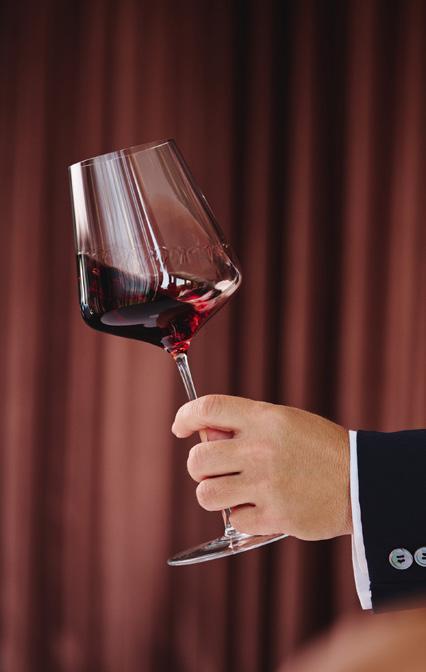
Jedes Verweilen im Meranesse fine SPA ist eine kleine Auszeit, ein Urlaub im Urlaub. Lassen Sie sich in stilvollem Ambiente verwöhnen, mit individuellen Behandlungen für Schönheit und Wohlbefinden. Im großzügigen Wellnessbereich entspannen Sie in vielen verschiedenen Saunen und Dampfbädern. Genießen Sie zudem Erlebnisduschen, Fußbäder und das Kneippbecken und lassen Sie zum Abschluss im großen Ruheraum den Ausblick vom Meraner Tal bis hoch zu den Bergspitzen auf sich wirken.
Highlight: ProFacial
ProFacial ist eine innovative All-in-one-Gesichtspflege zur natürlichen Hautverjüngung und Straffung. Der ganzheitliche Ansatz nutzt dafür modernste Technologie und die perfekte Synergie vier elementarer Anwendungen:
Aqua-Peeling: Eine sanfte Tiefenreinigung löst die Verhornung der Haut und ein erfrischtes und ebenmäßiges Hautbild wird erreicht.
Radiofrequenz: Die Stimulation steigert die natürliche Produktion von Kollagen und Elastin. Dadurch wird die Haut gestrafft und gefestigt.
Ionto-Lifting: Leichte, schmerzlose Ströme werden genutzt, um das Hautgewebe weiter zu straffen und die Gesichtsmuskulatur zu stimulieren.
Ultraschall: Ultraschallwellen helfen zum einen, die Fettzellen abzubauen, und machen die Haut zum anderen sehr aufnahmefähig für die einzuschleusenden Wirkstoffe.
Buchen Sie dieses neue Erlebnis im Meranesse fine SPA – Ruf-Nr. 270
80 MIN. | € 214 ODER 110 MIN. | € 278

Durante la vacanza, dedicarsi del tempo nella Meranesse fine SPA è un’esperienza nell’esperienza. Lasciatevi, dunque, coccolare con trattamenti wellness e beauty personalizzati in un ambiente elegante. Nell’ ampia area benessere, inoltre, sono presenti diverse saune e bagni turchi dove potrete rigenerarvi. Non mancano anche docce emozionali, pediluvi, una vasca con percorso Kneipp e, per finire, una sala relax con magnifica vista sul Meranese e sulle vette circostanti.
ProFacial è un innovativo trattamento al viso all-in-one per il ringiovanimento e il rassodamento naturale della pelle. L’approccio olistico si avvale di una tecnologia all’avanguardia e della perfetta sinergia di quattro trattamenti esclusivi.
Aqua-Peeling: una delicata pulizia profonda scioglie la cheratinizzazione della pelle, ottenendo una grana della pelle rinfrescata e uniforme. Radiofrequenza: la stimolazione aumenta la produzione naturale di collagene ed elastina, rassodando la pelle.
Ionto-Lifting: mediante correnti leggere e indolori si va a tonificare ulteriormente il tessuto cutaneo e stimolare i muscoli facciali.
Ultrasuoni: le onde ultrasonore aiutano a rompere le cellule di grasso e rendono la pelle molto ricettiva ai principi attivi da introdurre.
Prenotate questa nuova esperienza telefonando al numero interno 270.
80 MIN. | € 214 OPPURE 110 MIN. | € 278


PRESS LAW RESPONSIBLE
EDITOR IN CHIEF
Christiane Weinhold
EDITORIAL BOARD
AUTHORS
Martina Bocek, Sara Musci, Sara Penasa, Linda Pizzini, Giancarlo Soriano, Christiane Weinhold, Katharina Weiss
TRANSLATIONS
Sharla Ault, Martina Bocek, Iman Joy El Shami-Mader, Sara Musci, Sara Penasa, Linda Pizzini, Katharina Weiss
PROJECT LEAD
Lisa Härtel
DESIGN
Georg Mayr
PRINTING HOUSE
Fotolito Varesco, Auer/Ora
PUBLISHER
Tourismus Team GmbH
Industriezone | Zona Industriale 1-5
I-39011 Lana • T +39 0473 560056 info@tt-consulting.com • www.tt-consulting.com www.welcomemagazin.it
Eintragung beim Landesgericht Bozen
Registrazione al Tribunale di Bolzano
Regsitration with the district court of Bolzano Nr. 738/2017 vom 23.02.2017

HEAD OF SALES
Delia Müller
T. +39 348 3167202 mueller@tt-consulting.com

SALES MANAGER
Tanja Götsch
T. +39 0473 475043
tanja.goetsch@tt-consulting.com

SALES MANAGER
Alexander Hütter
T. +39 340 6985030
alexander.huetter@gmail.com

SALES MANAGER
Daniel Schnitzer
T. +39 351 3305671
daniel.schnitzer@tt-consulting.com
PHOTOS
Cover: Harald Wisthaler
Editorial Content
Simon Gietl: Sara Penasa, TV Ahrntal/Filippo Galuzzi, TV Ahrntal/Alfred Stolzlechner, Harald Wisthaler | Straßenkünstler: Claudio Spinelli, Andrea Rizza, Andrea Savio, Axel Hebenstreit, RTL/Stefan Gregorowius, Anna Vercellotti | Outdoor: TV Innichen/Paolo Martelli, FC Südtirol, www.unsplash.com/Tom Podmore, www.unsplash.com/Stephan Louis, Foto Press Arigossi, Harald Wisthaler, TV Gröden, Stefano Orsini | Heilwasser: Deferegger Heilwasser, TVB Osttirol/Peter Maier, TVB Osttirol/Mathäus Gartner | Supervulkan: www.unsplash.com/ Jelle de Gier, Corrado Morelli, Naturmuseum Südtirol, Armin Torggler, Naturmuseum Südtirol/Benno Baumgarten | Penaud: Robert Adler, Felix Trientbacher | Column: www.unsplash.com/ Benoit Terrier | Design: Augustin Ochsenreiter, Digitalmovie, Tommaso Riva, Alberto Parise, Draw Studio
Destinations Merano & environs: Hannes Niederkofler, Gfrill: www.unsplash.com/Bailey Mahon, Tappeinerweg: IDM/Marion Lafogler | Bolzano & environs: Helmuth Rier, Bolzanodanza/Parker, Eppan Tourismus/Marion Lafogler | Venosta Valley: IDM/ Frieder Blickle, Erlebnispark Naturns, Panzersperren: Ferienregion Reschenpass/Evelin Thöni | Pusteria Valley-Badia Valley: TV Bruneck/Harald Wisthaler, Fischen: TV B Kronplatz/Manuel Kottersteger, Lavaredo Ultra Trail: The Adventure Bakery | Bressanone & environs: Brixen Tourismus/Manuel Kottersteger, Apfelgarten Raas: Tourismusgenossenschaft Natz-Schabs/ Andreas Tauber, Villanderer Berg: TV Klausen/Rene Gruber | Gardena Valley/Alpe di Siusi: TV Val Gardena, Col del Glam: Val Gardena/Harald Wisthaler, Golf: Upscale | Three Peaks-Alta Val Pusteria: TV Sexten/Harald Wisthaler, Kartoffelfest: Niederdorfer Kartoffelfest/konistudios, Stoneman Dolomiti Bike Trail | Upper Isarco Valley: TV Ratschings-Jaufen/Manuel Kottersteger, Town hall Vipiteno: Tourismusgenossenschaft Sterzing Pfitsch Freienfeld / 99tales, Hühnerspiel: Guus R
PR
Clarissakork: Nussbaumer Photography, Marcel A. Mayer Photographer | Durst: Durst Group | Edelschwarz/Lobis: Nadin Carli | Kellerei Meran: Upscale, Franziska Raffl Steiner | Kurverwaltung Meran: IDM/Andreas Mierswa | Lamafer |Merano Winefestival: Federico Testa | Pur Südtirol | Signa: Georg Tappeiner | SKS: Günther Pichler | Spinnradl: Benjamin Pfitscher | Tiroler Goldschmied: Foto Prossliner | Gärten von Schloss Trauttmansdorff: Marion Lafogler, Alexander Pichler, Karlheinz Sollbauer | TV Klausen: Helmuth Rier, Tobias Kaser Photography, Thomas Rötting | TG Naturns: TG Naturns/Stefan Gorfer
Personalised Editions
Castel: Michael Königshofer, IDM/Alex Filz, IDM/Frieder Blickle, IDM/Marion Lafogler | Durst: Durst Group | Garberhof: Marian Mertez, Alex Filz, Nicoló dalle Mole, IDM/Benjamin Pfitscher, IDM/Armin Terzer, Vinschgau Marketing/Kirsten-J. Sörries | Gnaid: Günther Pichler, Alex Filz, Gerhard Wolkersdorfer, IDM/Alex Filz, Daniel Geiger | Innerleiterhof: Marion Lafogler | La Maiena: Brandnamic (Belvita Leading Wellnesshotels Südtirol), Armin Terzer, Florian Andergassen, Alex Filz, IDM Südtirol/Patrick Schwienbacher | Tiroler Goldschmied: Foto Prossliner, Diamond Group, Tamara Comolli | Villa Eden: Daniele Paternoster | Vinea: Hannes Niederkofler

14
FASHION TRENDS & STYLE

32
CULTURE SOUTH TYROL'S FAMOUS STREET PERFORMERS

52

COVER STORY ON A HIKE WITH MOUNTAINEER SIMON GIETL 22

40 OUTDOOR SPORTS EVENTS TO CHEER AT
NATURE THE THERMAL WATER OF DEFEREGGEN VALLEY



60
HISTORY THE BOLZANO SUPERVOLCANO

76 COLUMN MY SOUTH TYROL

106

68
HANDICRAFT CHEESE MAKING AT PENAUD HUT

78 DESIGN MASTERPIECES BY LUCA MARTORANO
DESTINATION INSIDER TIPS

 Georg Kaser, South Tyrolean Actor
Georg Kaser, South Tyrolean Actor
 Patrizia Solaro, South Tyrolean Actress
Patrizia Solaro, South Tyrolean Actress

Was ist gerade en vogue, wie falle ich auf und wo finde ich die beste Beratung? Was Südtirol derzeit modisch bewegt, finden Sie auf den kommenden Seiten …
Quali sono le tendenze in voga? Come farsi notare? Dove ricevere i consigli migliori? Leggete le prossime pagine e scoprite tutte le ultime novità nella moda altoatesina…
What’s trendy right now? How can I get noticed? Where can I get the best tips? Get the scoop on the South Tyrolean fashion scene on the next few pages…


Exklusiv für Welcome präsentiert Mode-Expertin Nadia Tschenett die aktuellen Trends der internationalen Runways. Nach sechs Jahren im Fashionressort der deutschen Elle leitete die gebürtige Meranerin als Unit-Director von Loews, der führenden deutschen PR-Agentur im High-Fashion-Business, die Mode-Etats von Burberry und Jil Sander. Seit ihrer Rückkehr nach Südtirol berät sie größere und kleinere Kunden rund um das Thema Mode. Hauptaugenmerk legt sie dabei auf die Organisation von Events, Styling und die Umsetzung von professionellen Fotoshootings.
L’esperta di moda Nadia Tschenett presenta, in esclusiva per Welcome, i trend attuali che dominano le passerelle internazionali. Dopo sei anni nella sezione fashion del magazine tedesco Elle, la meranese ha lavorato presso Loews, agenzia di PR leader nel business dell’alta moda in Germania. In
veste di Unit Director, dirigeva il reparto dedicato a Burberry e Jil Sander. Dal suo ritorno in Alto Adige, Nadia è attiva come consulente di moda per svariate tipologie di clienti. L’organizzazione di eventi, la cura dello styling e la realizzazione di shooting fotografici professionali sono i focus della sua attività.
As a Welcome exclusive, Nadia Tschenett will present current trends directly from the international runways. After six years in the fashion department of the German Elle magazine, the Merano native has been working at Loews, the leading PR agency in the haute couture business in Germany. As Unit Director, she headed the fashion budget of Burberry and Jil Sander. Since her return to South Tyrol, Nadia has been working as a consultant to bigger and smaller clients in the fashion world. Her activity focusses on the organization of events, styling and the creation of professional photo shoots.
FASHION TRENDS




Bereiten Sie sich auf eine lebendige Frühjahr/Sommer-Saison 2024 vor, denn die Farbe Gelb rückt ins Zentrum der Aufmerksamkeit. Mit den längeren Tagen und wärmerem Wetter wird dieser sonnige Farbton omnipräsent sein – sei es auf den Laufstegen der Modewelt oder in den pulsierenden Straßen der Stadt. Gelb wird unsere Garderoben mit einem Hauch von Optimismus und Lebendigkeit durchfluten. Machen Sie sich bereit für luftige Sommerkleider, fröhliche Accessoires oder auffällige Kleidungsstücke in diesem strahlenden Farbspektrum. Lassen Sie diesen Trend geschmackvoll in Ihren Stil einfließen und drücken Sie Positivität aus, während Sie die Essenz einer sonnigen Saison in vollen Zügen genießen.






Get ready for a burst of energy in Spring/Summer 2024: yellow takes centre stage. With the days getting longer and the weather getting warmer, this sunny hue will be omnipresent – both on the runways of the fashion world and the vibrant streets of the city. Yellow will infuse our wardrobes with a touch of optimism and liveliness. Fill your closet with flowy summer dresses, cheerful accessories, or striking garments in this radiant hue. Let this trend seamlessly blend into your own style and exude positivity while savouring the true spirit of the sunny season.

Questa primavera-estate preparatevi a fare il pieno di vitalità, perché il colore protagonista è il giallo. Con le belle giornate via via più lunghe, e anche più calde, tale tonalità conquista la scena, sia sulle passerelle che per le vie della città. Risalta già solo nel guardaroba, infondendo ottimismo e vivacità. Accogliete, dunque, questo trend in tutto e per tutto, indossando un vestito leggero, un accessorio sbarazzino o altri capi unici. E lasciate che il vostro outfit rifletta la solarità e la positività, tipiche di stagione.






Die Modewelt wird im Frühjahr/ Sommer 2024 von Shorts im Sturm erobert. Sie vereinen Eleganz und Bequemlichkeit und bieten eine facettenreiche Auswahl für jede erdenkliche Gelegenheit. Mit einer breiten Palette an Stilen, Farben und verspielten Mustern können Sie Ihren eigenen einzigartigen Look kreieren. Ganz gleich, ob Sie einen Tag am Strand verweilen oder an einem exklusiven Event teilnehmen, Shorts repräsentieren die ultimative Wahl und sind ein unverzichtbares Must-have für diese Saison.


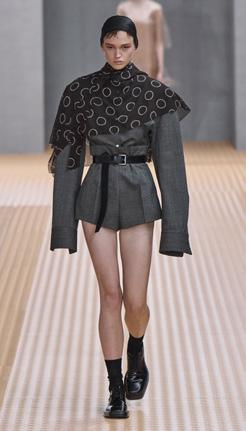
Nei mesi caldi dell’anno il mondo della moda impazza per gli short. Oltre a essere pratici e comodi, si prestano benissimo anche a vari tipi di occasioni, persino le più eleganti. Inoltre, variando nello stile, nei colori e nei motivi, permettono a tutte di creare l’outfit che meglio rispecchia il proprio stile. Che vi troviate al mare o a un evento esclusivo, dunque, quest’estate con i pantaloncini sarete trendy un po’ ovunque.

The fashion scene is set to be conquered by shorts in Spring/Summer 2024. They combine elegance and comfort while offering a diverse selection for every conceivable occasion. With a wide range of styles, colours, and playful patterns to choose from, you can create your own unique look. Whether for lounging at the beach or attending an exclusive event: shorts are the ultimate choice. They are an indispensable must-have this season.
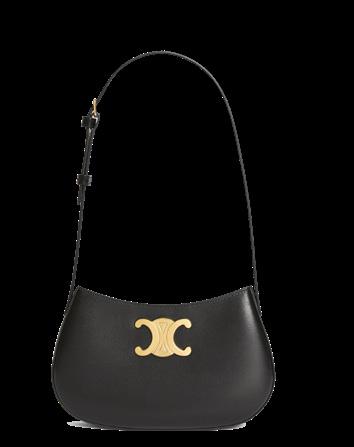

 LA PREZIOSA
TIROLER GOLDSCHMIED
GUCCI
JIL SANDER
PRADA
LA PREZIOSA
TIROLER GOLDSCHMIED
GUCCI
JIL SANDER
PRADA





Im Frühjahr/Sommer 2024 steht die Mode im Zeichen zeitloser Weiblichkeit. Sie lädt dazu ein, die Schönheit schlichter Eleganz zu zelebrieren. Egal, ob Sie sich auf einem Gartenfest befinden oder eine Tasse Tee in einem Café genießen – dieser Trend wird Ihrem Kleiderschrank eine Prise zeitloser Raffinesse verleihen. Er unterstreicht die Kunst des stilvollen Ankleidens und präsentiert einen erfrischenden sowie anspruchsvollen Zugang zur warmen Jahreszeit.


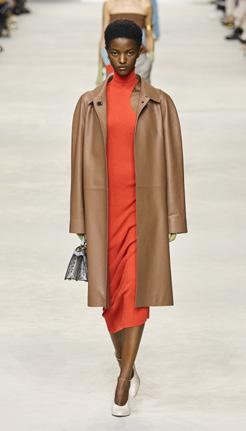
In Spring/Summer 2024, the fashion scene is characterised by timeless femininity. It is an invitation to celebrate the beauty of simple elegance. Whether at a garden party or while enjoying a cup of tea at a café, this trend lends your wardrobe a subtle touch of timeless sophistication. It highlights the art of dressing in style and offers a refreshing and refinded look for the warm season.

Un omaggio alla femminilità senza tempo così come alla bellezza semplice e raffinata. Che siate invitate a una festa in giardino o per un tè al bar, prediligete un look sobrio e sofisticato allo stesso tempo, e farete una bella e intramontabile figura. Inoltre, mostrerete di avere gusto nello scegliere capi freschi, che sappiano andare incontro alle esigenze della stagione calda senza rinunciare allo stile.

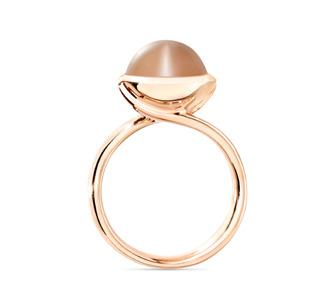 STELLA MCCARTNEY
FENDI
FOPE TIROLER GOLDSCHMIED
CALCATERRA
STELLA MCCARTNEY
FENDI
FOPE TIROLER GOLDSCHMIED
CALCATERRA










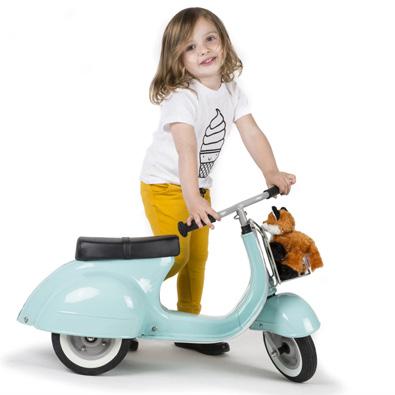
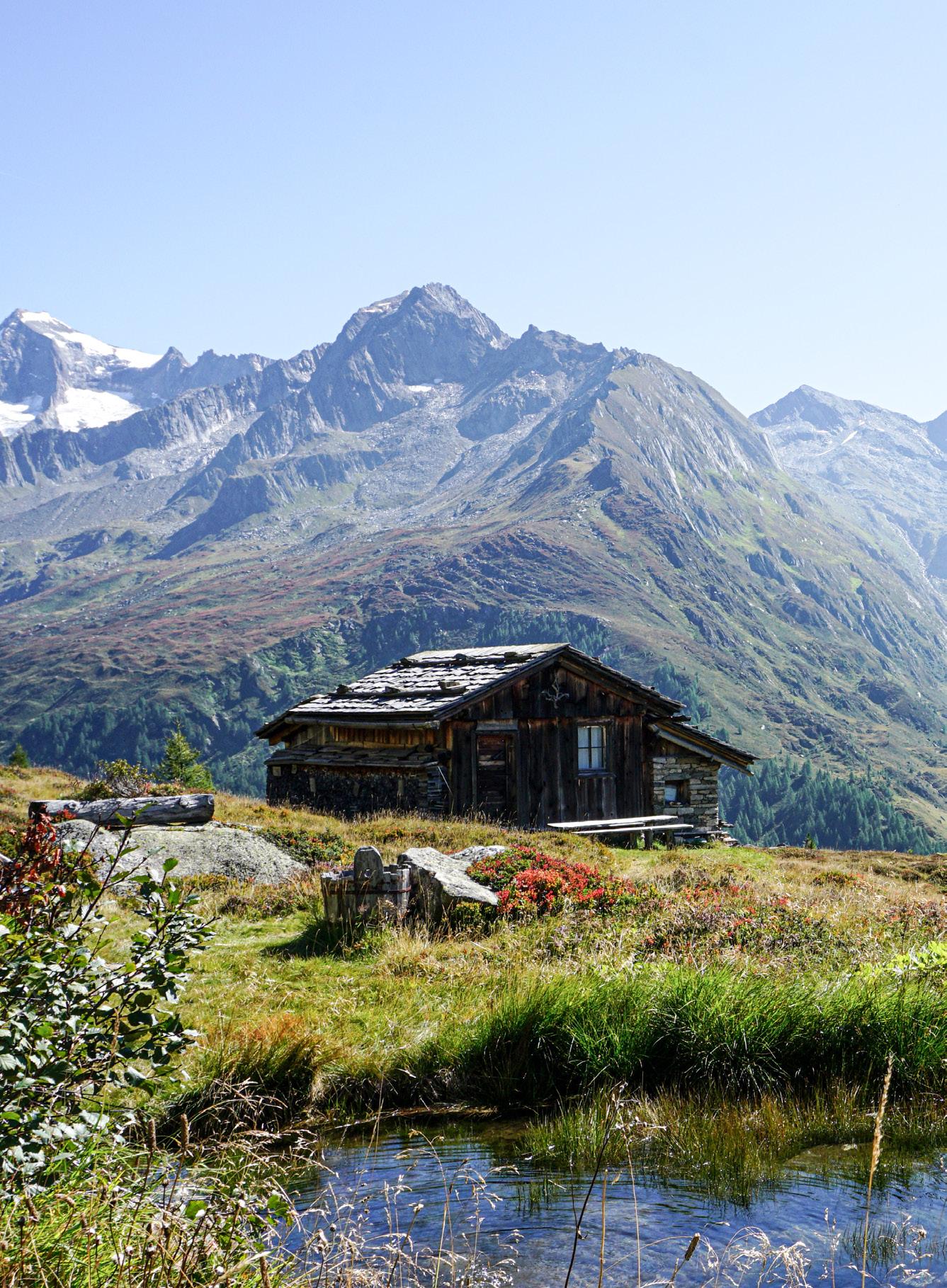
Wir alle brauchen eine tägliche Dosis Schönheit und Herzlichkeit, denn dadurch wird die Welt zu einem besseren Ort. Im Rahmen einer Wanderung mit Alpinist Simon Gietl, die uns im Anblick von Almen und den Dreitausendern des Ahrntals zum Biotop Wieser Werfer führte, gab es von beiden mehr als genug. Ein Bericht über einen dieser Tage, die einfach guttun.
Tutti abbiamo bisogno di una dose quotidiana di meraviglia e gentilezza, qualità preziose che rendono il mondo un posto migliore. Durante l’escursione in compagnia dell’alpini-

sta Simon Gietl al biotopo Wieser Werfer, tra le malghe e i tremila della Valle Aurina, ve n’è stato di entrambe in abbondanza – per una di quelle giornate che fanno semplicemente bene al cuore.
We all need a daily dose of wonder and kindness, precious qualities that make the world a better place. During the hike to the Wieser Werfer biotope with mountaineer Simon Gietl, between the alpine pastures and three-thousand-metre mountains of the Aurina Valley, there was plenty of both – it was one of those days that are simply good for the heart.
Beim Wandern erzählt
Simon Gietl von sich selbst, aber hört auch gerne den anderen zu.
Camminando, Simon Gietl racconta di sé, ma si interessa anche dei compagni di escursione.
While walking, Simon Gietl talks about himself, but is also interested in his fellow hikers.

„Hoi, i bin dr Simon.“ So lauten die ersten Worte, mit denen sich Gietl im Südtiroler Dialekt vorstellt. Sie zeugen von überraschender Nahbarkeit, schließlich hat er als Bergführerlegende bereits zahlreiche Zeitungsberichte gefüllt. Er reicht allen Teilnehmenden der Erlebniswanderung die Hand und eines wird sofort klar: Er fühlt sich nicht wie ein besonderer Wanderer, sondern wie einer von uns. Mit seinem herzlichen Lachen steckt er die ganze Wandergruppe in wenigen Sekunden an. Bereits der klare Septemberhimmel und die Sonne sahen vielversprechend aus, nun aber garantiert die gute Laune einen unvergesslichen Tag in den Bergen.
Los geht die Rundwanderung in Kasern im weitverzweigten Prettau, das nicht nur die nördlichste Gemeinde Italiens ist, sondern noch einen weiteren Rekord hält: Die letzten Häuser des Ahrntals liegen an der Grenze zu Österreich am Fuße des Klockerkarkopfs, dem nördlichsten Punkt des Landes. Der Weg führt uns sofort in den Wald hinein. Die Sonnenstrahlen tauchen die Fichten und Lärchen in goldenes Licht und lassen uns die Jacken abstreifen. Dank der mäßigen Steigung kommen wir gemütlich miteinander ins Gespräch und können die eine oder andere Frage stellen, die
uns bei einer Wanderung mit Simon Gietl sofort auf der Zunge brennt. Bescheiden beginnt er von seinen beeindruckendsten Alpengipfelabenteuern zu erzählen und lässt so manche lustige Anekdote einfließen. Er klingt nicht wie einer, der sich zur Schau stellen möchte, eher wie ein alter Schulfreund, der scherzend von seinen Erlebnissen der letzten Jahre berichtet. „Einmal habe ich mit einem guten Freund innerhalb von 48 Stunden die Nordwand des Ortlers, die kleinste der Drei Zinnen und die Nordwand des Großglockners in Österreich bestiegen, wobei wir uns nur mit dem Fahrrad von einem zum anderen Berg begeben haben. Dabei habe ich viel über meine körperlichen Grenzen gelernt. Es ist unglaublich, wie stark sich Schlafmangel auf Energie und Psyche auswirkt. Die zweite schlaflose Nacht war besonders hart: Beim Fahrradfahren habe ich irgendwann sogar die Brille abgenommen, in der Hoffnung, dass mich der Wind wachhält“, erinnert sich Gietl und fügt lachend hinzu: „Ich muss allerdings erwähnen, dass ich am Tag vor der Tour bis spät in die Nacht meine Hochzeit gefeiert habe. Zum Glück war mein Freund auch unter den Gästen, so dass wir beide darunter gelitten haben.“ Grinsend berichtet Simon, dass er erstmal genug von Touren auf zwei Rädern hatte, doch in Folge dieser Leistung ist nach einer wohlverdienten mehrjährigen Pause das ehrgeizige Projekt „North 6“
geboren. Die Mission: innerhalb drei Wochen die sechs höchsten Nordwände der Alpen bezwingen, wobei nur „traditionelle Transportmittel“ verwendet werden dürfen, sprich die eigenen Füße, das Fahrrad, der Gleitschirm und die Skier. „Man muss sich selbst ein strenger Schiedsrichter sein und seine Grenzen festlegen. Ein Projekt entwickelt erst dann seinen Reiz, wenn du dir denkst: Das ist unmöglich.“
Als die Bäume lichter werden, öffnet sich der Blick auf die Starklalm: Auf einigen Weiden grasen Kühe begleitet vom klassischen Klingen ihrer Glocken; andere hingegen zeigen sich in klassisch gemähter Form in hellem und dunklem Grün. Hier riecht es vor allem nach Alpenrosen, die üppig zwischen Heidelbeersträuchern gedeihen. Die Finger färben sich blau, als wir die Heidelbeeren pflücken, deren Süße sich mit einer abschließenden Säurenote am Gaumen ausbreitet. Der Blick auf die Landschaft und die Gespräche mit Simon begleiten uns auf dem Weg zum Biotop Wieser Werfer, das vom natürlichen Lauf des Rauchkofelbachs geprägt ist. Der Bach entspringt – wie der Name verrät – hoch oben am Rauchkofel. Mit seinem unglaublich klaren Wasser schlängelt er sich friedlich dahin und gleicht einem

Hinter der Kapelle befindet sich der „Schliefstein“, der angeblich als Mittel der Buße dient: Wer sich durch den Spalt zwischen Kirche und Felsen begibt, der streift all seine Sünden an den Wänden ab.
Nel masso dietro la cappella vi è una spaccatura, usata secondo la credenza come strumento di espiazione: chi vi passa attraverso, lascia sulla parete rocciosa i propri peccati, liberandosene.
There is a crack in the boulder behind the chapel: those who pass through it are said to relinquish their sins onto the rock, thus freeing themselves from their burdens.
idyllischen Gemälde. Da zeigt sich mal wieder, dass die Natur eine talentierte Künstlerin ist. Nachdem wir außerhalb des Schutzgebiets spontan die Füße ins kristallklare Wasser getaucht und somit unseren eigenen Kneippparcours entwickelt haben, setzen wir unsere Wanderung fort. Die einfache Schotterstraße erlaubt es, von Zeit zu Zeit den Blick zu heben und zur Dreiherrnspitze direkt vor uns hochzuschauen. Der Schnee dort oben beweist, dass es sich bei der Riesenfernergruppe um den Naturpark mit den meisten Gletschern in Südtirol handelt. Blubb blubb … Plötzlich vernehmen wir ein leises Gurgeln und während wir nach dessen Ursprung suchen, eröffnet sich uns ein malerischer Anblick, vergleichbar mit einem typischen Desktophintergrundbild: eine Almhütte mit Schindeldach, umgeben von sattgrünem Gras und mächtigen Dreitausendern. Vor der Holzhütte liegt ein kleiner Teich, von dessen Tiefen unaufhörlich Luftblasen nach oben steigen – des Rätsels Lösung und wunderschön anzusehen. Bei der Tauernalm ist es Zeit für eine regenerierende Pause. Von Brennessel- über Pressknödel (auch „Pressa“ genannt) bis zum Graukäse aus Eigenproduktion und dem obligatorischen Apfelstrudel: Hier hat man die Qual der Wahl. Was man unbedingt probieren sollte, ist der hausgemachte nach Cola schmeckende Sirup aus der Heilpflanze Eberraute.
Zwischen Natur und Natürlichkeit
Wir nähern uns dem Tal über einen breiten gepflasterten Serpentinenweg, der einst dem Transport von Schmuggelware zur Krimmler Tauern diente. Die Atmosphäre ist heiter; Simon erzählt Geschichten, macht Witze und interessiert sich für das Leben der Teilnehmenden, was von seiner großen Bescheidenheit zeugt. „Wenn ich meine Begleitung für Alpenexpeditionen auswähle, dann achte ich dabei nicht nur auf Expertise, sondern höre auch auf mein Gefühl. Ich würde nie mit Menschen in die Berge gehen, mit denen ich nicht auch ein Bier trinken würde. Das Leben ist viel zu kurz, um es mit Dingen zu verbringen, die uns nicht gefallen. Zuhause versuche ich die Zeit intensiv mit meiner Familie zu nutzen. Ich erzähle nicht gerne von meinen Abenteuern, lieber bin ich ganz und gar Ehemann und Papa.“ Bevor wir zum Parkplatz in Kasern zurückkehren, machen wir noch einen Abstecher zur malerischen Heilig-Geist-Kirche, einem bekannten Wallfahrtsort. Hier wird das Herz mit Dankbarkeit erfüllt, was vielleicht daran liegt, dass dieser Ort dank der reichhaltigen Vorkommnisse an Wasser und Bergkristall als energetisch besonders wertvoll gilt, vielleicht aber auch an den friedlich grasenden Pinzgauer-Kühen oder den imposanten Gipfeln, die

sich in den wolkenlosen Himmel erheben. Vielleicht sind aber auch die ausgelassene Stimmung und die Menschen der Grund dafür. Auch Simon Gietl strahlt mit seiner Lebensart tiefe Zufriedenheit aus – die Zufriedenheit derjenigen, die jeden Tag ihrer Leidenschaft nachgehen können. „Dieses Glück wünsche ich allen, egal ob es sich dabei um Bergsteigen, Holzschnitzerei, Landwirtschaft oder etwas anderes handelt“, sagt er mit klarem Blick. Anschließend erzählt er noch eine kleine Anekdote: „Einmal fragte mein Sohn, warum ich in die Berge gehe. Ich wusste nicht, wie ich es ihm erklären sollte, also nahm ich ihn mit. Auf dem Gipfel aßen wir in Ruhe ein belegtes Brot und atmeten die frische Luft tief ein. Wir haben sonst nichts ‚Besonderes‘ gemacht. Zuhause sagte er dann zu mir: ‚Papa, wann gehen wir wieder auf den Berg?‘ Und da hab’ ich gesagt: ‚Jetzt hast du die Antwort, nach der du gesucht hast.‘“ Das sind wahre Worte, besonders für jemanden, der die Berge liebt. Worte, die uns ihrerseits verstummen lassen, uns die Schönheit der Umgebung vor Augen führen und uns das Gemeinschaftsgefühl spüren lassen, das man hoch oben in den Bergen erlebt. Schönheit und Herzlichkeit machen aus der Welt in der Tat einen besseren Ort.
“Hoi, i bin dr Simon.” Ovvero: Ehi, ciao, sono il Simon. Queste le primissime parole pronunciate in dialetto altoatesino da Gietl, con una genuinità non scontata per una leggenda dell’alpinismo finita su svariati giornali. Stringe la mano a ogni singolo partecipante all’escursione guidata in sua compagnia ed è subito chiaro: lui non è uno special guest, è uno di noi. In pochi secondi la sua risata accorata contagia l’intera comitiva e, se già il limpido cielo settembrino e il sole splendente promettevano bene, ora anche l’umore preannuncia una giornata in montagna assolutamente memorabile.
Il punto di partenza del tour ad anello è la località Casere, nel comune sparso di Predoi, il più a nord dello Stivale. Non è l’unico record: le ultime case della Valle Aurina sono sovrastate dalla Vetta Italia, che è considerata il punto più settentrionale della nazione, sul confine con l’Austria. Il sentiero si addentra subito nel bosco; i dorati raggi del sole filtrano attraverso gli aghi degli abeti rossi e dei larici, convincendo a togliere la giacchetta

Wenn man nach dem Biotop dem Wanderweg 15A folgt, gelangt man zum Waldnersee.
Continuando a salire dopo il biotopo lungo il segnavia 15A, si arriverebbe al Lago della Selva.
If you continue to hike after the biotope along trail sign 15A, you will arrive at Lago della Selva.
co era tra gli invitati, per cui avevamo gli stessi svantaggi”. Sulla scia di questa sfida, dopo una meritata pausa di qualche anno (Simon svela sogghignando che per un po’ ne aveva abbastanza delle due ruote), è poi nato anche l’ambizioso progetto North 6: salire in successione le sei maggiori pareti nord delle Alpi in tre settimane e “con mezzi onesti”, ovvero solo a piedi, in bicicletta, in parapendio o con gli sci. “È fondamentale essere rigidi arbitri di sé stessi e stabilire dei limiti. Un progetto acquista quel fascino proibitivo solo quando cominci a pensare: ma è impossibile!”
Al biotopo Wieser Werfer
Al diradarsi degli alberi la vista si apre sugli alpeggi di Malga Starkl: alcuni prati sono pascolati da vitelle scampanellanti, mentre altri presentano le classiche righe chiaro-scure dello sfalcio. Qui, il profumo predominante è quello balsamico del rododendro, che cresce rigoglioso intervallato da piante di mirtilli, cariche di invitanti frutti maturi. Le dita si colorano di viola nello staccare le bacche, le quali conquistano il palato con un sapore dolcemente fresco e una piacevole nota acidula finale. Accompagnati da questi paesaggi e dalle allegre chiacchiere con Simon, raggiungiamo il biotopo Wieser Werfer, con le anse serpeggianti disegnate naturalmente dal Rio Rauchkofelbach, che scende dal piramidale e granitico Monte Fumo. L’acqua, di una limpi-
dezza quasi inverosimile, scivola pacifica tra le curve, tanto perfette da sembrare progettate a tavolino. Eppure, ancora una volta, la natura conferma di saperne di più rispetto agli umani. Dopo aver rinfrescato i piedi improvvisando un percorso Kneipp in una pozza cristallina formatasi spontaneamente appena oltre l’area protetta, ci rimettiamo in marcia. La comoda strada sterrata permette di distogliere di tanto in tanto gli occhi dal cammino per volgerli verso il Picco dei Tre Signori, proprio di fronte: impreziosito da lingue di neve, testimonia con fierezza il fatto che quello delle Vedrette di Ries-Aurina è il parco naturale dell’Alto Adige con il maggior numero di ghiacciai. Blub, blub… D’un tratto, si avverte un gorgoglio sommesso e, nel cercarne con lo sguardo la fonte, ci si propone un quadretto idilliaco tipo sfondo predefinito del monitor: una tipica baita in legno con tanto di tetto in scandole, cinta da erba verde saturo e maestosi tremila. Di fronte ad essa, un piccolo stagno da cui sale a galla un incessante vortice di bolle che spiega l’origine del rumore – uno spettacolo davvero singolare. Raggiunta la Malga Tauern, è tempo di una meritata pausa ristoratrice! Dai canederli di ortica o pressati – detti localmente Pressa – al formaggio grigio di produzione propria fino all’immancabile strudel di mele: le scelte gustose non mancano. Da provare: l’acqua con sciroppo fatto in casa all’assenzio abrotano, un’erba officinale con un tipico sapore di cola.
senza indugi. La pendenza dolce dell’itinerario permette di parlare tranquillamente e chiedere quelle domande che chiunque non vedrebbe l’ora di porre se si trovasse a camminare fianco a fianco con Simon Gietl. Con una modestia disarmante, lui comincia a raccontare delle sue avventure tra le vette più scenografiche dell’arco alpino – intercalate immancabilmente da qualche ilare aneddoto. Il tono non è quello di chi desidera mettersi in mostra, ma quello scherzoso di un vecchio compagno di scuola che aggiorna su cosa ha combinato negli anni. “Una volta, con un buon collega, abbiamo scalato in successione la nord dell’Ortles, la Cima piccola di Lavaredo e la nord dell’austriaco Grossglockner, spostandoci da una montagna all’altra in bicicletta – tutto in meno di quarantott'ore. Lì ho imparato molto riguardo ai limiti fisici: è pazzesco quanto la mancanza di sonno possa incidere sull’energia e sulla salute mentale. La seconda notte in bianco è stata durissima: a un certo punto, mentre pedalavo, ho addirittura tolto gli occhiali così che l’aria pungente mi tenesse sveglio”, ricorda. E aggiunge ridendo: “C’è da precisare che il giorno prima della partenza avevo festeggiato il mio matrimonio fino a tardi, ma per fortuna il mio ami-

Neben dem Apfelstrudel sollte man auf der Tauernalm auch das hausgemachte Joghurt und die Buchweizentorte probieren.
Oltre allo strudel, da provare alla Malga Tauern sono anche lo yogurt fatto in casa e la torta di grano saraceno con mirtilli rossi.
Homemade yoghurt and buckwheat cake with cranberry jam are definitely worth trying at Malga Tauern, but the strudel is the star.
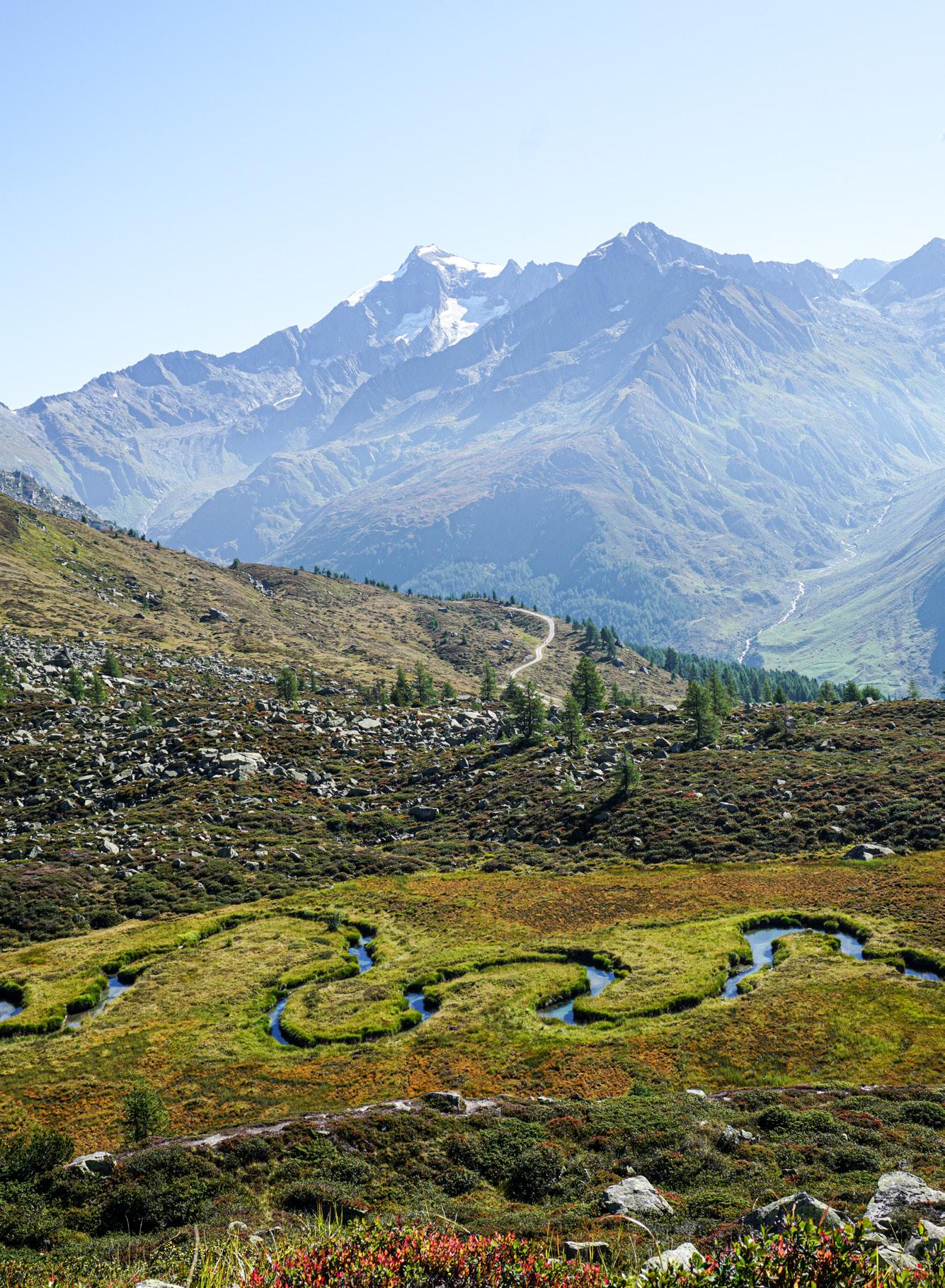
Das wunderschöne Biotop Wieser Werfer soll dem Schutz der Biodiversität am gewundenen Flusslauf und in dessen Umgebung dienen.
Il biotopo Wieser Werfer, di rara bellezza, è stato istituito per tutelare l’incredibile biodiversità che trova habitat tra i suoi meandri.
The Wieser Werfer biotope, known for its extraordinary beauty, was established to safeguard the biodiversity thriving within its borders.
Ci avviamo quindi verso valle imboccando un ampio sentiero lastricato a zig zag, usato in passato per trasportare merce di contrabbando sul Passo dei Tauri. L’atmosfera è disinvolta, con Simon che alterna racconti di sé a simpatiche battute, non mancando di dare prova della propria umiltà interessandosi sinceramente della vita dei propri compagni di escursione. “Anche per scegliere gli accompagnatori di una spedizione alpinistica, mi baso non solo sulla professionalità ma soprattutto su un buon feeling. Non andrei mai in montagna con persone, con le quali non mi berrei una birretta dopo – il tempo è troppo prezioso per sprecarlo a fare ciò che non ci va. A casa, poi, cerco di godermi intensamente la mia famiglia: preferisco non parlare delle mie avventure, ma fare semplicemente il marito e il papà.” Prima di tornare al parcheggio di Casere e concludere così la gita, ci fermiamo ad ammirare la suggestiva chiesetta di Santo Spirito, nota meta di pellegrinaggio. Sarà perché il luogo dove sorge è considerato particolarmente energetico per via dell’abbondante presenza di acqua e di cristallo di rocca, sarà per le mucche della razza locale Pinzgauer che pascolano serene tutt’intorno, sarà per le imponenti vette che si stagliano contro il cielo senza nuvole, sarà per il buon umore della compagnia… il cuo-
re si riempie di gratitudine. Ecco, Simon Gietl trasmette col suo modo di fare la stessa sensazione di appagamento, quella soddisfazione di chi sta facendo ogni giorno ciò che desidera.
“È una fortuna che auguro a tutti: che sia nello scalare cime o facendo il falegname, la contadina...”, spiega con lo sguardo trasparente. Racconta poi un ultimo episodio: “Una volta mio figlio mi chiese: perché vai in montagna? Non sapendo come spiegarglielo, lo portai con me. In vetta mangiammo un panino con calma e respirammo l’aria fresca. Nient’altro di ‘speciale’. Di ritorno a casa, lui commentò spontaneamente: papà, quando andiamo di nuovo? Fu così che replicai: ora hai la risposta che cercavi”. Parole dense di verità – specie per chi ama l’ambiente montano –, che lasciano a propria volta muti, ad ammirare la meraviglia circostante e a godersi il senso di unione che instaura l’alta quota. Sì, l’umanità e la bellezza rendono il mondo un posto migliore.
“Hoi, i bin dr Simon.” Hi there, I’m Simon. These initial words, spoken in the South Tyrolean dialect by Gietl, carry a sincerity uncommon for a mountaineering icon featured in numerous newspapers. He warmly greets each participant of the hike, not as a distinguished guest, but as one of us. In mere moments, his genuine laughter spreads through the entire group. If the promising September
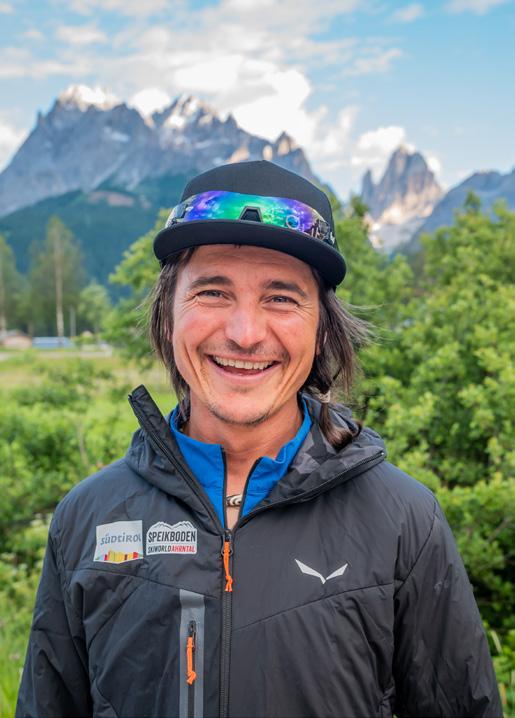
Gietls alpiner Lebenslauf ist gespickt mit herausfordernden Besteigungen, Erstbegehungen und internationalen Expeditionen.
Nel suo curriculum alpinistico, Gietl vanta ripetizioni di primordine, nuove vie e spedizioni in giro per il mondo.
Gietl's alpine resume is peppered with challenging climbs, first ascents, and international expeditions.
1984 geboren, strahlt Simon Gietl mit seinen beinahe 40 Jahren noch eine gewisse Jugendlichkeit aus, was nicht zuletzt an den zerzausten Haaren liegt, die links zu einem kleinen Zopf zusammengebunden sind. Obwohl er in Oberwielenbach im Pustertal aufwuchs, entwickelte sich seine Leidenschaft für den Bergsport erst mit 18 Jahren, als er beim Trampen zufällig einem Kletterer begegnete. Heute ist Simon Gietl Bergführer und einer der wichtigsten Vertreter des italienischen Alpinismus. Er liebt es, schwierige Touren respektvoll zu meistern sowie Berge im Alleingang zu besteigen. Zu seinen letzten größeren Projekten zählt die Überquerung von vier Dolomitengruppen, von denen er im Kurzfilm „Winter Solo“ berichtet, sowie die Eröffnung der Route „Identität“ an der Westwand des Mittleren Zwölfer in den Sextner Dolomiten.
Classe 1984, alla soglia dei quarant’anni ha ancora l’aspetto innocente di un ragazzino, con i suoi capelli scompigliati legati sulla sinistra in una treccina frettolosa. Nonostante sia originario del paesino di montagna Vila di Sopra, in Val Pusteria, si avvicina seriamente al mondo verticale solo all’età di diciotto anni, grazie a un incontro casuale con uno scalatore facendo l’autostop. Oggi è guida alpina e uno dei maggiori esponenti dell’alpinismo italiano, amante degli itinerari difficili da superare con uno stile pulito e delle ascensioni in solitaria. Tra i suoi ultimi progetti più importanti figurano le traversate integrali di quattro gruppi dolomitici raccontate in WinterSoloe l’apertura della via Identität sulla Cima di Mezzo della Croda dei Toni, nelle Dolomiti di Sesto.
Born in 1984, just shy of forty, Simon Gietl maintains the innocent look of a young boy, his unruly hair hastily braided to the left. Although hailing from the mountain village of Vila di Sopra in the Pusteria Valley, his foray into the vertical realm commenced at 18, spurred by a chance encounter with a climber while hitchhiking. Today he is a mountain guide and a prominent figure in Italian mountaineering, renowned for his love for challenging routes approached with a clean style and solo ascents. Among his most important recent projects are complete traverses of four Dolomite groups chronicled in “Winter Solo” and the establishment of the “Identität” route on the Cima di Mezzo of the Croda dei Toni, in the Sesto Dolomites.
sky and bright sun hinted at a great day in the mountains, now the atmosphere guarantees an unforgettable experience.
The starting point of the circular tour is the locality of Casere, in the municipality of Predoi, the northernmost of the country. It is a special place: the last houses of the Aurina Valley are dominated by the Vetta Italia peak, at the very top of the peninsula, on the border with Austria. The path immediately enters the woods; the golden rays of sun filter through the spruce and larch trees, convincing us to take off our jackets without hesitation. The gentle slope of the itinerary allows for easy conversation and to pose the questions that invariably arise when walking alongside a character like Simon Gietl. With disarming modesty, he begins to tell of his adventures among the most scenic peaks of the Alps –regularly interspersed with some hilarious anecdote. The tone is not that of a show-off, but the joking air of an old schoolmate updating us on what he has been doing over the years. “Once, with a good friend, we climbed the northern Ortles, the Cima Piccola di Lavaredo and the northern Austrian Grossglockner in succession, moving from one mountain to another by bicycle – all in less than 48 hours. I learned a lot about physical limitations there: it’s crazy how much lack of sleep can impact your energy and mental health. The second sleepless night was very hard: at a certain point, while I was pedalling, I even took off my glasses so that the crisp air would keep me awake,” he recalls. Laughingly, he adds: “You should know that the day before departure I had celebrated my wedding until quite late, but luckily my friend was among the guests, so we had the same disadvantages.” In the wake of this challenge, after a well-deserved break of a few years (Simon smiles, revealing
Außerhalb des Schutzgebiets kann man die Füße ins kühle Wasser tauchen: welch eine Wohltat für den Kreislauf!
Oltre l’area protetta, è possibile immergere i piedi nell’acqua fresca: un toccasana per la circolazione!
Beyond the protected area, you can immerse your feet in the cool water: a panacea for the circulation!
that for a while he had had enough of bikes), the ambitious North 6 project was born. It consists of climbing the six major north faces of the Alps in three weeks and “with honest means”, i.e. only on foot, by bicycle, by paragliding or on skis. “It is essential to be strict arbiters of yourself and to set limits. A project acquires that prohibitive charm only when you start thinking: but it’s impossible!”
As the trees start to thin out, revealing the expanse of Malga Stark’s alpine pastures, veal calves graze on some of the fields, while others display the classic light-dark stripes of mowing. Here, the predominant scent is the balsamic fragrance of rhododendron, blooming among blueberry bushes laden with tempting ripe fruits. Our fingers turn purple as we pluck the berries, which delight the palate with a sweetly fresh flavour and a pleasant tart finish. Amid these landscapes and the lively conversation with Simon, we reach the Wieser Werfer biotope, with its winding loops naturally carved by the Rauchkofelbach stream, flowing from the pyramidal and stony Monte Fumo. The water flows serenely, its clarity almost unbelievable, meandering through the bends with such precision that one might think it was meticulously planned. However, once again, nature confirms its superiority over humans. After rejuvenating our feet with an impromptu Kneipp therapy in the spontaneously formed crystalline pool just beyond the protected area, we resume our journey. The smooth dirt path allows occasional glances away from the trail towards the magnificent Picco dei Tre Signori ahead: adorned with a layer of snow, it proudly signifies that Vedrette di Ries-Aurina is the South Tyrolean nature park with the most glaciers. Blub, blub... Suddenly, a soft gurgling catches our attention, and as we seek its

source, we’re struck by an idyllic scene reminiscent of a computer background: a quaint wooden cabin with a shingled roof, nestled amid lush green grass and towering peaks. In front of it lies a small pond, its surface adorned with a continuous swirl of bubbles, revealing the source of the sound – a truly remarkable spectacle. Once we reach the Tauern hut, it’s time for a well-deserved refreshment break! From nettle or pressed dumplings – locally called Pressa – to homemade grey cheese and the classic apple strudel: there is no shortage of tasty choices. A must try: water with syrup made from southern wormwood, a medicinal herb with a typical cola flavour.
We proceed towards the valley along a broad zigzag paved route, historically used for smuggling, across the Tauern Pass. The ambiance is relaxed, with Simon interweaving anecdotes about himself with humorous quips, all while displaying genuine interest in the lives of his fellow hikers. “Even in assembling a team for an expedition, I prioritise camaraderie over expertise. I wouldn’t venture into the mountains with anyone I couldn’t share a beer with afterwards – time is too precious to be spent on activities that lack genuine enjoyment. And at home, I cherish moments with my family: rather than recounting adventures, I simply enjoy being a husband and father.” Before concluding our journey and returning to the Casere car park, we pause to admire the captivating Holy Spirit church, renowned as a pilgrimage site. Whether it’s the area’s famed energetic qualities stemming from abundant water and rock crystal, the tranquil presence of local cows of the Pinzgauer breed grazing nearby, the majestic peaks towering against a cloudless sky, or simply the cheerful company... gratitude fills the heart. Here, Simon Gietl exudes a sense of profound satisfaction, reflecting the joy of following his passions daily.
“It’s a blessing I wish upon everyone, whether it’s scaling peaks or pursuing other trades like carpentry or farming,” he shares earnestly. Recounting a poignant moment, he adds, “Once, my son asked me: why do you go to the mountains? Unable to answer, I took him along. At the summit, we ate a sandwich and breathed in the fresh air. Nothing special. Yet, upon returning home, he eagerly asked: Dad, when can we go again? That’s when I realised, he found his answer.” These words, brimming with authenticity – particularly resonate with mountain enthusiasts, leaving us in awe of the surrounding magnificence and enjoying a profound sense of unity amid high altitudes. Yes, humanity and beauty truly do make the world a better place.


Sie ermöglichen die Flucht aus dem Alltag, wenigstens für ein paar Minuten. Sie versetzen jeden, der sie sieht, ins Staunen, bringen zum Lachen oder wecken tiefe Emotionen. Straßenkünstler sind ein wichtiger Bestandteil einer lebendigen Stadt, die immer wieder an die Schönheit des Moments erinnern.
Riescono a distrarre dal tran tran quotidiano, almeno per una manciata di minuti, regalando stupore, qualche risata ed emozioni

realmente sentite. Gli artisti di strada rivestono un ruolo significativo in una città vivace, in quanto ricordano di apprezzare sempre la bellezza di ogni istante.
They allow you to escape reality, at least for a few minutes. They amaze anyone who sees them. They make people laugh or inspire deep emotions. Street performers are an integral part of a vibrant city, constantly reminding us of the beauty in each moment.


Hektisches Treiben herrscht am Samstagvormittag im Zentrum von Meran. Geschäftsleute mit ihrem Telefon in der Hand schlängeln sich zwischen Familien, Menschen mit Einkaufstüten und Touristen durch. Plötzlich bildet sich in der Mitte der Lauben eine Menschentraube und es scheint, als würde in diesem Moment das Konzept von Raum und Zeit aufgehoben. Auf einem Sockel steht ein Mann in einem Anzug, starr wie eine Statue. Ein Kind geht zu ihm hin und wirft eine Münze in den Hut des Pantomimen, der sogleich beginnt, sich zu bewegen, und nach einigen Sekunden wieder regungslos in einer anderen Pose verharrt. Neugierde, Erwartung und Begeisterung sind in den Gesichtern der Zuschauer zu sehen. Der Pantomime Jordi Beltramo ist der wohl bekannteste Straßenkünstler der Kurstadt, der ebenso zum Stadtbild gehört wie das Kurhaus.
„Die Straße ist hart und erbarmungslos“, erzählt Jordi mit einem Lächeln, das aber dennoch die Ernsthaftigkeit dieser Aussage durchblicken lässt. „Es bleiben dir nur wenige Sekunden, in denen du die Fußgänger von dir überzeugen musst, damit sie stehenbleiben und im Idealfall sogar etwas Hutgeld einwerfen. Anders als im Theater, wo die Zuschauer bereits mit einer Absicht und einem gekauften Ticket kommen, muss man sich den Applaus
auf der Straße jedes Mal aufs Neue verdienen.“ Dennoch hat die Liebe zum kalten Pflaster Jahrzehnte überdauert und dem 46-Jährigen eine internationale Karriere beschert.
Von der Rambla in Barcelona bis in den Iran
Im Alter von 18 Jahren machte sich Jordi von seiner Heimatstadt Cuneo im Piemont auf nach Barcelona – per Anhalter. „Meine Eltern dachten, es wäre nur eine Phase“, erzählt Jordi und lacht. „Nach meinen Anfängen als ‚Busker‘ in Barcelona war ich einmal auf Formentera unterwegs, wo mich ein Regisseur ‚entdeckte‘ und mich während meiner Vorstellung filmte. Schon kam ich damit ins Fernsehen und das Interesse an mir wuchs von da an stetig.“ Früh war dem Tausendsassa klar, dass diese Form der Kunst nicht nur ein Hobby, sondern eine Berufung ist. Statue, Pantomime und Clown sind nur einige der Charaktere, die zum Straßenrepertoire gehören und mit denen er bereits Länder wie Russland, Kolumbien und den Iran bereist hat. Letztere Erfahrung zählt zu den wohl prägendsten seiner Karriere. „Als ich die Einladung vom iranischen Kulturministerium erhalten habe, war ich sehr verwundert, denn ich wusste nicht, dass es dort überhaupt so etwas wie Straßenkunst gibt.“ Eine Woche lang war Jordi in der nordwestlichen
Ein Mann mit vielen Gesichtern – Jordi Beltramo lebt für die Emotionen des Publikums.
Un uomo con facce diverse: Jordi Beltramo adora emozionare il suo pubblico.
A man of many faces –Jordi Beltramo lives for the emotions of his audience.
Provinz Kurdistan unterwegs – eine kurze, aber intensive Zeit voller Emotionen. „Mein persönliches Highlight war der letzte Tag, an dem ich auf einem enormen Platz ein riesiges Publikum vor mir hatte. Eine Stunde lang, von der ersten bis zur letzten Minute, haben die Menschen lauthals gelacht und mitgespielt. Am Ende wurde ich sogar mit Personenschutz zum Taxi gebracht, da alle Autogramme haben und Bilder machen wollten.“ Erlebnisse wie diese sind ein großes Kontrastprogramm zu seiner Wahlheimat Meran, wo die Kunst der Straße in eher bescheidenem Ausmaß gewürdigt wird. Die Menschen sind zu gestresst, es bleibt kaum Zeit, um sich für ein paar Minuten der Unterhaltung zu widmen. Auch der aktive Dialog zwischen Künstlern, der Stadt und den Geschäftsleuten ist nicht immer einfach, aber dennoch ein wichtiger Punkt, den es zu berücksichtigen gilt. „Der Grat ist sehr schmal“, erzählt Jordi, der unter anderem auch künstlerischer Leiter des jährlichen Straßenkünstlerevents ‚Asfaltart‘ ist. „Einerseits möchte man eine lebendige Stadt, andererseits wird alles sehr stark reglementiert, damit es nicht zu lebendig wird. Es gibt strenge Vorschriften, an die man sich halten muss. Aus dem freien Spiel wird somit ein geplanter Auftritt mit viel Bürokratie – ein sehr großer Einschnitt für Menschen, die von ihrer Spontanität und Kreativität leben.“
„Wenn bei schönem Wetter viele Menschen auf der Straße sind, kann man sich nicht einfach auf die ausgewiesenen Plätze stellen und singen“, erzählt auch Daniele Tommasi, Theaterschauspieler und Bauchredner, oder besser gesagt Bauchsänger. Gemeinsam mit seiner Handpuppe, Alpaka Elvin, bucht er regelmäßig die unter Straßenkünstlern begehrten Stellen der Stadt und präsentiert lyrische Klassiker wie unter anderem Mozarts „Die Hochzeit des Figaro“. Eine Musikrichtung, die vielen Menschen – insbesondere Jugendlichen – heutzutage fern ist. Der Weg von der Theaterbühne auf die Straße ist ein eher ungewöhnlicher Werdegang. Doch genau das Unbekannte ist es, was den Reiz dieser Kunstform ausmacht, die für Daniele alles andere als seine Komfortzone ist. „Ohne Elvin würde es mir sehr schwerfallen, mit dem Singen anzufangen. Das ist aber das Interessante oder vielleicht sogar Paradoxe: Man will sich präsentieren, aber gleichzeitig auch gerne hinter einer kleinen Handpuppe verstecken. Elvin hat seinen eigenen Charakter und versteckte Eigenschaften von mir, die während der Vorstellung zum Leben erwachen. Es ist so, als würde eine größere Energie Überhand gewinnen und Elvin gemeinsam mit mir improvisieren.“ Auch Danieles Partnerin, Naimana Casanova, lebt ihre versteckten Anteile über ihre Handpuppe Belinda, ein kleines süßes Schaf, das sich manchmal auch gerne in den Mittelpunkt stellt. „Sie ist eine kleine Primadonna“, erzählt Naimana und lacht. „Sie scherzt gerne, fällt mir mal ins Wort und liebt es, das Publikum zu verblüffen.“
Was das Bauchsingen zu einer wahren Kunstform macht, sind neben den gesangstechnischen Fähigkeiten auch die Handbewegungen und die Kommunikation mit der Puppe selbst. „Die Mimik der Puppe ist ein sehr wichtiger Teil, denn sie soll einerseits leicht übertrieben und andererseits absolut kohärent mit den Tönen sein, die der Puppenspieler von sich gibt“, erklärt Daniele. „Zudem ist neben dem Eigenleben der Puppe auch die Reaktion des Spielers von Bedeutung“, ergänzt Naimana. „Denn man spricht für die Puppe und tut dabei so, als würde man ihr aktiv zuhören und darauf reagieren. Da sind unzählige Gedankengänge, Mimik und Gestik, die in einem Moment aufeinandertreffen. Es ist wirklich eine spezielle Form der Kunst.“
Von den Straßen Merans in die großen Talentshows
Daniele und Naimana sind ein Künstlerpaar, das sich nicht nur privat, sondern auch künstlerisch ergänzt. Während Daniele als professioneller Bauchredner Naimana wertvolle Tipps
für die perfekte Performance verrät, unterstützt sie ihn wiederum mit ihrer langjährigen Gesangsausbildung. Gemeinsam erobern sie so nicht nur die Herzen der Menschen auf der Straße, sondern auch die großen Bühnen Europas. Zuletzt waren die beiden bei bekannten TV-Formaten wie „Das Supertalent“ zu sehen, wo sie auch die Jurys von sich überzeugen konnten. Obwohl auch die großen Bühnen ihren Reiz haben, sind es dennoch immer wieder die einfachen Begegnungen auf der Straße, die von größter Bedeutung sind. „Was mich am meisten berührt“, erzählt Naimana mit leuchtenden Augen, „das ist der Moment, in dem es mir gelingt, mit den Zuschauern eine kurze und intensive Verbindung zu schaffen. Die Musik ist hierbei ein verbindendes Element, das Emotionen in Bewegung bringt. Ich erinnere mich an eine Begegnung mit einer älteren Dame nur wenige Tage nach dem Tod meiner geliebten Großmutter. Die Dame erinnerte mich sehr stark an sie. Als sie nach meiner Vorstellung mit Tränen in den Augen zu mir kam, erzählte sie, dass ich sie an ihre Tochter erinnerte, die etwa in meinem Alter war und die sie viel zu früh verloren hatte. Das war ein sehr wertvoller emotionaler Moment für uns beide, den die Straßenkunst möglich gemacht hat.“
Auch Jordi Beltramo lebt für diese einzigartigen Momente auf der Straße. „Wenn ein Mensch aufgrund deines Auftritts von ganzem Herzen lacht, zu Tränen gerührt ist oder
eine Menschenmasse im Kollektiv jubelnd eine gemeinsame Energie erzeugt, ist das ein unbeschreibliches Gefühl.“ Mit der Entstehung von Asfaltart ging vor 18 Jahren ein kleiner Traum in Erfüllung, so vielen Straßenkünstlern wie möglich ein eigenes Event zu bieten. An drei Tagen steht Meran ganz im Zeichen der Akrobatik, Musik, Clownerie und Zauberkunst. Was als kleines Fest für Zirkusfreunde begann, entwickelte sich schon bald zu einem der bedeutendsten Events dieser Art in Italien. „Es ist eine große Chance für Künstler, sich einem großen Publikum zu zeigen. Positiver Nebeneffekt ist, dass sich mittlerweile auch ein ganzer Tourismus rund um Asfaltart entwickelt hat“, erzählt Jordi, der mit seinem Team mittlerweile jährlich rund 500 Bewerbungen aus dem In- und Ausland bearbeitet. „Und das Beste: Es hat wesentlich dazu beigetragen, dass die Straßenkunst an Beliebtheit dazugewonnen hat und viele aufstrebende Talente motiviert, ihren Traum zu verwirklichen.“
È sabato mattina e il centro di Merano è in fermento: famiglie, gente intenta a fare shopping, turisti, persone al telefono… Tutto a un tratto, nella piazza che si apre a metà strada dei portici, si raduna una grande folla, che appare come persa in un’altra dimensione. A catturare l’attenzione è un uomo in giacca e cravatta sopra un piedistallo, immobile come una statua. Un bambino si avvicina per riporre una moneta nel cappello davanti a lui. Ecco allora, che il mimo inizia a muoversi, per poi bloccarsi di nuovo in una posa diversa. Sui volti di chi lo osserva si percepisce curiosità,

Daniele und Naimana verbindet eine Liebe, die weit über die Handpuppen hinausgeht.
L’amore di Daniele e Naimana va ben oltre i pupazzi a mano.
Daniele and Naimana share a love that goes far beyond their hand puppets.
attesa ed entusiasmo. Jordi Beltramo è probabilmente l’artista di strada più famoso della cittadina altoatesina, rappresentandola tanto quanto il palazzo del Kurhaus. “La strada è dura e spietata”, dice Jordi con un sorrisino, che non sminuisce in alcun modo la serietà della sua affermazione. “Hai solo pochi secondi per invogliare i passanti a fermarsi e, se ti va bene, a lasciarti qualche soldo. Non è come a teatro, dove il pubblico è lì intenzionalmente, previo l’acquisto di un biglietto: per strada gli applausi te li devi conquistare, performance dopo performance.” Questo, tuttavia, non ha impedito all’artista, classe ’77, di inseguire la sua passione, che dura da decenni e gli ha permesso di fare carriera a livello internazionale.
Dalla Rambla di Barcellona all’Iran
All’età di diciotto anni, Jordi partì dalla sua città natale, Cuneo, alla volta di Barcellona, facendo l’autostop. “I miei genitori pensavano che fosse solo una fase”, racconta divertito. E continua: “Dopo i primi tempi nella ciudad catalana, mi spostai a Formentera, dove fui ‘scoperto’ da un regista, che mi filmò. L’esibizione venne mandata in onda in televisione e da lì in poi l’interesse nei miei confronti cominciò a crescere in maniera costante”. L’artista capì ben presto che per lui gli show in strada non erano solo un hobby, bensì una vera e propria vocazione. Statua vivente, pantomimo e clown sono solo alcuni dei personaggi del suo repertorio, portati in scena in Paesi come Russia, Colombia e Iran. In quest’ultimo, ha vissuto probabilmente una delle esperienze più formative della sua crescita professionale. “Quando ricevetti l’invito dal Ministero della cultura iraniano, rimasi molto sorpreso, perché non immaginavo che laggiù esistesse questa forma d’arte.” Jordi passò una settimana in giro per la provincia nord-occidentale del Kurdistan – un periodo breve ma ricco di emozioni. “L’ultimo giorno è stato il più bello: avevo davanti a me un vasto pubblico in una piazza altrettanto grande. Per tutta l’ora della performance, la gente ha riso di gusto ed è stata partecipe. Alla fine, sono stato addirittura scortato al mio taxi dagli uomini della sicurezza, perché tutti volevano autografi e foto con me.” Esperienze simili a questa difficilmente possono verificarsi in una località come Merano, dove la street art viene considerata in misura piuttosto moderata, perché sono tutti troppo stressati e senza un attimo di tempo da dedicare a un po’ di svago. “Anche il dialogo attivo tra artisti, comune e commercianti non è sempre facile, ma va comunque coltivato”, ritiene Jordi, che è anche il direttore artistico dell’evento annuale Asfaltart. “Da un lato si desidera una città vivace e dall’altro vigono regole parecchio rigide, che impediscono di
Im Finale von „Das Supertalent“ schafften es Daniele und Naimana auf Platz vier.
La coppia è arrivata quarta alla finale di un talent show tedesco.
Daniele and Naimana finished fourth in the finale of "Das Supertalent".




creare un ambiente allegro. E così, quello che dovrebbe essere uno spettacolo libero e spontaneo, finisce per essere il risultato dei limiti della burocrazia – un ostacolo non indifferente per i creativi e performer come me.”
Anfang Juni steht Meran im Zeichen der Straßenkunst mit Artisten aus aller Welt.
I primi di giugno artisti da tutto il mondo si esibiscono per le strade di Merano.
In early June, the city of Merano is dedicated to street performances featuring artists from all over the world.
“Se c’è bel tempo e tanta gente tra le vie della città, non si può spontaneamente decidere di esibirsi nei luoghi consentiti, senza aver prima prenotato il posto”, sostiene anche Daniele Tommasi, attore teatrale e ventriloquo lirico. Insieme al suo pupazzo a mano, l’alpaca Elvin, occupa regolarmente gli spazi di Merano più gettonati tra gli artisti locali e delizia il pubblico con grandi classici come Le nozze di Figaro di Mozart. L’opera lirica è un genere che in pochi conoscono al giorno d’oggi, men che meno i giovani. Se è vero che passare dal palco di un teatro alla strada è piuttosto insolito, è esattamente il brivido dell’ignoto che rende tale forma d’arte attraente per Daniele, che ama uscire dalla sua zona di comfort: “Senza Elvin sarebbe stato difficile per me esordire in pubblico; è una situazione tanto curiosa quanto paradossale, perché la voglia di esibirmi c’è, però per farlo mi nascondo dietro a un pupazzo con un’identità e caratteristiche proprie, che vengono fuori durante lo show. È come se un’energia superiore prendesse il sopravvento ed Elvin improvvisasse insieme a me”. Anche la partner di Daniele, Naimana Casanova, porta in scena il suo io più introverso con Belinda, una simpatica pecorella, talvolta egocentrica: “È una piccola primadonna, le piace scherzare, interrompermi mentre parlo e lasciare il pubblico a bocca aperta”. L’arte dei ventriloqui lirici richiede abilità canore, ma anche una certa espressività e gestualità, che devono assumere, in questo caso, i pupazzi. “È importante che i personaggi ‘pelosi’ abbiano espressioni proprie, un po’ esagerate e coerenti ai suoni emessi”, spiega Daniele. “Oltre alla recitazione del pupazzo, anche la nostra reazione crea lo spettacolo”, aggiunge Naimana. “Noi non diamo solo voce a Elvin e Belinda, bensì interagiamo con loro come fossimo gli interlocutori. Così facendo, s’intrecciano pensieri, mimica facciale e gesti tutti diversi, rendendo quest’arte tanto speciale.”
Dalle strade di Merano ai famosi talent show
Daniele e Naimana si completano a vicenda non solo nel privato, ma anche dal punto di vista artistico: lui le dà preziosi consigli da ventriloquo professionista, mentre lei lo sostiene con la sua pluriennale formazione vocale. Insieme, conquistano i cuori della gente che li ascolta per strada e anche gli stage europei. Di recente, infatti, sono apparsi in noti pro-
grammi televisivi, ad esempio nel tedesco Das Supertalent, dove hanno incantato la giuria. Per quanto avere i riflettori e una telecamera puntati sia entusiasmante, sono sempre gli incontri diretti per strada che lasciano il segno. “Ciò che mi emoziona particolarmente – dice Naimana con gli occhi lucidi – è il momento in cui riesco a creare una breve ma intensa connessione con il pubblico. La musica ha il potere di creare legami e suscitare emozioni. Una volta, ad esempio, ci fu una donna anziana che mi ricordava la mia cara nonna, deceduta pochi giorni prima. Dopo lo spettacolo, la signora si avvicinò a me in lacrime e mi confidò che io, invece, le ricordavo la figlia: aveva all’incirca la mia età quando venne a mancare. È stato un attimo davvero toccante per entrambe, reso possibile solo grazie alla street art.”
Anche Jordi Beltramo fa l’artista per infondere emozioni uniche in strada: “È indescrivibile la sensazione che si prova quando il pubblico si diverte realmente di fronte a una tua esibizione, si commuove fino alle lacrime e poi applaude all’unisono”. Da qui, diciotto anni fa, si è realizzato il sogno di creare un evento interamente dedicato a quanti più artisti di strada si riesca. Asfaltart è il suo nome e per tre giorni anima Merano, tra acrobazie, musica e spettacoli di clown e magia. Nato come una piccola
manifestazione per gli appassionati di arti circensi, è presto diventato uno dei più rinomati festival di settore in Italia: Jordi e il suo team elaborano annualmente circa cinquecento richieste di partecipazione, provenienti da tutto lo Stivale e da oltreconfine. “Per gli artisti, è un’importante opportunità per farsi conoscere da più persone. Inoltre, Asfaltart ha portato all’aumento del turismo locale e, soprattutto, a una maggiore popolarità delle arti di strada in generale, incentivando di conseguenza i talenti emergenti a vivere il proprio sogno.”
It is Saturday morning. Merano’s city centre is bustling with activity. Professionals on their phones are meandering between families, people with shopping bags and tourists. Then, suddenly, a crowd of people forms in the centre of the arcades. It is as if the concept of space and time is being suspended in this moment. A figure in a suit is standing atop a pedestal, as rigid as a statue. One of the children goes up to him and throws a coin into the mime’s hat, causing him to immediately start moving. After a few more seconds, however, he is motionless again while striking a different pose. You can see curiosity, anticipation and enthusiasm on the spectator’s faces. The pantomime artist Jordi Beltramo is probably the spa town’s best-known street performer and is as much a part of the cityscape as the Kurhaus building. “The streets are harsh
and merciless,” Jordi says with a smile, which nonetheless reflects the seriousness of this statement. “You only have a few seconds to convince pedestrians to stay and, ideally, even throw some money in your hat. In contrast to the theatre, where the audience already has an intention to attend and has bought a ticket, you have to earn the applause on the streets every single time.” Nonetheless, his love of the cold cobbles has endured for decades and given the 46-year-old an international career.
Jordi set off from his hometown of Cuneo in Piedmont to travel to Barcelona at the age of 18 – by hitchhiking. “My parents thought it was just a phase,” Jordi says and laughs. “After starting out as a busker in Barcelona, I once travelled to Formentera, where a director ‘discovered’ me and filmed me during a performance. I soon ended up on TV and from then on, interest in me grew steadily.”
The jack-of-all-trades realised at an early age that this form of art was not just a hobby, but a vocation to him. Statue, mime and clown are just a few of the characters that are part of his street repertoire. He has already travelled to countries such as Russia, Colombia and Iran in these roles. The latter experience is proba-

Mit Mimik und Stimmgewalt überzeugen sie das Publikum in nur wenigen Sekunden.
Con una buona espressività e voci potenti si riesce a conquistare il pubblico in pochi secondi.
They wow the audience within seconds using mimicry and vocal power.
bly one of the most formative of his career.
“When I received an invitation from the Iranian Ministry of Culture, I was quite surprised. I didn’t know that there even was such a thing as street performances there.” Jordi spent a week travelling around the north-western province of Kurdistan. It was a short but intense time packed with emotion. “My personal highlight was the last day. I had a huge audience in front of me on an enormous square. People laughed out loud and joined in for an hour, from the first minute to the last. In the end, I had personal security escorting me to the taxi because everyone wanted to get my autograph and take pictures.”
Experiences such as these provide a great contrast to his home town of Merano, where street performance is honoured to a rather modest extent. People there hardly have any time to devote a few minutes to entertainment, because they are too stressed. An active dialogue between performers, the city and local businesses is another important point to consider. “It’s a very fine line,” says Jordi, who also serves as artistic director of the annual street performer event “Asfaltart”. “On one hand, you want a lively city, but on the other, things are very strictly regulated to prevent it from becoming too lively. There are rigid rules that you have to adhere to. Free play turns into a planned performance involving a lot of bureaucracy. It’s a huge setback for people who thrive on their spontaneity and creativity.”
“When the weather is nice and there are lots of people on the street, you can’t just decide to stand in the designated places and sing,” Daniele Tommasi confirms. He is a theatre actor and ventriloquist, or rather belly singer. He regularly books coveted street artist spots around the city with his hand puppet – Alpaca Elvin – and performs lyrical classics such as Mozart’s “The Marriage of Figaro”. A genre of music that many (especially young) people are unfamiliar with these days. The journey from the theatre stage to the streets is a rather unusual one. Yet it is precisely the unknown that makes this artistic endeavour so appealing to him. For Daniele, it is by no means within his comfort zone. “If it wasn’t for Elvin, it would be very difficult for me to start singing. But that’s the interesting or maybe even paradoxical thing: you want to perform, but simultaneously you want to hide behind a little hand puppet. Elvin has a character of his own and some of my hidden characteristics and traits. These are brought to life during the performance. It’s as if a greater energy takes over and then Elvin and I improvise together.” Naimana Casanova, Daniele’s partner, also lives
Neben der Straße ist das Theater eine weitere große Leidenschaft von Jordi.
Oltre all’arte di strada, Jordi coltiva una grande passione per il teatro.
The theatre is Jordi's other great passion next to the street.

out her hidden personality traits through her hand puppet, Belinda, a cute little sheep which sometimes likes to take centre stage. “She’s a little prima donna,” Naimana says and laughs. “She likes to joke around, occasionally interrupts me and loves to baffle the audience.” Besides the technical vocal skills, it’s the hand movements and the communication with the puppet itself that make belly singing a true form of art. “The puppet’s facial expressions are a crucial part of the performance, as they should be both slightly exaggerated and absolutely coherent with the sounds that the puppeteer makes,” Daniele explains. “Furthermore, the reaction of the puppeteer is just as important as the puppet’s own behaviour,” adds Naimana. “You speak for the puppet and at the same time act as if you are actively listening and reacting to it. There are innumerable trains of thought, facial expressions and gestures that come together in a single moment. It really is a unique form of art.”
Daniele and Naimana do not only complement each other on a personal level, but also on an artistic one. As a professional ventriloquist, Daniele gives Naimana valuable tips on how to give the perfect performance. In turn, she supports him with her many years of vocal training. They are a very talented couple. Thus, together they not only win the hearts of people in the streets, they also conquer the big European venues. Most recently, the pair appeared on a well-known TV programme called “Das Supertalent” (sort of Germany's version of X-Factor), in which they also won over the jury. Although the big stage has its own appeal, it is always the simple street encounters that are the most significant. “The thing that touches me the most,” says Naimana
with a sparkle in her eyes, “are the moments in which I manage to create a brief and intense connection with the audience. In this context, the music serves as a connecting element that sets emotions in motion. I still remember an encounter with an elderly lady just a few days after the death of my beloved grandmother. This lady very strongly reminded me of her. After my performance, she came to me with tears in her eyes and said that I reminded her of her daughter, whom she had lost far too early and was about my age. It was a very precious emotional moment for both of us, made possible by my street performance.”
These unique experiences on the road are also what Jordi Beltramo lives for. “When a person laughs from the bottom of their heart as a result of your performance, or is moved to tears, or when a crowd of people collectively cheers and creates a shared sense of joy… That is an indescribable feeling.” When Asfaltart was founded 18 years ago, it was a small dream come true. The aim was to create an event that would offer as many street performers as possible their own opportunity. Over the course of three days, everything in the city of Merano completely revolves around acrobatics, music, clownery and magic. What began as a small festival for circus enthusiasts soon became one of the most important events of its kind in Italy. “It’s a great opportunity for artists to be seen by a large audience. As a positive side effect, a whole tourism industry has developed around Asfaltart,” says Jordi. He and his team now process around 500 applications from Italy and abroad every year. “And, best of all, it has played a major role in boosting the popularity of street performances and has motivated many up-and-coming talents to pursue their dream.”


Wir haben uns auf die Suche nach Sportevents gemacht, bei denen Sie sich während Ihres Aufenthalts in Südtirol unters Publikum mischen können. Falls Sie sogar selbst teilnehmen möchten, nur zu! Bei manchen ist dies möglich und gerne gesehen.
Siamo andati alla ricerca di manifestazioni e appuntamenti a tema sportivo, ai quali potete assistere come spettatori durante la vostra vacanza in Alto Adige. E se non volete limitarvi a guardare, dateci dentro anche voi, laddove possibile!
We went looking for all the sports-themed events which you can attend as spectator while you are on a holiday in South Tyrol. Tired of just observing? Well, then participate! Some of them offer this possibility and athletes are enthusiastically encouraged to do so.

10.05.2024
BOZEN | BOLZANO

Bozen und Umgebung
Bolzano e dintorni
Bolzano and environs
Der FC Südtirol ist Botschafter für ganz Südtirol. Denn es handelt sich dabei um den einzigen Profifußballclub zwischen Innsbruck und Trient. Zudem ist es das nördlichste Team Italiens, das in der zweithöchsten Liga (Serie B) spielt. Am 10. Mai treffen die Weißroten zum Endspiel der Meisterschaften 2023-2024 im Drusus-Stadion in Bozen auf Palermo. Egal ob Sieg oder Niederlage, ein DJ zu Beginn und am Ende des Spiels sorgt auf jeden Fall für gute Stimmung. Auch in den Stadionkiosken läuft Musik. Alle Fußballfans und diejenigen, die es noch werden wollen, erwartet somit ein großes Fest!
È l’unico club di calcio professionistico tra Innsbruck e Trento, nonché la squadra in Serie B più al nord d’Italia: l'FC Südtirol non rappresenta una singola città, bensì fa da ambasciatore per un’intera provincia, l’Alto Adige. Il 10 maggio presso lo stadio Druso di Bolzano, i giocatori della bandiera bianco-rossa sfidano in casa il Palermo, concludendo così il campionato 2023-2024. Che sia vittoria oppure no, non manca di certo uno stimolante intrattenimento con dj set all’inizio e alla fine, musica nell’area chioschi e una bella atmosfera di festa per i tifosi e non solo.
FC Südtirol, the only pro football club between Innsbruck and Trento, and the northernmost Serie B team in Italy, doesn’t just represent a city. They act as ambassadors for an entire province: South Tyrol. On May 10th, the red and white warriors take on Palermo at Bolzano’s Druso stadium, wrapping up the 2023-2024 championship. Whether they clinch victory or not, one thing’s for sure: it will be a blast! Picture this: DJ sets kick off the party and tunes fill the air around the kiosk area. This is not just a game. It’s a festival, where everyone is invited to join the fun – whether you’re a die-hard fan or just along for the ride!
07.09.2024
INNICHEN | SAN CANDIDO

Drei Zinnen – Hochpustertal
Tre Cime – Alta Val Pusteria
Three Peaks – Upper Pusteria Valley
„Der Zauber der Erschöpfung und die Lust am Wagnis“, so lautet der Slogan des Vintage-Radsport-Events, das sich von der Toskana aus in der ganzen Welt verbreitet und als Eroica Dolomiti auch in Südtirol Einzug gefunden hat. Alle Teilnehmenden befahren eine Strecke von 73, 95 oder 118 km und dürfen sich als Held oder Heldin fühlen: Mit einem mindestens 30 Jahre alten Rad die Steigungen in der Region Drei Zinnen zu befahren, ist nämlich alles andere als leicht, vor allem, wenn man dabei nostalgische Wollkleidung trägt. Die Eroica ist kein Wettbewerb. Es geht vielmehr darum, die fantastische Dolomitenlandschaft gemeinsam zu genießen – und natürlich auch den Applaus am Ende.
“La bellezza della fatica e il gusto dell’impresa” è lo slogan dell’evento ciclistico vintage nato in Toscana e propagato in tutto il mondo, come nel caso di Eroica Dolomiti in Alto Adige. Chi vi partecipa può scegliere il percorso di 73, 95 o 118 km e sentirsi un eroe o un’eroina. Certo, perché pedalare con bici d’epoca – risalenti ad almeno trent’anni fa – sulle pendenze della zona delle Tre Cime è tutt’altro che una passeggiata, specie se si indossano capi di abbigliamento in lana come un tempo. Non si tratta di una gara, ma di un’uscita condivisa con spiriti affini, che desiderano godersi gli incantevoli paesaggi dolomitici e, perché no, qualche applauso all’arrivo.
“The Beauty of Fatigue and the Thrill of Conquest” – that’s the motto of the vintage cycling event born in Tuscany which is now making waves worldwide, like with the Eroica Dolomiti in South Tyrol. Riders can pick between 73, 95, or 118 km routes and feel like true heroes. Imagine cruising through the breathtaking Three Peaks area on bikes that are at least 30 years old, sporting classic woollen gear for that authentic vintage vibe. It is not a race, but an outing with fellow enthusiasts, soaking in the majestic Dolomite scenery and maybe even capturing a round of applause at the finish line.
16.08.2024 – 18.08.2024
SCHLUDERNS | SLUDERNO

Vinschgau
Val Venosta
Venosta Valley
Jedes Jahr im August verwandelt sich die geschichtsträchtige Ebene zwischen der Churburg, der Burgruine Lichtenberg, der Fürstenburg und dem Benediktinerstift Marienberg in eine Bühne für die renommierten Südtiroler Ritterspiele, eine spannende Veranstaltung nicht nur für Familien. Hier kann man Kämpfen und anderen Spektakeln beiwohnen, die an ferne Zeiten erinnern. Turniere, von edlen Rittern ausgetragene Schlachten hoch zu Ross, ein Umzug durch die Gassen von Schluderns und weitere Highlights wie Bogenschießen, Karussells, Kinderanimation, Feuerwerk, ein Streichelzoo mit Ponys und Kamelen und vieles mehr versprechen mittelalterlichen Flair.
Ogni anno, ad agosto, la piana ricca di storia che si estende fra Castel Coira, la rovina di Montechiaro, Castel Principe e l’abbazia benedettina di Monte Maria fa da palcoscenico ai rinomati Giochi medievali dell’Alto Adige. Una curiosa manifestazione per tutti, famiglie incluse, che permette di assistere a combattimenti e spettacoli che rimandano a tempi lontani: tornei, scene di battaglia tra nobili cavalieri in sella ai loro destrieri, un suggestivo corteo per i vicoli di Sluderno, come anche attrazioni quali tiro con l’arco, caroselli, animazione per bambini, fuochi d’artificio, un piccolo zoo con pony e cammelli e molto altro ancora.
During the famous Medieval Games of South Tyrol, history comes alive on the plains stretching from Castel Coira to the ruins of Montechiaro, Castel Principe, and the Benedictine abbey of Monte Maria every August. The spectacle is for everyone, perfect for families seeking a glimpse into the past. Get ready to witness epic battles, noble knights charging on horseback, and a charming procession through the alleys of Sluderno. There is also archery, merry-go-rounds, entertainment for kids, fireworks and a petting zoo with ponies and camels. It feels like stepping into a time machine of fun and adventure, where the past meets the present.
01.05.2024

Pustertal – Gadertal
Val Pusteria – Val Badia
Pusteria Valley – Badia Valley
Die warme Frühlingssonne, die länger werdenden Tage und die blühende Dolomitenlandschaft locken zu Wanderungen und Fahrradtouren, aber auch zu Abenteuern auf dem Motorrad. Zur Eröffnung der Saison organisiert der Sportverein von Stegen, einem kleinen Brunecker Vorort, am 1. Mai eine Motorradweihe, die Biker aus ganz Italien und Europa anzieht. Hier treffen sich Liebhaber von Vespas, Motorrollern, Ducatis, Harley-Davidsons und anderen motorisierten Zweirädern zum deftigen Frühschoppen mit Weißwürsten, Brezen und süßem Senf. Auch eine gemeinsame Fahrt rund um den Kronplatz sowie die Weihe gehören natürlich dazu.
Le calde giornate, le ore di luce in aumento e i paesaggi dolomitici in fiore sono sinonimo di escursioni e tour in bici, ma anche di avventure in moto. Per inaugurare la stagione, il 1° maggio l’associazione sportiva di Stegona, un piccolo sobborgo di Brunico, organizza la tradizionale benedizione dei motocicli, che attrae biker da ogni parte d’Italia e d’Europa. I proprietari di Vespa, Ducati, Harley-Davidson e qualsiasi due ruote motorizzato si incontrano per una suggestiva colazione bavarese – a base di tipiche salsicce bianche, brezel e senape dolce –, un giro turistico nell’area del Plan de Corones e la cerimonia finale.
As the sun gets warmer, the days longer, and the Dolomite landscapes start blooming, it’s time for adventures on your bike –and that includes motorcycles, too. To inaugurate the season, the sports association of Stegona, a suburb of Brunico, hosts the traditional motorcycle blessing, attracting riders from all corners of Italy and Europe on May 1st. Vespa owners, scooter aficionados, Ducati devotees, Harley-Davidson fans, and anyone else on two wheels gathers for a hearty Bavarian breakfast with veal sausages, pretzels, and the typical sweet mustard. Then it’s off for a scenic spin around the Plan de Corones area before wrapping up with a blessing of the bikes.
April – Oktober
Aprile-ottobre | April-October MERAN/O

Meran und Umgebung
Merano e dintorni
Merano and environs
Eine einzigartige natürliche Kulisse mit Blick auf die Texelgruppe, ein 40 ha großes Areal und eine 5 km lange Rennstrecke: Das sind die Besonderheiten, die den Pferderennplatz Meran zu einem der größten und schönsten Europas machen. Selbst wenn Sie sich bisher kaum mit dem Thema Pferderennen auseinandergesetzt haben, sollten Sie bei den Events der Rennsaison von April bis Oktober, wie etwa dem Großen Preis von Meran, vorbeischauen. Neben den Wettkämpfen finden außerdem weitere Veranstaltungen für das Publikum statt, zum Beispiel Rennplatzführungen und Livemusik. Ganz nach dem Motto „dress to impress“ sind Frauen mit eleganten Hüten hier übrigens besonders gerne gesehen.
Un’ambientazione naturale inimitabile, con vista sul gruppo montuoso di Tessa, una superficie di 40 ha e un circuito di gara lungo 5 km: sono queste le caratteristiche che rendono l’ippodromo di Merano uno dei più grandi e scenografici d’Europa. Dunque, anche se non siete esperti racegoer, da aprile a ottobre – mese in cui si tiene il famoso Gran Premio conclusivo –, non mancate di partecipare agli appuntamenti mondani delle corse dei cavalli, accompagnate da eventi per il pubblico come visite guidate alle piste e musica dal vivo. Inoltre, per un dress to impress, le signore possono indossare un cappello dallo stile fantasioso.
Nestled against the stunning backdrop of the Tessa mountain group lies the Merano racecourse – a sprawling 40-hectare oasis with a 5 km race circuit that’s straight out of a dream. Even if you are not a seasoned race aficionado, you will not want to miss out on the social whirlwind that sweeps through here from spring to fall, culminating in the iconic Grand Prix in October. Horse races pair up with public delights like guided tours of the track and live music. Those who want to dress to impress can wear their most imaginative hat for the occasion.
30.08.2024

Brixen und Umgebung Bressanone e dintorni Bressanone and environs
Per una buona causa
For a good cause
Eine sportliche Veranstaltung kann auch zu Wohltätigkeitszwecken abgehalten und somit zu einer Geste der Solidarität gegenüber Menschen werden, die weniger Glück im Leben hatten. Genau dazu dient der Women’s Run Brixen, der zum zwölften Mal ausgetragen wird und auf einer ca. 4 km langen Strecke durch die Brixner Altstadt führt. An diesem Tag laufen Frauen für Frauen, die Gewalt erfahren haben. Dabei gibt es weder eine Zeitmessung noch Startnummern oder Altersbeschränkungen. Was alle vereint, sind die gleichfarbigen T-Shirts, die beim Event verteilt werden, sowie der Wunsch, anderen zu helfen. Ein Drittel der Teilnahmegebühr wird an die Initiative „es geat di a un – tocca a te“ gespendet.
La beneficenza attraverso lo sport può diventare il veicolo per promuovere un gesto di solidarietà nei confronti di persone meno fortunate. È esattamente questo che si propone di fare la Women’s run Brixen, giunta alla sua dodicesima edizione, che consiste in una corsa di poco più di 4 km tra le vie del centro storico di Bressanone. A partecipare sono donne che vogliono aiutare altre donne in situazioni di violenza: senza pettorali, senza cronometraggio e senza limiti di età, semplicemente unite dal colore della maglia uniforme, distribuita per l’occasione, e dalla voglia di tendere la mano verso le loro prossime. Un terzo della quota di iscrizione viene devoluto all’iniziativa “es geat di a un –tocca a te”.
Charity and sports blend beautifully in order to extend a hand of solidarity to those in need. Enter the Women’s Run Brixen, now in its twelfth year, where runners embark on a 4 km journey through the streets of Bressanone's historic centre. This isn’t just a race; it is a movement of women supporting women, particularly those facing violence. No bibs, no timing, and no age limits – just a sea of uniform shirts symbolising unity and compassion. The registration fee? A portion is donated to the “es geat di a un – tocca a te” (“it’s up to you”) initiative, making every step count towards a brighter tomorrow for those who need it most.
ST. CHRISTINA IN GRÖDEN SANTA CRISTINA IN VAL GARDENA
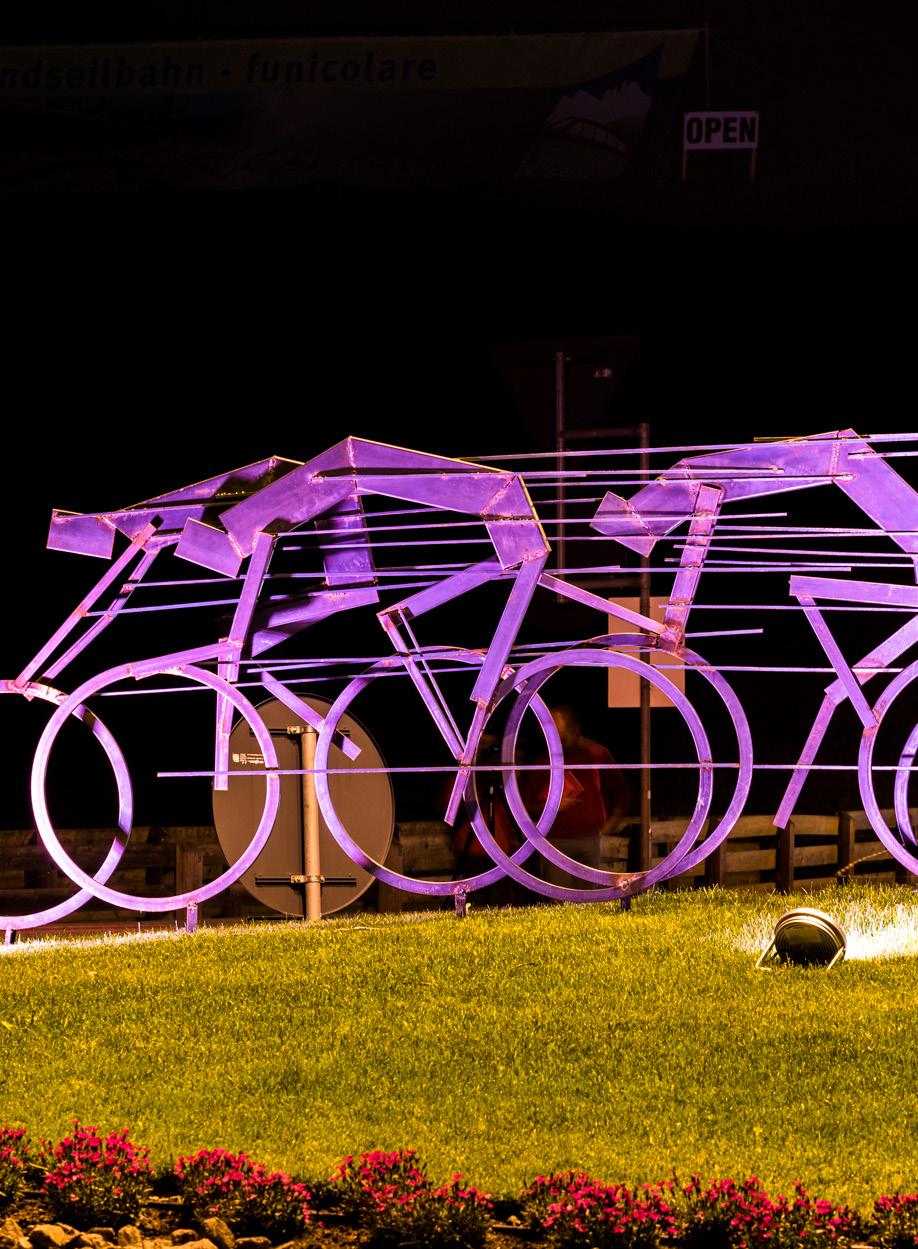
Gröden – Seiser Alm Val Gardena – Alpe di Siusi Gardena Valley – Alpe di Siusi
Fatevi sentire
Let’s hear it for the riders
Am 21. Mai kehrt der legendäre Giro d’Italia mit der 16. Etappe von 202 km nach Südtirol zurück und verläuft dabei fast durch die ganze Provinz bis nach Gröden. Die Teilnehmer fahren von Livigno über das anspruchsvolle Stilfser Joch und weiter über den Vinschgau nach Meran. Von dort geht es vorbei an Bozen bis nach Wolkenstein. Die letzten 2,7 km führen über den Monte Pana oberhalb von St. Christina. Machen Sie sich bereit und empfangen Sie die großartigen Sportler unter vielen Jubelrufen. Vergessen Sie dabei aber nicht, die spektakuläre Dolomitenlandschaft mit Blick auf die Sellagruppe und den Langkofel zu genießen.
Il 21 maggio il mitico Giro d’Italia fa ritorno in Sudtirolo, con la sedicesima tappa di 202 km che, dopo aver attraversato gran parte della provincia, giunge in Val Gardena. Partendo da Livigno, infatti, i ciclisti professionisti si trovano ad affrontare lo sfidante Passo dello Stelvio, per poi scendere lungo la Val Venosta verso Merano e proseguire per Bolzano fino a Ortisei. Da lì, gli ultimi 2,7 km sono in salita sul Monte Pana, sopra la località di Santa Cristina. Preparatevi, dunque, ad accogliere a gran voce i corridori della corsa rosa sull’altipiano dolomitico con vista panoramica sul Gruppo del Sella e del Sassolungo.
The iconic Giro d’Italia is back in South Tyrol on May 21st! The 16th stage is key: a thrilling 202 km ride that winds its way through the province before reaching the picturesque Gardena Valley. Starting from Livigno, the pro cyclists tackle the mighty Stelvio Pass, then swoop down through Venosta Valley to Merano, and on to Bolzano before reaching Ortisei. From there, the last stretch is a 2.7 km uphill battle to Monte Pana, above Santa Cristina. Time to give a rousing welcome to the pink-clad riders as they conquer the Dolomite plateau, with breathtaking views of the Sella Group and the Sassolungo.
07.06.2024

Wipptal
Alta Valle Isarco
Upper Isarco Valley
Una corsa verso l’imbrunire
A city run at dusk
Wenn die Sonne am 7. Juni hinter den Bergen verschwindet, treffen sich begeisterte Läufer vor dem Zwölferturm in Sterzing und machen sich bereit für ein Rennen durch die Straßen der Altstadt. Alle, die in einem Sportverein eingeschrieben oder über ein gültiges ärztliches Attest verfügen, können an der 27. Ausgabe des Sterzinger Stadtlaufs teilnehmen. Die Sportler werden in Kategorien eingeteilt und starten in verschiedenen Zeitabschnitten ab 18:30 Uhr. Während die Jüngsten 300 m zurücklegen müssen, beträgt die längste Distanz rund 5 km. Wie es sich für einen Lauf gehört, werden die Sieger am Ende mit einem Preis geehrt.
Il 7 giugno, dopo che il sole cala dietro le montagne, la colorata piazza di Vipiteno con l’emblematica Torre delle dodici diventa punto d’incontro per i corridori – iscritti a una società sportiva oppure muniti di certificato medico valido – partecipanti alla ventisettesima edizione della storica corsa podistica della città. Suddivisi per categorie, dalle 18:30 in poi tutti gli atleti partono alla volta del tradizionale percorso che si sviluppa tra le vie del centro storico, per competere su distanze che vanno da 300 m, per i piccolissimi, a poco più di 5 km. Al termine, come di consueto, i vincitori ricevono il loro premio.
As the sun dips behind the mountains on June 7th, the vibrant square of Vipiteno springs to life, with the iconic Torre delle Dodici towering above. It’s time for the 27th edition of the city's historic footrace. Whether you are part of a sports club or have a trusty medical certificate, you’re welcome to join the fun! From 6:30 p.m. onwards, athletes of all ages set off for the classic route through the historic centre, with distances ranging from a 300 m sprint for the little ones, to a longer 5-km run. And, of course, at the finish line, the winners can claim their well-deserved prizes.

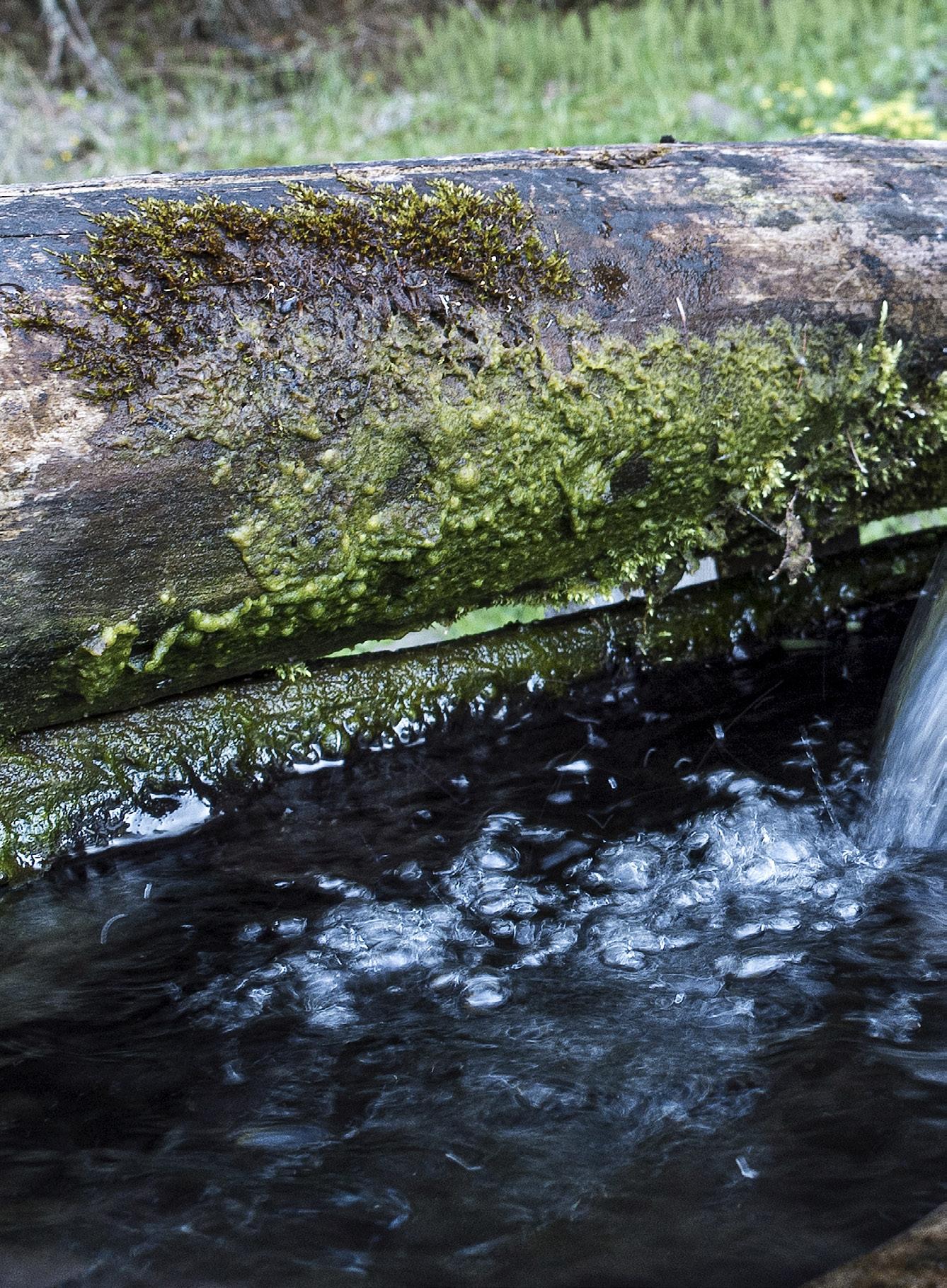
Nicht weit von der Südtiroler Grenze entfernt befindet sich ein Tal, das sich seine ursprüngliche Schönheit bewahrt hat und seine Besucher in eine Welt der Naturwunder führt. Vor allem die Kraft und Wirkung des Wassers spielen im Defereggental eine große Rolle, denn die Heilquelle, die in Osttirol entspringt, gilt als besonders wirksam. Begleiten Sie uns auf eine Reise ins „Tal des Wassers“.
Non lontano dal confine altoatesino, vi è una valle che ha conservato la sua bellezza originale e mostra ai visitatori una natura autentica. Nell’austriaca Defereggental, la forza e i benefici dell’acqua giocano un ruolo di vitale importanza, in quanto la sorgente termale, che nasce nel Tirolo orientale, ha poteri curativi. Venite con noi in un viaggio nella cosiddetta “valle dell’acqua”.
Not far from the South Tyrolean border lies a valley that has preserved its primeval beauty and invites visitors into a world of natural wonders. The power and impact of water plays a particularly important role in the Defereggen Valley. The healing spring that has its source in East Tyrol is considered to be particularly effective. Join us on a journey into the “Valley of Water”.

Eine kurze Fahrt über den Staller Sattel und man passiert nicht nur eine atemberaubende Panoramastraße, sondern überquert auch die Grenze zwischen Italien und Österreich. Hinter dieser Grenze eröffnet sich eines der ursprünglichsten Täler Österreichs. Dies hat, wenn man der alten Legende glauben schenken mag, wohl auch mit dem Schutz der Schnabelmenschen zu tun. Laut dieser Legende verhelfen diese den Defereggern zu ihren Wasserquellen und dem Gebiet so zur Bezeichnung „Tal des Wassers“. In der Realität wurde in St. Jakob vor rund 20 Jahren nach Thermalwasser gebohrt und man stieß auf die fossile Quelle, das Deferegger Heilwasser, das heute neben der sattgrünen Landschaft einer der größten Schätze des Defereggentals darstellt. Aus rund 1850 m Tiefe wird das Wasser hervorgeholt. Dieses dient der äußeren Anwendung und gilt als besonders wirksam gegen Beschwerden wie rheumatische und orthopädische Erkrankungen, dermatologische Probleme wie Schuppenflechte, Neurodermitis sowie akute und chronische Erkrankungen der Atemwege und Nasennebenhöhlen. So zeigte eine wissenschaftliche Studie von Univ.-Prof. Dr. Peter Lechleitner und Dr. Widemair, dass bei Zugabe von rund 3-5 l des Heilwassers in einem regelmäßig durchgeführten Wannenbad bereits deutliche Veränderungen zu beobachten sind: „Die Gefäßfunktion verbessert sich, der Blutdruck sinkt, die Stimmung hebt sich, der Schlaf wird besser und insgesamt fühlten sich die Probanden wesentlich erholter“, so Dr. Widemair. Besonders wirksam ist das älteste Heilwasser der Welt aufgrund seines hohen Anteils und Gemischs an Mineralien und Spurenelementen. Tief unter der Erde konnte diese Quelle mindestens 600.000 Jahre lang zu dem werden, was sie heute ist: salziges Thermalwasser, das schon in geringen Mengen eine äußerst starke Wirkung zeigt. Nur selten werden fossile Quellen für therapeutische Zwecke genutzt, das liegt wohl mitunter an den strengen Vorschriften, die mit der Reinheit, der nachgewiesenen Wirksamkeit und der sorgfältigen Auswahl der Anwendungsgebiete einhergehen. Im Sommer bietet der Ort der Quelle, die Heilwasserwelt in St. Jakob, wunderbare Möglichkeiten zum Wandern entlang des Wassererlebnisweges. Außerdem kann man hier die Natur bestens genießen, sich ausruhen und kneippen, an manchen Tagen sogar im Heilwasser. Heilwasserbäder sind in ausgewählten Betrieben ganzjährig möglich.
Aber das Heilwasser ist erst der Anfang der Deferegger Geschichte, denn in dieser Gegend plätschert, tropft, strömt, gurgelt und rinnt es von allen Seiten. Sowohl die symbolische als auch die physikalische Kraft des feuchten Elements treffen hier aufeinander und for-
The water gently babbles from the healing water fountain.

men sich zu den schönsten Spektakeln. Vom Gletscher oder den Quellen ergießt sich das Wasser in einen Gebirgsfluss, läuft durch den Hochgebirgssee weiter abwärts, überwindet mit tosenden Wasserfällen selbst die höchsten Felsen und fließt schließlich seidig und klar durch das Tal.
Im Defereggental wird die philosophische Flusslehre greif- und spürbar, denn das Wasser nährt und entspannt nicht nur, sondern befindet sich – genau wie der Mensch – im ständigen Wandel und zeigt die wahre Kraft des Lebens im glänzenden Spiegel seiner Oberfläche.
„Man kann nicht zweimal in denselben Fluss steigen.“
Heraklit
Die Legende der Schnabelmenschen
Die Menschen im Defereggental, ob jung, ob alt, wissen um die Legende der riesigen Schnabelmenschen, die einst im Tal weilten.
Geheimnisvolle Kreaturen waren sie, Beschützer des Tales seit Anbeginn der Zeit. Mit ihren mächtigen, klappernden Schnäbeln verzehrten sie Salzstücke und manchmal teilten sie ihre kostbaren Salzsteine mit den Einheimischen.
In diesen frühen Tagen stand das Tal durch die Anwesenheit der Schnabelmenschen unter deren Schutz und Segen. Einem Glückstal gleich gediehen die Ernten, alles Vieh blieb gesund und gab reichlich Milch, Unwetter zogen stets über die angrenzenden Berggipfel vorbei, und die Einheimischen lebten in Eintracht und großer Zufriedenheit. Allerdings war die Zuwendung der Schnabelmenschen seit jeher an eine Bedingung geknüpft: Niemand durfte das Tal verlassen, und fremden Reisenden blieb es verwehrt. Einem verschlossenen Paradies gleich lag es abgelegen und bildete eine Welt im Kleinen, die für die ihren sorgte.
Eines Tages allerdings sammelte sich in einer Mulde oberhalb der Jagdhausalm eine Quelle. Diese nahm die rundliche Form eines Pfauenauges an und wurde aufgrund ihrer außergewöhnlichen Pracht ein mystischer Ort und zu einem Botschafter der Ferne, der das Fernweh in das Defereggental einsickern ließ. Es dauerte nicht mehr lange, da regte sich unter den Jungen die Neugierde, über das Tal hinauszuwandern und fremde Länder aufzusuchen. Die Schnabelmenschen brachten aber all diese Versuche zum Scheitern und so musste man sie wohl mit einer List dazu bringen, das Tal zu öffnen. Ein gewitzter Bursche forderte sie zu einem Wettkampf heraus. Er behauptete,
seinen Hut weiter werfen zu können als die riesigen Schnabelmenschen die ihren. So lange reizte er sie durch seine Prahlereien, dass die Riesen im Wettkampf ihre Hüte wie Wurfgeschosse Richtung Berge warfen. Dabei köpften aber einige der gewaltigen Kopfbedeckungen mit ihren scharfen Krempen die Berggipfel, die vorher das Tal rundum abgeschottet hatten und bildeten den heutigen Staller Sattel. Viele der Einheimischen zogen nun über die neuen Gebirgssättel mit Schätzen und Tauschwaren hinaus.
Den Schutz und die Zuneigung der Schabelmenschen hatte man aber auf diese Weise verspielt. Der Preis für die Öffnung des Glückstales musste bezahlt werden mit harter Hände Arbeit und einem unablässigen Ringen um das tägliche Brot gegen die Kräfte der Natur. Die ausgezogenen Händler machten nach Jahren in der Fremde allerdings eine unerwartete Erfahrung. Wann immer sie draußen in der Ferne in ein ruhiges Wasser oder in einen Spiegel schauten, meinten sie Umrisse und Gestalten des Defereggen aufleuchten zu sehen. Fernweh und Heimweh zugleich prägten den Charakter der aufrechten Pioniere, als schlügen zwei Herzen in ihrer Brust. Viele Jahrzehnte später brachte eine Gruppe von Heimkehrern einen besonderen Fund mit, der in seinem Aussehen geheimnisvoll an die einstigen Herrscher des Tales erinnerte. Es handelte sich um eine übergroße „Schnabelflöte“. Niemand
konnte dem seltsamen Instrument einen Ton entlocken, und so verankerte man das Rohrinstrument als Erinnerungsgebilde stehend in der Erde nahe dem Dorf St. Jakob. Als nun aber das erste Mal kräftig Wind aufkam, gab die Schnabelflöte wundersame Töne von sich. Geehrt durch die ihnen zugedachte Flöte versöhnten sich die Schnabelmenschen mit den Menschen aus dem Tal und erklärten, dass sie nun zurückkehrten in das große unterirdische Salzmeer, welches tief unter dem Defereggen versteckt liegt.
Als Zeichen der Verbundenheit und des Wohlwollens werden von nun an zahlreiche Quellen aus unterschiedlichen Tiefen die Welten oberhalb und unterhalb der Erde verbinden. Das kostbarste Wasser allerdings entspringt am Fuße der Schnabelflöte. Dies ist wohl die wertvollste aller Quellen, so salzig und rein wie das Urmeer selbst, aus dem sie entspringt. Bereits in einem Fingerhut davon steckt ein Übermaß an reinigender und heilsamer Kraft.
Basta un breve tragitto in auto sul Passo Stalle per ritrovarsi non solo dall’Italia all’Austria, ma anche tra panorami mozzafiato. Infatti, si entra subito in una delle valli più primordiali della regione del Tirolo: se si vuol credere a un’antica leggenda, il merito è dei cosiddetti “uomini col becco”, i quali proteggono il territorio e aiutano gli abitanti a rintracciare fonti d’acqua. Stando ai fatti reali, invece,
circa vent’anni fa, nel paesino di Sankt Jakob vennero effettuati degli scavi per estrarre l’acqua termale da una sorgente fossile, oggi considerata uno dei tesori più preziosi della valle, assieme ai paesaggi incontaminati. L’acqua viene prelevata da una profondità di circa 1850 m e, impiegata a uso esterno, è ritenuta particolarmente efficace contro disturbi reumatici e ortopedici, problemi dermatologici come psoriasi e neurodermatiti, malattie acute e croniche delle vie respiratorie e dei seni paranasali. Uno studio condotto dal professore universitario Peter Lechleitner e dal dottor Widemair ha dimostrato che fare regolarmente un bagno aggiungendo 3-5 l di quest’acqua nella vasca porta a benefici significativi. “Nei soggetti testati sono migliorati la funzione vascolare, l’umore e il sonno, è calata la pressione sanguigna e c’è stato un senso di maggiore rilassatezza generale”, afferma Widemair. Ciò che rende quest’acqua, la più antica del mondo, tanto curativa è la sua alta concentrazione e varietà di minerali e oligoelementi: sita parecchio in profondità nel sottosuolo, nel corso di seicentomila anni la sorgente di natura fossile si è trasformata in acqua termale salata, super benefica anche in piccole quantità. Tuttavia, le fonti fossili vengono di rado utilizzate a scopo terapeutico, probabilmente anche a causa delle rigide norme legate alla purezza, all’efficacia e alle precise aree di applicazione. In estate, il mondo delle acque termali di Sankt Jakob invita a fare rigeneranti

Das Element Wasser durchzieht das gesamte Defereggental.
L’acqua è un elemento onnipresente nella valle di Defereggen.
The element of water characterises the entire Defereggen Valley.
Auch heute weckt das Pfauenauge aus der Legende noch das Fernweh in seinen Betrachtern.
Ancora oggi ammirare la leggendaria conca a forma di occhio di pavone invoglia all’esplorazione.
Even today, the peacock’s eye from the legend still awakens the wanderlust in its beholders.

passeggiate lungo i sentieri della sorgente e a rilassarsi, godersi la natura e usufruire del percorso Kneipp che, in specifici giorni, presenta acqua curativa. In determinati stabilimenti, invece, ci si può immergere in vasche con quell’acqua in ogni periodo dell’anno.
Ma quella termale è solo una parte dell’acqua presente nella valle di Defereggen, che trasmette energia vitale e porta in scena magnifici spettacoli naturali. Qui, infatti, vi è acqua che sgorga, scorre, gorgoglia, gocciola e scroscia in ogni dove e la forza simbolica e fisica di questo elemento si fondono: dai ghiacciai alle sorgenti di montagna, giù nei laghi alpini o sotto forma di fragorose cascate, fino a formare torrenti limpidi e setosi a bassa quota. Così, nella valle, gli insegnamenti filosofici legati al fluire del fiume diventano tangibili, poiché l’acqua, oltre a nutrire e rilassare, si trova in uno stato di costante mutamento –proprio come le persone – e mostra la forza vitale attraverso lo specchio che si crea sulla sua superficie.
“Non ci si può bagnare due volte nello stesso fiume.”
Eraclito
La leggenda degli uomini col becco
Chiunque viva nella valle di Defereggen conosce la leggenda delle creature giganti e misteriose, che un tempo proteggevano il territorio. Con i loro forti becchi prelevavano cristalli di
sale dalla roccia e a volte li condividevano con la gente del posto. Come in una favola, tutto procedeva per il meglio: i raccolti prosperavano, il bestiame godeva di buona salute, vi era latte in abbondanza, il maltempo interessava solo le cime delle montagne vicine e si viveva in armonia. Tuttavia, la fedeltà degli uomini col becco era sempre stata soggetta a una condizione: nessun abitante poteva lasciare la valle e nessuno straniero poteva entrarvi. Era come un’isola felice.
Un giorno, però, una sorgente si insediò in una conca sopra la malga Jagdhausalm: la sua forma arrotondata ricordava un occhio di pavone, il che la rendeva insolita e affascinante. Di conseguenza, questo luogo venne visto come mistico, nonché un emblema di terre lontane, e invogliò particolarmente i giovani ad andare alla scoperta di posti mai visitati. Purtroppo, non ottennero il consenso degli uomini col becco e così dovettero agire d’astuzia per poter oltrepassare il confine. Ci fu un ragazzo scaltro che li sfidò: si vantava di poter lanciare
il suo cappello più lontano di quanto gli uomini col becco sapessero fare. Per dimostrare il contrario, i giganti lanciarono i cappelli verso le montagne come fossero dei missili. Ecco, che alcuni degli enormi copricapi con le falde affilate “decapitarono” le cime circostanti, che facevano da barriera alla valle, andando a formare l’odierno Passo Stalle. Da quel momento, in molti iniziarono a oltrepassarlo per scambiare merci e prodotti preziosi.
Questo inganno, tuttavia, mise a repentaglio la fedeltà degli uomini col becco, che smisero di proteggere la valle. Il prezzo da pagare consisteva nel lavorare duramente, lottando contro le forze della natura per riuscire a portarsi il pane a casa. Dopo anni in giro per il mondo, i commercianti fecero un’esperienza inattesa: su tutte le superfici d’acqua placida pareva loro di vedere i contorni e le forme della valle di Defereggen. Provarono così una sensazione di nostalgia mista al desiderio di continuare a viaggiare, come se avessero due cuori che battevano all’unisono. Molti decenni dopo, un gruppo di rimpatriati portò con sé un reperto, che nella sua forma ricordava misteriosamente i protettori della valle. Si trattava, infatti, di un enorme flauto a becco, dal quale nessuno riusciva a ricavare un suono e allora venne conficcato nella terra nei pressi di Sankt Jakob, quale monumento commemorativo. Quando poi si alzò per la prima volta un forte vento, il flauto emise suoni meravigliosi. Onorati del gesto, gli uomini col becco si riconciliarono con gli abitanti e promisero che sarebbero tornati nel sottosuolo ricco di sale della valle di Defereggen. In segno di solidarietà e benevolenza, da quel momento in poi fecero nascere numerose sorgenti in diversi luoghi, che avrebbero connesso la superficie con la profondità della valle. L’acqua più preziosa, però, sgorga ai piedi del flauto a becco: è salata e pura come il mare primordiale da cui proviene e racchiude poteri curativi anche solo in una piccola goccia.
Only a short drive across the Stalle Pass and you will not only drive by a breathtaking panoramic road, you also cross the border between Italy and Austria. Once past this border, one of Austria's most unspoilt valleys opens up to you. If the old legend is to be believed, this has something to do with the protection of the “Beak People” (giants with beaks instead of mouths). According to these legends, they gifted the people of the Defereggen Valley the knowledge of where to find water sources. This is how the area came to be known as the “Valley of Water”. In actual fact, some 20 years ago, drilling for thermal water was carried out in St. Jakob and the fossilised spring was discovered. Alongside the lush green landscape, it is now one of the Defereggen Valley’s greatest treasures. The water is extracted from a depth of around 1,850 m. It is only used externally and is considered particularly effective against complaints which includes rheumatic and orthopaedic diseases. Dermatological problems such as psoriasis, neurodermatitis and acute and chronic diseases of the respiratory tract and paranasal sinuses, are also treated with it. A bathing study conducted by University Professor Dr Peter Lechleitner and Dr Widemair has shown that regular use of around 3-5 litres of water in a bathtub can already bring about significant changes. “Vascular function improves, blood pressure drops, the mood is lifted, the quality of sleep improves and overall the test subjects felt much more relaxed,” says Dr Widemair. What makes the oldest healing water in the world particularly beneficial is its mineral maturation. The spring has been able to transform deep underground for at least 600,000 years to become what it is today: salty thermal water that has a very powerful effect even in small quantities. Fossil sources are only rarely used for therapeutic purposes. This is probably partly due to the strict regulations associated with purity, proven efficacy and the careful selection of application areas. During the summer, there are wonderful opportunities to hike along the water
Wenn im Juni die Alpenrose in voller Blüte steht und die Hügel um den Obersee in leuchtendem Rot erstrahlen, dann ist die perfekte Zeit gekommen, um einen entspannten Spaziergang am Bergsee zu unternehmen. Dieser Ort am Staller Sattel ist ein beliebtes Ziel sowohl vom Defereggen- als auch vom Antholzertal aus. Mit Auto oder Bus gelangt man direkt an den See und kann von dort aus am Ufer entlang spazieren. Idealerweise unternimmt man diesen Ausflug am Vormittag und gegen den Uhrzeigersinn, so kann man pünktlich zur Mittagszeit im Gasthaus einkehren und das weitum beliebte Hirschgulasch mit Blick auf das türkise Wasser genießen.
Vi consigliamo un’escursione Un lago
Quando a giugno la rosa alpina è in piena fioritura e i pascoli attorno al lago Obersee si tingono di fucsia acceso, è il momento perfetto per fare una rilassante passeggiata nella zona. Trovandosi al Passo Stalle, questo bacino è una destinazione gettonata sia per chi proviene dalla valle di Defereggen che da quella di Anterselva, in Alto Adige. È possibile raggiungere la destinazione con l’auto o il pullman, preferibilmente al mattino, così da cominciare l’escursione in senso antiorario e fermarsi a pranzare nella locanda tipica, dove gustare il famoso spezzatino di cervo, con vista sulle acque turchesi.
When the alpine rose is in full bloom and the hills around the Obersee Lake glow in a vibrant red colour in June, then it's the perfect time to take a relaxing walk through this beautiful landscape. Located on the Stalle Pass, this place is a popular destination from both the Defereggen and Anterselva Valleys. The lake can be reached directly by car or bus. From there, you can leisurely stroll along the shore. The ideal time to make this excursion is in the morning and in an anti-clockwise direction: this way you can stop at the inn in time for lunch and enjoy the widely popular venison goulash with a view of the turquoise lake.
adventure trail which is located by the spring: the “Heilwasserwelt” (healing water world) in St. Jakob. It is also a great place to enjoy nature, relax and take a dip, sometimes even in the healing waters. Healing water baths are available all year round in selected establishments. Yet, the healing waters are only the beginning of the Deferegger story. In this area, the water splashes, drips, flows, gurgles and trickles from every direction. Both the symbolic and the physical power of the wet element collide here and form the most magnificent natural spectacles. The water pours from the glacier and springs down into a mountain river, continues its descent through the high mountain lake, cascades over the tallest rocks in the form of thundering waterfalls and finally flows through the valley, all silky and clear. The philosophical theory of rivers becomes tangible and perceptible in the Defereggen Valley. Water not only nourishes and relaxes, but – just like people – is in a constant state of flux and reveals the true force of life in the shining mirror of its surfaces.
“No man ever steps in the same river twice.”
Heraclitus
The inhabitants of Defereggen Valley, both young and old, know of the legend surrounding the giant beaked men who once dwelled here. They were mysterious creatures. Protectors of the valley since the beginning of time. They consumed chunks of salt with their mighty, rattling beaks and sometimes shared the valuable salt stones with the locals.
In those early days, the valley was protected and blessed by the presence of the Beak People. The harvests flourished in this valley of good fortune. The cattle remained healthy and gave plenty of milk, stormy weather always passed over the neighbouring mountain peaks, and the locals lived in peace and harmony. Nevertheless, the benevolence of the Beak People had always been subject to one condition: No one was allowed to leave the valley, and it re-
I laghi alpini Gritzer nel Parco nazionale degli Alti Tauri sono come specchi.

mained off-limits to foreign travellers. It was like a closed off paradise: a secluded miniature world that took care of its own.
One day, however, a spring gathered in a basin above the Jagdhaus Hut. The spring took on the rounded shape of a peacock's eye and, due to its extraordinary splendour, became a mystical place and a messenger of faraway lands. As a result, wanderlust seeped into the Defereggen Valley. It wasn't long before the boys began to be intrigued by the idea of travelling beyond the valley and visiting unknown places. The Beak People, however, thwarted all these attempts and so a trick had to be played to persuade them to open the valley. One clever chap challenged them to a competition. He claimed to be able to throw his hat further than the giant Beak People could throw theirs. His boasting was so provocative that the giants began to throw their hats towards the mountain peaks like missiles during the competition. In doing so, however, some of the enormous headdresses with their sharp brims decapitated various mountain peaks that had previously sealed off the valley all around. A number of the locals now made their way across the new mountain saddles carrying treasures and trade goods. But they had gambled away the protection and affection of the Beak People as a result. The price for opening up the valley of good fortune had to be paid with hard labour and an unrelenting struggle to earn their daily bread against the forces of nature. After years
abroad, however, the exiled traders had an unexpected experience. Every time they looked into a calm body of water or a mirror, it was as if they could see the outlines and shapes of Defereggen shimmering in the distance. Both wanderlust and homesickness shaped the character of the upright pioneers, as if two hearts were beating in their chests. Several decades later, a group of returnees carried a special discovery (that was mysteriously reminiscent of the former rulers of the valley) home with them. What they found was an oversized “beak flute”. Nobody was able to elicit a sound from the strange instrument, and so it was anchored into the ground near the village of St. Jakob –as a sort of memento. When a strong wind arose for the first time, the beak flute emitted wondrous sounds. Having been honoured by the flute they were given, the Beak People reconciled with the people from the valley. They declared that they would now return to the great sea of salt hidden deep beneath Defereggen.
From then on, numerous springs from different depths were connected between the worlds above and below the earth as a sign of solidarity and goodwill. The most precious water, however, springs from the foot of the “beak flute”. Arguably the most treasured of all springs, it is as salty and pure as the primordial sea from which it springs. Just a thimbleful of it contains an abundance of purifying and healing power.




Simone Klinkner
Geschäftsführerin
Amministratrice delegata
Chief Executive Officer
Deferegger Heilwasser
DE • „Die Liebe zum Defereggental mit der Heilwasserwelt als verwunschenem Kraftplatz kam auch durch meine eigene Heilung durch das Deferegger Heilwasser nach rund 30 Jahren leidvoller Hauterkrankungen. Heute stehe ich ganz im Dienst des kostbaren Wassers, damit möglichst viele Menschen eine Linderung unterschiedlichster Erkrankungen erfahren können. Genau das ist es, was uns jeden Tag aus vollem Herzen erfreut.“
Heilung aus der Tiefe – über 600.000 Jahre altes zertifiziertes Heilwasser – reich an Mineralien und Spurenelementen – Schatz jeder Hausapotheke und für die anspruchsvolle Körperpflege unverzichtbar. Für dich zuhause oder als Auszeittage im Defereggental/Osttirol.
IT • “La mia passione per la valle di Defereggen, quale affascinante luogo energetico con preziose acque curative, è partita dai benefici sperimentati in prima persona: dopo aver sofferto per trent’anni di malattie dermatologiche, sono guarita proprio grazie all’acqua termale che sgorga qui. Pertanto, oggi, tutti noi, siamo con convinzione al servizio di questa straordinaria fonte di benessere, così che altre persone possano trovare sollievo da diversi disturbi.”
Un’acqua termale certificata – antica fonte di benessere da oltre 600.000 anni – ricca di minerali e oligoelementi – un tesoro di sostanze medicinali per il trattamento e la cura del corpo e della pelle. A casa tua o come cura nella valle di Defereggen nel Tirolo orientale.
EN • “My love for the Defereggen Valley – with its enchanted world of healing water – was also the result of my personal healing experience from 30 years of suffering from a variety of skin conditions thanks to Defereggen’s curative water. I now work with this precious water to ensure that as many people as possible can experience relief from a wide range of different conditions. This is precisely what delights us every single day.”
Healing powers from the depths – over 600,000 years old certified healing water – rich in minerals and trace elements – a treasure in every medicine cabinet and for luxurios body care. Both at home or as cure in the Defereggen Valley/East Tyrol.
Deferegger Heilwasser
Innerrotte 62, 9963 St. Jakob i.D. | T. +43 676 8415 60406
info@deferegger-heilwasser.at | www.deferegger-heilwasser.at
www.unsplash.com/Jelle

Le Dolomiti non esisterebbero senza il supervulcano
The Dolomites would not exist were it not for the supervolcano
Vor ca. 280 Millionen Jahren befand sich im heutigen Trentino-Südtirol ein Supervulkan, der 12 Millionen Jahre lang immer wieder Feuer und Asche spuckte. Wir haben uns mit Evelyn Kustatscher, Paläobotanikerin und Kuratorin der Sonderausstellung zum Thema Supervulkan am Naturmuseum Südtirol, auf eine Zeitreise begeben und erfahren, wie sehr der Vulkan unser Leben auch heute noch prägt.
Circa 280 milioni di anni fa, nell’attuale Trentino-Alto Adige vi era un supervulcano, che eruttò più volte nell’arco di dodici milioni di anni. Con Evelyn Kustatscher, paleobotanica e curatrice della mostra temporanea sul tema presso il Museo di scienze naturali dell’Alto Adige, abbiamo compiuto un viaggio nel tempo e scoperto quanto tutto ciò influisca ancora oggi sulla nostra vita.
Some 280 million years ago, there was a supervolcano in what is now the Trentino-Alto Adige region, which repeatedly spat fire and ash for 12 million years. We travelled back in time with Evelyn Kustatscher, palaeobotanist and curator of the special exhibition at the South Tyrol Nature Museum, and found out how much this volcano still shapes our lives today.
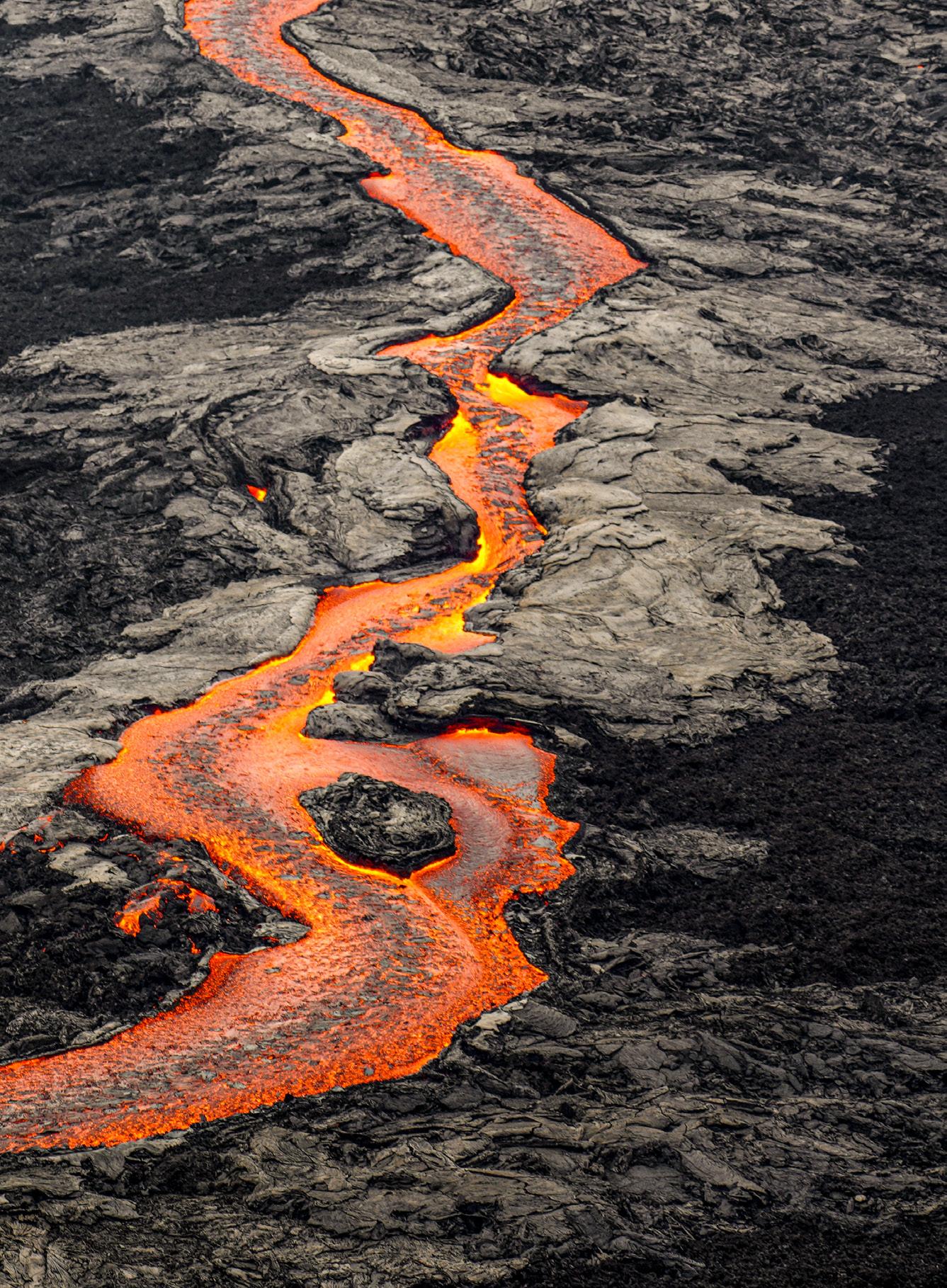
Frau Kustatscher, seit wann weiß man vom Bozner Supervulkan?
Dass es einen Vulkan in Bozen gegeben hatte, wusste man schon seit langem, allerdings hat sich nie jemand näher damit befasst. Das Interesse stieg erst in den letzten zehn bis fünfzehn Jahren. Damals wurde in Meran und im Überetsch eine neue geologische Kartierung vorgenommen, das heißt, es wurde untersucht, welche Gesteine in welchen Gebieten vorkommen. Im Zuge dieser Kartierung wurde festgestellt, dass die Wände der beiden Calderas 600 und 800 m dick sind. Unter einer Caldera versteht man einen Krater mit vielen Kilometern Durchmesser, der durch den Einbruch der Magmakammer entsteht.
heißt, das Gestein ist auch dann noch warm, wenn die Sonne bereits untergeht. Die Calderawand um Bozen sorgt somit – gemeinsam mit der kesselartigen Struktur des Geländes – dafür, dass es im Sommer sogar zu Tropennächten kommt. Es ist kein Zufall, dass der Virgl im Süden der Stadt als Naherholungsgebiet gilt: Die dortige Gesteinswand bekommt aufgrund ihrer nördlichen Ausrichtung weniger Sonne ab und heizt daher weniger stark auf als beispielsweise der Hörtenberg im Osten. Aber auch die Dolomiten würde es ohne den Supervulkan nicht geben. Das Sedimentgestein der Dolomiten liegt auf einem Porphyrsockel, den wir an der Erdoberfläche nicht sehen. Ohne diesen Sockel würden sich die Berge in einer ganz anderen Form präsentieren.

Nun war klar, dass wir es hier nicht nur mit einem Vulkan, sondern mit einem Supervulkan zu tun haben, einem der größten der Erdgeschichte. Mit einem Durchmesser von 70 km erstreckte er sich von Sinich bei Meran bis nach Trient.
Ein Supervulkan, dessen Auswirkungen wir auch heute noch sehen und spüren. Inwiefern?
Der Supervulkan zeigt sich heute in Form des Bozner Quarzporphyrs, eines weltbekannten und vor allem in der Architektur beliebten vulkanischen Gesteins. Vulkangestein ist sehr eisenhaltig, es nimmt Wärme schnell auf und gibt sie nur langsam wieder ab. Das
Evelyn Kustatscher wurde 2014 mit dem Südtiroler Forschungspreis ausgezeichnet.
Evelyn Kustatscher, nel 2014, ottenne il Premio alla ricerca dell’Alto Adige.
Evelyn Kustatscher was honoured with the South Tyrolean Research Prize back in 2014.
Wie hat der Supervulkan das Leben vor 280 Millionen Jahren geprägt?
Der Supervulkan von Bozen ist im Laufe der Erdgeschichte mehrmals ausgebrochen, wobei zwischen den Ausbrüchen teils hunderttausende Jahre liegen. In diesen Ruhephasen siedelten sich Insekten, Amphibien, Reptilien und verschiedenste Pflanzen im Gebiet an, wo es viel feuchter war als in der Umgebung. Es ist gut vorstellbar, dass bei einem Ausbruch nicht das komplette Leben ausgelöscht wurde. In Schutzzonen konnten manche Lebewesen überleben und der Bestand erholte sich – auch weil es sich nicht um besonders komplexe Lebensformen handelte. Ein kleiner Genpol war völlig ausreichend für das Überleben der Spezies.
Da viele Pflanzen, Pollen und Fußspuren aus dieser Zeit fossil erhalten sind, können wir einiges über die damaligen Lebensbedingungen in Erfahrung bringen.
Beeinflusst ein Vulkanausbruch auch das Klima?
Bei einem Vulkanausbruch kann sich das Klima lokal oder weltweit verändern. Durch die Aschewolke werden die Winter mitunter kälter und im Sommer entsteht weniger Wärme, was wiederum – im Zeitalter der Menschen –zu Ernteausfällen führen kann. Daher gehen Völkerwanderungen teils auf außergewöhnlich starke Vulkanausbrüche zurück. Auch das größte Massenaussterben der Erdgeschichte vor 252 Millionen Jahren hängt mit Vulkanausbrüchen und dem darauffolgenden Klimawandel zusammen: Tausende Vulkanausbrüche im heutigen Sibirien schmolzen das Methaneis in den Polarböden und setzten Unmengen von Methan in die Atmosphäre frei.
Wann wurde das Forschungsprojekt zum Supervulkan ins Leben gerufen?
Das Forschungsprojekt „Living with the supervolcano“ lief von 2020 bis 2023 und es wurden Forschende aus verschiedenen Bereichen hinzugezogen. So untersuchten wir fossile Tierspuren, Pflanzen, Pollen und Grabgänge von Insekten. Aus dem ursprünglichen Projekt ist eine Reihe von Folgeprojekten entstanden. Eines davon konzentriert sich in Zusammenarbeit mit dem Landesmuseum Bergbau auf den historischen Abbau und die Nutzung von Porphyr. Wann und wo wurde wie viel Volumen abgebaut? Wohin wurde das Gestein exportiert? In Bozen besteht beispielsweise die Herz-Jesu-Kirche aus Porphyr. Der Bozner Quarzporphyr findet sich aber auch als Straßenpflasterung bei Schloss Schönbrunn, in Beverly Hills und vor dem Harrods in London. Aufgrund seiner rötlichen Farbe galt er lange Zeit als Prestigeprodukt und war besonders in der K.u.K.-Zeit und im Faschismus ein äußerst beliebter Baustoff. Im Zuge eines weiteren Folgeprojektes möchten wir außerdem gemeinsam mit der ETH Zürich die Datierung des Supervulkans genauer festsetzen und herausfinden, wie die Porphyre in den Alpen entstanden sind und warum es gerade hier einen Supervulkan gab.
Wie kann man sich Ihre Arbeit vorstellen?
Die Arbeit als Paläontologin unterteilt sich in Feld- und Laborarbeit. Wir kennen die Gebiete, in denen wir suchen müssen, und dennoch
entdeckt man auf jeder Tour etwas Neues. Das hängt auch mit dem sich verändernden Sonneneinfall zusammen. Tierspuren sieht man beispielsweise am besten, wenn das Licht von der Seite kommt. Pflanzenfossilien sind etwas einfacher zu erkennen, da sie meist schwarz sind und somit auf hellem Gestein stärker auffallen, aber natürlich bedarf es auch hier eines geschulten Auges. Die Funde werden abgetragen und im Labor genauer untersucht. In den letzten Jahren ist die Technologie sehr weit vorangeschritten und stellt uns heute ausgezeichnete Hilfsmittel wie verschiedene Scanner zur Verfügung. Durch chemische Untersuchungen können wir Rückschlüsse auf das damalige Klima und den Lebensraum ziehen und das Ökosystem rekonstruieren. Wir erfahren, wie Pflanzen und Tiere auf gewisse Situationen reagiert haben. Dieser Blick in die Vergangenheit ermöglicht es uns, Zukunftsprognosen zu erstellen und zu erfahren, wie wir Ökosysteme erhalten können. Bei der Paläontologie geht es also um viel mehr als nur Erdgeschichte.
Was hat Sie im Laufe des Forschungsprojekts besonders fasziniert?
Das Faszinierendste war, dass wir völliges Neuland betreten haben. Das Forschungsmaterial liegt direkt vor unserer Haustür und dennoch hat sich bisher kaum jemand damit befasst. Das heißt auch, dass es kaum Literatur zum Thema gab – vermutlich die größte Herausforderung. Mit jeder neuen Information öffnete sich uns eine weitere Tür, die wie-
derum Ausgangspunkt für zukünftige Forschungsprojekte sein kann. Interessant wäre es z. B. auch herauszufinden, wie sich das Vulkangestein auf den Weinanbau in Südtirol auswirkt. Es ist nie ausgeforscht und gerade das macht den Supervulkan so spannend.
Signora Kustatscher, da quanto si è a conoscenza del supervulcano atesino?
Che a Bolzano ci fosse stato un vulcano si sapeva già da tempo, tuttavia nessuno aveva mai approfondito la questione. L’interesse ha cominciato a crescere negli ultimi dieci, quindici anni, quando a Merano e in Oltradige è stata realizzata una nuova mappatura geologica, ovvero si è andati a vedere quali rocce fossero presenti in quali zone. Tale progetto ha rivelato che le pareti delle due caldere – vale a dire crateri con un diametro di svariati chilometri che si formano dal crollo della camera magmatica – hanno uno spessore di 600 e 800 m. Dunque, è risultato subito chiaro che quello atesino non fosse un semplice vulcano, bensì un supervulcano, tra i più grandi della storia della Terra. Infatti, contava un diametro di 70 km e si estendeva da Sinigo, presso Merano, fino a Trento.
Un supervulcano i cui effetti sono tutt’oggi tangibili. In che modo?
Il supervulcano si manifesta ora sotto forma di porfido quarzifero di Bolzano, una roccia magmatica famosa in tutto il mondo e apprezzata
in particolar modo dagli architetti. Le rocce ignee contengono parecchio ferro, per cui assorbono velocemente calore per poi rilasciarlo invece molto piano; quindi, la pietra rimane calda anche dopo che il sole è già tramontato. È per questo che la parete della caldera intorno a Bolzano – unita alla conformazione a conca del territorio – determina che d’estate nel capoluogo di Provincia le notti raggiungano talvolta temperature addirittura tropicali. Non a caso, il Virgolo, a sud della città, conta come zona ricreativa più fresca: esposta a nord, la parete rocciosa riceve meno sole, al contrario ad esempio del Monte Tondo sito a est. Inoltre, le Dolomiti stesse non esisterebbero come tali senza il supervulcano. La roccia sedimentaria delle Dolomiti poggia su uno zoccolo di porfido, non visibile perché sotto la superficie terrestre, in mancanza del quale le maestose montagne patrimonio UNESCO si presenterebbero in tutt’altra forma.
Come influì il supervulcano sulla vita 280 milioni di anni fa?
Il supervulcano di Bolzano fu attivo più volte nel corso della storia della Terra, anche se tra un’eruzione e l’altra trascorrevano magari centinaia di migliaia di anni. Nelle fasi di quiescenza, si insediarono insetti, anfibi, rettili e varie tipologie di piante, in aree più umide rispetto ai dintorni. È plausibile che una singola eruzione non sterminasse completamente le forme di vita e che, nelle zone più riparate, alcune riuscissero a sopravvivere e a riprendersi – anche perché non si trattava di organismi particolarmente complessi e bastava

Die Felswände am Bozner Talkessel sind Überbleibsel vulkanischer Aktivität.
Le pareti rocciose intorno alla conca di Bolzano derivano dall’attività vulcanica.
The rock faces in the Bolzano basin are remnants of ancient volcanic activity.

un piccolo bacino genetico per garantire la conservazione della specie. Poiché numerosi tipi di piante, pollini e impronte risalenti a tale periodo si sono fossilizzati e così arrivati fino a noi, riusciamo a evincere diverse informazioni riguardo alle condizioni di vita di allora.
Un’eruzione vulcanica incide anche sul clima?
Certo, un’eruzione può alterare il clima sia localmente che a livello globale. La nube di cenere generata potrebbe rendere gli inverni più freddi e le estati meno calde, e tradursi, nell’era dell’uomo, in raccolti scarsi. Ecco perché alcune migrazioni di popoli sono riconducibili a fenomeni vulcanici di straordinaria entità. Anche la maggiore estinzione di massa della storia, circa 252 milioni di anni fa, fu strettamente connessa al cambiamento climatico prodotto
dal vulcanismo: nell’odierna Siberia, migliaia di eruzioni sciolsero il permafrost liberando nell’atmosfera indicibili quantità di metano artico lì intrappolate.
Quando è stato avviato il progetto di ricerca “Living with the supervolcano”?
Il progetto si è svolto dal 2020 al 2023 e, coinvolgendo ricercatrici e ricercatori di differenti settori, ha studiato fossili di impronte animali, piante, pollini e cunicoli scavati da insetti. Dal progetto originario ne sono nati diversi altri, di cui uno in collaborazione con il Museo Provinciale Miniere, per approfondire la storia dell’estrazione del porfido e il relativo utilizzo. Dove e quando venne estratto quanto volume di roccia? Dove veniva esportata? La Chiesa del Sacro cuore di Bolzano, ad esempio, è proprio
Burg Hocheppan wurde im 12. Jahrhundert aus Bozner Quarzporphyr errichtet.
Castel d’Appiano fu costruito nel XII secolo con porfido quarzifero di Bolzano.
Hocheppan Castle was built from Bolzano quartz porphyry in the 12th century.
in porfido quarzifero. La stessa pietra ha trovato impiego anche nel lastricato del Castello di Schönbrunn a Vienna, a Beverly Hills e davanti all’Harrods di Londra. Per il suo colore rossiccio, fu a lungo considerata un materiale di pregio, specie ai tempi dell’impero austroungarico e del fascismo. Nell’ambito di un ulteriore progetto, insieme al prestigioso Politecnico di Zurigo, miriamo a datare con maggiore precisione il supervulcano, a comprendere l’origine del porfido e a scoprire come mai sorgesse un supervulcano proprio in Alto Adige.
Com’è il lavoro di paleontologa?
Il mio mestiere si compone di attività sul campo e in laboratorio. Sebbene conosciamo i territori da perlustrare, a ogni uscita scopriamo qualcosa di nuovo. Ciò dipende anche dalla mutevole incidenza dei raggi solari: le tracce animali, per dire, si notano meglio quando la luce arriva di lato. I fossili vegetali sono più facili da notare, perché di solito sono neri e risaltano sulla pietra chiara, ma naturalmente anche in questo caso occorre un occhio allenato. I reperti vengono asportati ed esaminati nel dettaglio in laboratorio. Negli ultimi anni, la tecnologia ha fatto passi da gigante e oggi disponiamo di strumentazioni eccellenti, come diversi scanner. Analizzando la composizione chimica, poi, riusciamo a dedurre il clima e l’habitat dell’epoca, così da ricostruire l’ecosistema e apprendere in che modo la flora e la fauna abbiano reagito a date condizioni. Questo sguardo al passato, in realtà, ci permette di formulare anche previsioni future e capire come poter preservare gli ecosistemi. Dunque, la paleontologia è molto più del mero studio della storia della Terra.
L’aspetto più entusiasmante è che si trattava di un tema del tutto inesplorato: seppure il supervulcano si trovasse sulla porta di casa, nes-
suno prima se ne era mai occupato veramente. Di conseguenza, non esisteva pressoché alcuna bibliografia a riguardo, il che ha probabilmente rappresentato la sfida più grande. A ogni nuova informazione acquisita si aprivano altre porte, le quali a loro volta potrebbero fungere da punto di partenza per ricerche future. Ad esempio, sarebbe interessante appurare come questa roccia vulcanica si rifletta sulla viticoltura altoatesina. C’è ancora tantissimo da studiare sul supervulcano, e proprio questo lo rende così affascinante.
Since when do we know about the Bolzano supervolcano, Ms Kustatscher?
It had long been known that there used to be a volcano in Bolzano, but no one ever looked into it in detail. It was only in the last ten to fifteen years that interest began to grow. That was when a new geological mapping was carried out in Merano and in the Oltradige Valley. In other words, an assessment on identifying which rocks occur in which areas was conducted. This mapping revealed that the walls of the two calderas were – or rather – are 600 and 800 m thick. A caldera is a crater measuring many kilometres in diameter that is formed by the collapse of a magma chamber. This made it clear that we were not just dealing with another volcano, but with a supervolcano – one of the largest in Earth History. Spanning 70 km in diameter, it stretched from Sinigo near Merano all the way to Trento.
A supervolcano whose impact we can still see and feel today. In what way?
Nowadays, the supervolcano can be seen in the form of Bolzano quartz porphyry, a world-famous volcanic rock that is particularly popular in architecture. This volcanic rock is very rich in iron, it absorbs heat quickly and only releases it slowly. Consequently, the rock is still warm after the sun has set. This means that the caldera wall around Bolzano – together with the cauldron-like structure of the terrain – ensures that there are sometimes even tropical nights during the summer. It is no coincidence that the Virgolo mountain south of the city is considered a local recreation area. Thanks to its northern orientation, the rock face there receives less sun and therefore heats up less than the Tondo mountain in the east, for example. The Dolomites would not exist were it not for the supervolcano either. The sedimentary rock of the Dolomites lies on a porphyry base that we cannot see from the surface of the earth. Were it not for this base, the mountains would take on a completely different shape.
How did the supervolcano shape life 280 million years ago?
The supervolcano of Bolzano has erupted several times in the course of Earth's history. There were sometimes hundreds of thousands of years between eruptions. During these dormant phases, insects, amphibians, reptiles and a wide variety of plants colonised the area, which was much more humid than the surrounding landscape. It is quite reasonable to assume that not all life was wiped out during such an eruption. Some creatures were able to survive in protected zones and the species recovered – partly because they were not particularly complex forms of life. A small gene pool was completely sufficient for the survival of the species. Since many plants, pollen and footprints from this period have been preserved as fossils, we can learn a lot about the living conditions at that time.
Does a volcanic eruption also affect the climate?
A volcanic eruption can change the climate both locally and globally. In some cases, the ash cloud makes winters colder while in summer there is less heat, which in turn – in the age of humans – can lead to crop failures. For this reason, mass migrations are sometimes caused by exceptionally strong volcanic eruptions. The biggest mass extinction in Earth History occurred 252 million years ago and is also linked to volcanic eruptions and the subsequent climate change. There were thousands of volcanic eruptions in what is now Siberia, melting the methane ice in the polar soils and releasing vast amounts of methane into the atmosphere.
When was the supervolcano research project launched?
The “Living with the supervolcano” research project was carried out
Wer die Überbleibsel des Supervulkans mit eigenen Augen sehen möchte, dem empfiehlt sich ein Spaziergang auf der Oswaldpromenade in Bozen. Der Weg führt entlang der Calderawand bis zum Schloss Runkelstein, das ebenfalls aus Porphyr errichtet wurde.
Chi volesse vedere con i propri occhi i resti del supervulcano può percorrere la Passeggiata di Sant’Osvaldo a Bolzano. Il sentiero conduce lungo la parete della caldera fino a Castel Roncolo, anch’esso costruito in porfido.
If you want to see the remains of the supervolcano with your own eyes, we recommend a walk along the Oswald Promenade in Bolzano. The path leads along the caldera wall to Castel Roncolo, which was also built from porphyry.
from 2020 to 2023 and involved researchers from various fields. We investigated fossilised animal tracks, plants, pollen and insect burrows. The original project resulted in a series of follow-up projects. In collaboration with the South Tyrol Museum of Mining, one of them focuses on the historical extraction and utilisation of porphyry. Where was the rock extracted, when as well as how much? What countries was the stone exported to?
In Bolzano, for example, the Church of the Sacred Heart of Jesus is made of porphyry. The Bolzano quartz porphyry can also be found in the paving of Schönbrunn Palace, in Beverly Hills and in front of Harrods in London. Due to its reddish colour, it was long regarded as a prestigious product. It was an extremely pop-
Questo


ular building material, particularly during the reign of the Austro-Hungarian Empire and under the fascist regime. In the course of another follow-up project, we are working with ETH Zurich in order to determine the dating of the supervolcano more accurately. We would also like to find out how the porphyry was formed and why there used to be a supervolcano here.
A palaeontologist's work is divided into field and laboratory work. Although we know the areas in which we need to search, we discover something new on every tour. This is also related to the changing incidence of sunlight. Animal tracks, for example, are best seen when the light comes from the side. Plant fossils are somewhat easier to recognise because they are usually black and therefore stand out more on the light-coloured rock, although of course a trained eye is required here as well. The finds are extracted and analysed more closely in the laboratory. Technology has come a long way in recent years and now provides us with excellent tools including various scanners. Through chemical analyses, we can draw conclusions
about the climate and habitat of the time and are able to reconstruct the ecosystem. This enables us to learn how plants and animals reacted to certain situations. This glimpse into the past allows us to make predictions about the future and to learn how we can preserve ecosystems. Therefore, palaeontology is about much more than just the history of the earth.
The most fascinating thing was the fact that we were entering completely uncharted territory. The research material was right on our doorstep and yet hardly anyone had studied it before. This also meant that there was hardly any literature on the subject – which was probably the biggest challenge. Every new piece of information opened up another door for us, which in turn could be the starting point for future research projects. It would be interesting, for example, to find out how volcanic rock affects the cultivation of wine in South Tyrol. This has never been fully researched and that is precisely what makes the supervolcano so exciting.
Klein, aber oho: Fossile Pollen haben es in sich.
Microscopici, ma preziosi: i pollini fossilizzati raccontano molto sul passato.
Small but mighty: fossilised pollen packs a punch.
Mehr über das Forschungsprojekt und dessen Ergebnisse erfahren Sie in der Sonderausstellung „Caldera – Spurensuche im Supervulkan“.
Vom 17.03.2023 bis 22.09.2024 lässt Sie das Naturmuseum Südtirol in Bozen anhand von Fossilien, Tiermodellen und einer Simulation des Supervulkans in eine ferne Welt eintauchen.
Geöffnet von Dienstag bis Sonntag 10:00 – 18:00 Uhr, auch an Feiertagen.
Per saperne di più sul progetto di ricerca, visitate la mostra temporanea “Caldera – All’ombra del supervulcano”, presso il Museo di scienze naturali dell’Alto Adige a Bolzano fino al 22.09.2024. Grazie a fossili, modellini di animali e una simulazione del supervulcano potete immergervi in questo mondo perduto. Aperta dal martedì alla domenica, festivi inclusi, con orario 10:00-18:00.
You can find out more about the research project and its findings in the special exhibition “Caldera - Volcano”. The South Tyrol Museum of Nature in Bolzano will take you on a journey into a distant world from the 17th of March 2023 to the 22nd of September 2024 with fossils, animal models and a simulated supervolcano. Open from Tuesday to Sunday 10 a.m. - 6 p.m., including public holidays.






Die größte Leuchtenausstellung Italiens: einmalige Designvielfalt, Markengaran�e zu Bestpreisen und europaweiter Zustellservice
Migliaia di lampade nella più grande esposizione d’illuminazione d’Italia. Produzione propria e consegna a domicilio
You will find the widest selection of Italian designer lights. And the best thing of all: we deliver your lamps right to your doorstep
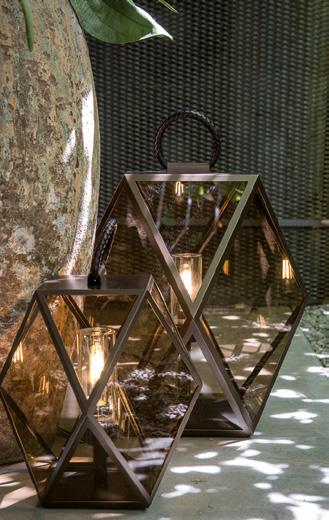






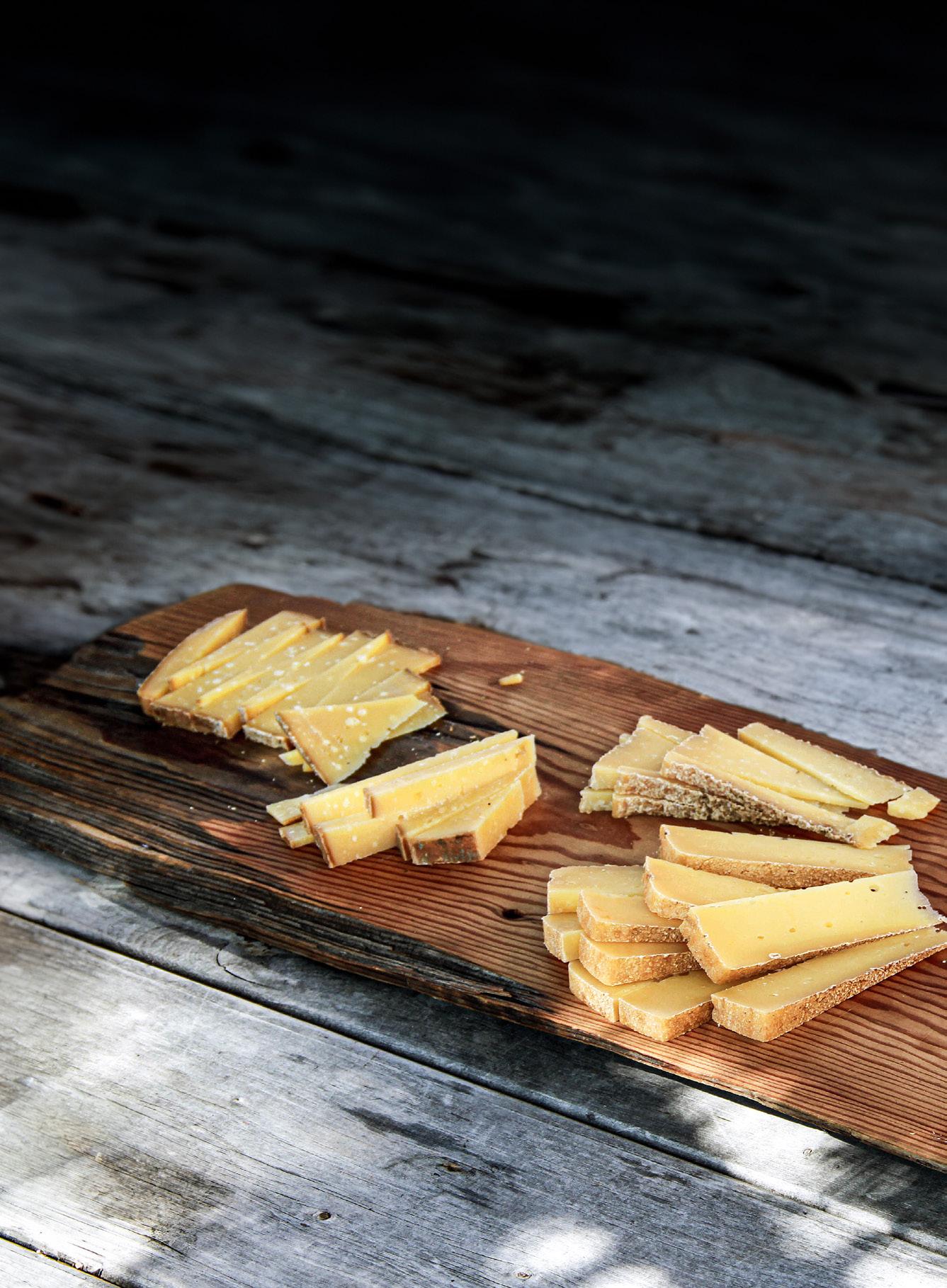
Quando il formaggio punta in alto Cheesy heights
Ein Aufstieg durch den Wald und über den Forstweg, entfernt klingen Kuhglocken und die Sonne scheint. Eine letzte Kurve noch und da ist sie – die Penaud Alm im Schnalstal, das Ziel unserer Wanderung. Malerisch eingebettet liegt die höchste Sennalm Südtirols in einem kleinen Kessel auf 2323 m. Sie wird seit rund acht Jahren mit viel Leidenschaft von Felix Trientbacher und Maria Linser geführt. Wir durften sie bei ihrer inspirierenden Arbeit begleiten.
Una salita lungo una strada forestale nel bosco, dei campanacci in lontananza, il sole splendente, un’ultima curva ed eccola, la nostra meta dell’escursione: la pittoresca Malga di Pinalto in Val Senales. Si tratta dell’alpeggio

più in quota dell’Alto Adige, a 2323 m, e viene gestito con immensa passione da ben otto anni da Felix Trientbacher e Maria Linser. Li abbiamo potuti accompagnare durante i loro lavori quotidiani.
An ascent through the woods and along the forest path. Cowbells are ringing somewhere in the distance and the sun is shining. One last turn and there it is – the Penaud Hut in the Senales Valley, the final destination of our hike. South Tyrol's highest dairy hut is picturesquely nestled in a small basin at 2,323 m above sea level. It has been run with great dedication by Felix Trientbacher and Maria Linser for around eight years. We had the pleasure of shadowing them in their inspiring work.
Sie sagen Cheese:
Felix und Maria widmen ihre Zeit und Liebe dem Käse. Mit Erfolg!
Cheeeeese!
Felix e Maria si dedicano al formaggio con passione… e con successo.
Say Cheese:
Felix and Maria have devoted their love and energy to cheese. With great success!

Für Felix ist es bereits der 31. Almsommer. Das Leben auf dem Berg kennt er schon, seit er ein kleiner Bub war. Auch das Käsen gehört für ihn zum Leben dazu und schon fast ein Jahrzehnt teilt der 40-Jährige diese Leidenschaft mit Maria, mit der zusammen er nun jeden Sommer auf die Alm zieht. Es ist ein Leben von und mit der Natur, das man lieben muss. Ist die Almidylle doch auch stets mit viel Arbeit und mit langen Tagen verbunden.
Noch vor Sonnenaufgang ist bereits geschäftiges Treiben vor dem Fenster zu hören. Philipp, der Hirte der Penaud Alm, holt die Tiere zum Melken in den Stall. Die Kühe bleiben immer draußen, außer bei Schlechtwetter, und werden nur zum Melken eingeholt. Dadurch müssen die rund 25 Rinder auch nicht zugefüttert werden und in der Milch steckt die ganze Kraft und Natürlichkeit der Alm. In der Philosophie von Felix und Maria dreht sich vieles, wenn nicht sogar alles, um die Abläufe der Natur und wie diese unser Tun beeinflussen. Das merkt man auch, wenn man Felix in der Sennerei über die Schulter blicken darf. Dort treffen wir ihn gerade, als er die frische Milch vom Stall in den Kessel fließen lässt. Hier
wird diese nun mit der Milch vom Vorabend gemischt und erhitzt. Rund 250 l Milch kommen heute zusammen, an ganz besonders guten Tagen sind es auch manchmal über 400 l. Für 1 kg Käse braucht es ungefähr 10 l Milch. Ein Laib vom Bergkönig, wie er bei den Cheese Awards zur Verkostung kommt, wiegt am Ende um die 25 kg.
Wie viele Liter letztlich im Kessel landen, hängt auch mit dem Futter der Tiere zusammen. Da dieses auf der Penaud Alm kaum von Menschenhand beeinflusst wird, ist auch der Milchertrag nicht jeden Tag gleich. Mit dem heutigen Ertrag beginnt Felix mit den ersten Schritten der Käseproduktion, während Philipp die Kühe wieder auf die Weide zurückschickt. Dabei wird von Tag auf Nacht immer wieder die Weide gewechselt.
„Wenn man sich auf die Energien der Natur einlassen kann und mit ihnen arbeitet, dann profitiert auch das Endprodukt davon – in unserem Fall der Käse.“
In der weiteren Verarbeitung wird jeder Schritt genauestens protokolliert. Wie die Produktion genau verläuft, ist aber von verschiedenen Faktoren abhängig. Felix möchte mit uns heute einen großen Laib herstellen, doch ob ihm das gelingt, kann er erst im Verlauf genau sagen. Die Käseherstellung in dieser Form ist ein Handwerk des Fühlens und Spürens. Ein Naturprodukt wie Milch verhält sich nicht immer genau gleich. Vor allem, da in kleinen Manufakturen im Gegensatz zu den großen industriellen Produktionen noch mehr Freiheit für den natürlichen Lauf der Dinge besteht. Das ist für Felix auch ein wichtiger Aspekt seiner Arbeit: Was die Natur mit sich bringt, damit wird gelebt und produziert. Wenn also die Milchmenge oder der Käsebruch nicht ganz so sind, wie er es für den großen Laib braucht, dann werden es eben mehrere kleine Käselaibe. Felix zeigt uns seine Schatzkammer mit allen Käsen, die in den letzten Wochen hergestellt wurden, sowie ein paar Laiben, die hier schon deutlich länger lagern. Darunter auch der „Bergkönig Gran Riserva“ von 2021, der von den Juroren des World Cheese Awards 2023 in Norwegen mit Gold ausgezeichnet wurde.
„Käse vom Fließband ist nichts für mich. Ich will etwas Eigenes erzeugen und auch immer Neues ausprobieren. Mein Käse soll Charakter und Wiedererkennungswert haben.“
Nach dem Hinzufügen des Labs, einem natürlichen Enzym aus der Wachstumsdrüse des Kalbs, beginnt die Verdickung des Käses. In dieser Phase der Herstellung ist es besonders wichtig, dass im Raum idealerweise etwa 30 Minuten lang absolute Ruhe herrscht. Bereits Schwingungen beim Sprechen können den Prozess beeinflussen.
Nach dieser Ruhepause ist die Milch zu einer puddingartigen Konsistenz, der sogenannten Gallerte, geronnen, der wir uns nun wieder widmen können. Mit einer großen Käseharfe schneidet Felix die Masse in Stücke, dem sogenannten Käsebruch. Über die Stückgröße kann nun auch wieder das finale Produkt beeinflusst werden. Je gröber der Bruch, desto weicher wird der Käse. Für den Almkäse von Felix brauchen wir einen eher kleinen Bruch. Unter ständigem Rühren schöpft er immer wieder etwas ab, überprüft die Konsistenz und den Geschmack, bis sie genau seinen Vorstellungen entsprechen. Sobald dieser Moment gekommen ist, wird der Bruch aus dem Kessel gelassen und durch ein feinmaschiges Tuch von der Molke getrennt. Nun folgt ein echter Kraftakt, denn die Masse muss mitsamt dem Tuch aus dem Auffangbecken in die Käseform gehievt werden. Dort auf dem Tisch lässt sich nun zum ersten Mal erahnen, dass daraus irgendwann ein Käselaib wird. Mit einer selbstgebauten Presse wird überschüssiges Wasser aus dem Laib gedrückt, welcher nun regelmäßig gewendet werden muss. Vom Melken bis zum Laib dauert der Prozess etwa vier Stunden. Der frische Käse wird am Tag darauf zum Auskühlen in den Keller gebracht. Nach 48 Stunden kommt er in ein Salzbad, wo er für eine Woche bleibt und woraufhin er auf den Holzbrettern im Keller lagert und jeden Tag geschmiert wird. Seine endgültige Genussreife erreicht ein Laib erst nach einem Jahr.

Unter dem Himmel: Wie eine kleine Insel liegt die Alm zwischen den Berggipfeln.
Più su, solo il cielo: la malga, cinta da imponenti vette, è la più alta dell’Alto Adige.
Beneath the sky: the hut is nestled in between the peaks like a little island.
Nach der Arbeit sitzen Felix, Maria und Philipp zusammen am Tisch, lassen das Getane Revue passieren, planen voraus und genießen die wärmende Sonne auf der Almterrasse. Von hier aus kann man Schwein Roland und seine Gattin Eileen mit den drei kleinen Schweinchen beim Suhlen im Schlamm beobachten oder die Vielfalt der Hühner im großen Gehege bewundern. Auch die Almkatze gesellt sich zu uns und lässt sich die Sonne auf den Pelz scheinen. Das Leben auf der Alm tut allen gut.
Für die Menschen hier bedeutet es auch, Abstriche zu machen. Hier gibt es keinen alltäglichen Luxus, der im Tal als ganz normal betrachtet wird. Man kann nicht eben mal in die Stadt, um etwas einzukaufen, Mobilfunknetz und Internet sind nur an wenigen Stellen am Haus und dann auch nur dürftig nutzbar. Wobei es für die drei Almler eher ein Luxus und ein Privileg ist, mit diesen Abstrichen zu leben, denn es sind alles verzichtbare und im Leben eigentlich nicht notwendige Dinge. Felix, Maria und Philipp leben hier auf engem Raum wie eine Familie zusammen, aber zum Streiten oder für Langeweile gibt es hier sowieso wenig Zeit. Es ist immer etwas zu tun. Während Felix den Käse produziert und die Alm organisiert, bewirtet Maria die Wanderer, schmeißt Küche und Gästezimmer. Philipp betreut die Tiere und kümmert sich um den Stall. Ist Not an Mann oder Frau, helfen sie sich gegenseitig. Trotz der harten Arbeit und des Verzichts, können sich Felix und Maria kein schöneres Leben vorstellen und so zieht es sie Jahr für Jahr wieder auf die Alm. Wo nicht nur der Käse hoch hinauswill, sondern auch sie mit ihm.
Per Felix questa è ormai la trentunesima estate in alpeggio. La trascorre ogni anno su in montagna da quando era bambino. Anche la produzione di formaggio è parte intrinseca della sua vita e da quasi un decennio condivide questa passione con Maria, che ora gestisce con lui la Malga di Pinalto, o Penaud in tedesco. Un’occupazione a stretto contatto con la natura, che bisogna amare con tutto il cuore. Perché non si tratta solo di godersi i paesaggi idilliaci, qui le giornate sono lunghe e il lavoro è duro.
Ancora non è l’alba e, oltre la finestra, già si percepiscono dei rumori. Philipp, il pastore, sta radunando le mucche in stalla per la mungitura, l’unico momento della giornata in cui vengono rinchiuse, altrimenti rimangono sempre all’aperto – salvo in caso di maltempo. Pascolando solo erba, senza ricevere foraggi addizionali, le circa venticinque vacche danno un latte naturale di alta qualità ricco di aromi e proprietà. Felix e Maria, infatti, abbracciano una filosofia in totale sinergia con la natura, e si nota anche osservando il quarantenne all’opera in caseificio. Quando entriamo, sta versando il latte della mattina nella caldaia, dove viene miscelato con quello munto la sera precedente e riscaldato. In totale, oggi Felix lavora attorno ai 250 l di latte, ma nei giorni più produttivi ne può avere fino a 400 l. La quantità non è mai uguale perché dipende dall’erba che gli animali hanno trovato, visto che per scelta i gestori decidono di intervenire il meno possibile con mangimi.
Per ottenere un chilo di formaggio, occorrono all’incirca dieci litri di latte. Se calcoliamo che una toma del tipo Bergkönig – come quello presentato ai Cheese Awards – pesa 25 kg, servirebbe tutto il latte odierno per realizzarla. Mentre Felix comincia con la caseificazione, Philipp rimanda le vacche al pascolo, avendo cura di cambiare zona rispetto a dove hanno mangiato la notte.
“Se si lavora in sinergia con la natura, la qualità del prodotto finale – nel nostro caso, il formaggio – ci guadagna sicuramente.”
Ogni passaggio della caseificazione viene meticolosamente protocollato. Tuttavia, il processo è condizionato da vari fattori e solo alla fine si può sapere con esattezza quale sarà il risultato. Oggi, ad esempio, Felix vuole realizzare un’unica grande toma, ma deciderà se è davvero fattibile in corso d’opera, attraverso una continua valutazione sensoriale ed estrema sensibilità. A differenza della produzione industriale, in quella artigianale si lascia la natura libera di esprimersi: ogni giorno, il latte presenta proprietà leggermente diverse e va lavorato di conseguenza. Se, per dire, è troppo poco oppure la consistenza della cagliata non appare adatta per una forma grande, allora si opta spontaneamente per farne tante più piccole. Il casaro ci mostra anche la sua camera dei tesori, la cantina con tutto il formaggio prodotto nelle ultime settimane, così come un paio di tome a lunga stagionatura. Tra queste figura il Bergkönig Gran Riserva del 2021, che è stato insignito della medaglia d’oro ai World Cheese Awards 2023 tenutisi in Norvegia.

Glück und Ruh liegt auf dem Rücken der Kuh. Sie ist hier der eigentliche Star.
Le vere star: le mucche, pascolando libere quassù, producono latte di alta qualità.
Happiness now can be found on the back of a cow. She is the real star here.
“Fare formaggio come nella grande distribuzione non mi si addice. Desidero sperimentare, creare prodotti con un carattere proprio. Il mio formaggio deve essere riconoscibile.”
Dopo l’aggiunta del caglio, un enzima naturalmente presente nell’abomaso dei vitelli lattanti, comincia la coagulazione del latte. In questa fase, della durata di circa mezz’ora, è fondamentale che nell’ambiente regni la calma assoluta; già le frequenze emesse parlando potrebbero influenzare il processo. Dopo il riposo, il latte ha una consistenza simile al budino e la cosiddetta cagliata viene quindi rotta con la lira in pezzi. La loro dimensione dipende dal formaggio che si vuole ottenere: più grossi si lasciano, più la pasta sarà morbida. Per il formaggio di malga prodotto da Felix, invece, occorre tagliare la massa in piccoli grani. Agitando la cagliata, lui ne preleva ripetutamente qualche pezzettino per controllare la consistenza e il sapore, fino a quando non trova sia arrivato il momento ideale per l’estrazione. Per farlo, apre la manopola dello scarico e lascia fuoriuscire il contenuto in un telo a maglia fine adagiato sul tavolo spersore, di modo da separare la parte solida dal siero. Quindi, con non poca forza, il telo con la cagliata dev’essere sollevato e riposto nell’apposita forma cilindrica, dove viene pressato con un marchingegno costruito da Felix per eliminare il liquido in eccesso. Solo ora, dopo circa quattro ore, si riesce a intuire che quel latte sta diventando in qualche modo formaggio. Infine, le tome fresche vanno rivoltate a intervalli regolari nell’arco della giornata. Se all’inizio devono stare al caldo, il mattino seguente le forme vengono spostate in cantina a raffreddarsi. Trascorse quarantott’ore, il formaggio viene immerso in un bagno di sale, dove rimarrà per una settimana. Dopodiché, viene adagiato su assi in legno in cantina per il processo di stagionatura e spazzolato quotidianamente con una soluzione di acqua, sale e siero. Occorre almeno un anno prima che sia davvero maturo per il consumo.
Dopo aver svolto i propri compiti della mattina, Felix, Maria e Philipp si siedono insieme al tavolo all’aperto, si godono il sole e pianificano i prossimi impegni. Dalla terrazza davanti alla malga, si può osservare il maiale Roland con la consorte Eileen e i loro tre porcellini rotolarsi nella terra oppure meravigliarsi delle diverse specie di galline nell’ampio recinto. Anche il gatto di casa si accomoda di fianco a noi e si lascia accarezzare la pelliccia dai caldi raggi. Ah, com’è bella la vita in alpeggio! Tuttavia, essa comporta anche dei sacrifici. Quassù non ci sono i comfort moderni, dati per scontati
a valle. Non si può fare spontaneamente un salto in città per comprare qualcosa, il segnale telefonico o internet sono fruibili in misura limitata e in punti precisi. In realtà, per Felix, Maria e Philipp è proprio questo il vero lusso, mentre considerano gli aspetti citati prima non del tutto indispensabili. I tre vivono in uno spazio ristretto come una famiglia, ma qui tempo per litigare non ce n’è, e tantomeno per annoiarsi. Anzi, c’è sempre qualcosa da fare. Se Felix si occupa del formaggio e dell’organizzazione generale, Philipp si prende cura degli animali e della stalla, mentre Maria cucina per gli escursionisti e sistema le camere. In caso di necessità, si aiutano reciprocamente. Nonostante il duro lavoro, Felix e Maria non potrebbero desiderare vita migliore e così, estate dopo estate, salgono su in malga, puntando in alto anche con il loro formaggio.
This is already Felix's 31st summer on an Alpine pasture. He's known life on the mountain ever since he was a little boy. Cheesemaking is another integral part of his life. The 40-year-old has been sharing this passion with Maria for almost a decade. Together they spend every summer on the high mountain meadows. It's a life lived with and in nature – a lifestyle you have to love. The idyllic Alpine pasture is always accompanied by many long days of hard work.
You can already hear the hustle and bustle outside the window before sunrise. The shepherd of the Penaud Hut, Philipp, brings the cattle into the barn for milking. Unless the
weather is bad, the cows always stay outside and are only brought in to be milked. What this means for the around 25 animals, is that they do not need to be fed and the milk contains all the power and natural flavours of the Alpine pasture. The philosophy of Felix and Maria revolves mainly, if not entirely, around the processes of nature and how they influence our actions. This also becomes obvious when you have the chance to look over Felix's shoulders in the dairy. We meet him there just as he is pouring the fresh milk from the cowshed into a kettle. He mixes it with the milk from the previous evening and heats it. Around 250 l of milk have been produced today, and on particularly good days it can sometimes be over 400 l. You need approximately 10 l of milk to make 1 kg of cheese. A wheel of “Bergkönig" cheese, as used for tasting at the Cheese Awards, usually weighs around 25 kg.
The number of litres that ultimately end up in the vat also depends on the animals' feed. As this is virtually unaffected by human activity on the Penaud Hut, the milk yield also differs from day to day. Felix begins the first steps of cheese production with today's yield, while Philipp sends the cows back out to the pasture. The grazing pasture is continually changed from day to night.
“If you can engage with the forces of nature and work with them, then the end product also benefits - which in our case is the cheese.”

Die Schatzkammer: Hier lagert der ganze Geschmack der Alm.
La camera dei tesori: qui le preziose tome di formaggio sviluppano il loro aroma.
The treasure trove: this is where the alpine flavours are stored.
During the subsequent processing stage, every step is precisely recorded. However, the exact production process depends on various factors. Felix aims to make a large wheel of cheese with us today, but he will only be able to find out if he succeeds as he goes along. Cheese production in this form is a craft of intuition and feeling. A natural product like milk does not always behave in the same exact way. This is especially true in small production facilities, where there is more freedom for the natural course of things than in large industrial production facilities. For Felix, this is also an important aspect of his work: what nature provides is what he lives with and then produces with. So if the quantity of milk or the cheese curd is not quite enough to make a large wheel, he simply makes several small wheels of cheese. He shows us his treasure trove: all the cheeses that have been produced in recent weeks, including a few wheels that have been stored here for considerably longer. These include the “Bergkönig Gran Riserva” from 2021, which was awarded gold by the judges of the 2023 World Cheese Awards in Norway.
“Cheese from the production line is not my thing. I want to create something of my own and always experiment with new things. My cheese should have character and be recognisable.”
After adding the rennet, a natural enzyme extracted from the calf's growth gland, the cheese begins to thicken. During this phase of production, it is particularly important that the room is kept absolutely quiet, ideally for around 30 minutes. Even the vibrations caused by talking can influence the process. After this quiet interval, the milk coagulates into a pudding-like consistency, the so-called coagulum, which we can now focus on. Felix uses a large cheese harp to cut this mass into pieces, known as cheese curds. The final product can now also be influenced by the size of these curd pieces. The coarser the cheese curd, the softer the cheese will be. For Felix's Alpine cheese, we need a rather fine curd. Stirring constantly, he keeps skimming off a small amount, checking the consistency and flavour until it is exactly, as he wants it. As soon
as that point is reached, he releases the curd from the vat and separates it from the whey using a fine-meshed cloth. This is followed by a real feat of strength: the curd and the cloth must be lifted out of the collecting basin and into the cheese moulds. On the table, we get our first glimpse of what will eventually become a wheel of cheese. A home-made press is used to squeeze excess water out of it, which then needs to be turned regularly. The process – from milking the cows to the finished cheese wheel – takes around four hours. The next day, the fresh cheese is taken to the cellar to cool off. After 48 hours, it is placed in a salt bath. It remains there for a week, after which it is stored on the wooden boards in the cellar and is lubricated every day. A wheel only reaches its final ripeness for consumption after a year.
Once the work is done, Felix, Maria and Philipp sit at the table together. They review what they have done, plan for the future and enjoy the warm sunshine on the Alpine terrace. One can watch Roland the pig and his wife Eileen with their three little piglets wallowing in the mud. One can also marvel at the large variety of chickens in their spacious enclosure. The hut's cat joins us and lets the sun shine on its fur. Life on the mountain pasture is good for everyone.For the people up here, this also means making sacrifices. There are no everyday luxuries here that are considered normal down in the valley. You can't just pop into town to buy something. Mobile phone coverage and internet is only available at a few points around the house and even then only to a limited extent. However, for the three Alpine residents, it is more of a luxury and a privilege to live with these compromises. After all, they are unnecessary and not really essential things in life. Felix, Maria and Philipp live together like a family in a small space, although there is little time to argue or be bored around here anyway. There is always something to do. While Felix produces the cheese and manages the Alpine pasture, Maria entertains the hikers and runs the kitchen and guest rooms. Philipp looks after the animals and tends to the stables. Whenever they need help, they lend each other a hand. Despite the hard work and sacrifices, Felix and Maria can't imagine a better life. Year after year, they are drawn back to the mountain pasture, where they too want to reach new heights with their cheese.
Für ihren gereiften Bergkäse konnten
Felix und Maria nun bereits viermal bei den World Cheese Awards abräumen. Bei diesem globalen Käse-Event treten jährlich über 4000 Käseproduzenten aus mehr als 40 Nationen im Geschmacksvergleich gegeneinander an.
Con il loro formaggio d’alpeggio stagionato
Felix e Maria hanno ottenuto ben quattro medaglie ai World Cheese Awards. A questa competizione mondiale sul formaggio, ogni anno partecipano oltre quattromila produttori provenienti da più di quaranta nazioni.
To date, Felix and Maria have won the World Cheese Awards four times with their mature mountain cheese. This global cheese event sees over 4,000 cheese producers from more than 40 nations compete against each other in an annual comparison of flavours.









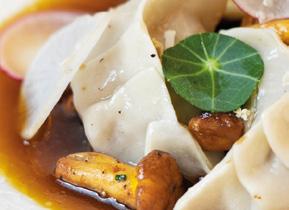
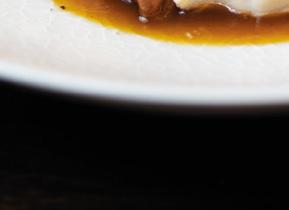
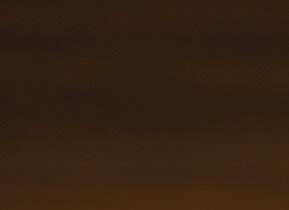




ZWEI BRÜDER, EIN ZIEL, GUTER GESCHMACK GUTES GEFÜHL!
DUE FRATELLI, UN OBIETTIVO: GUSTO E BENESSERE

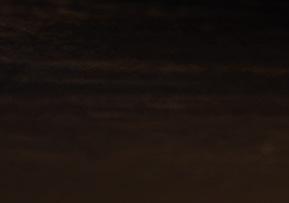
TWO BROTHERS, ONE GOAL: GOOD TASTE, GOOD FEELING!





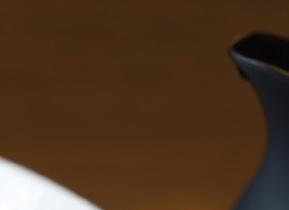


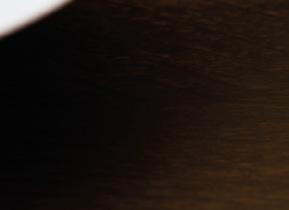



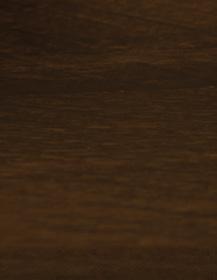




„SCHAU MAL, EIN MURMELTIER!!! HALLO MURMELTIER!!!“ Eigentlich bräuchte es noch fünf weitere Ausrufezeichen, um den Jubelruf des kleinen Jungen wiederzugeben. Wahrscheinlich brachte er mit seiner Stimme sogar die Fenster weit unten im Grödnertal zum Bersten. Am liebsten würde ich dem Murmeltier in seinen Bau folgen, um mich mit ihm vor unseren lauten Zeitgenossen zu verstecken. Stattdessen bleibe ich mit meinem Feldstecher in der Hand auf dem kleinen Felsen inmitten der Almwiese sitzen. Ich stelle mir vor, wie Vater und Mutter Murmel mit ihren Kindern tief unter der Erde über die Zukunft debattieren. Über die zweibeinigen Störenfriede und darüber, dass die Sommer auf der Seceda immer heißer werden. Die Hitze zwingt die Nagetiere, den Großteil des Tages im Bau zu verbringen. Dass dadurch die Zeit knapp wird, sich genügend Fettreserven für den Winter anzufressen, wissen die wenigsten. Dabei verlieren sie während des Winterschlafs rund ein Drittel ihres Gewichts! Sie überlegen, umzuziehen. Höher hinauf müssten sie, doch nicht weit hinter ihrem Bau strecken sich die Dolomitenwände in den Himmel. Da bleibt nichts, außer zu hoffen. Zu hoffen, dass die Menschen dem Klimawandel entgegenwirken – und die Stille der Natur beim Wandern wertschätzen.
“GUARDATE, UNA MARMOTTA!!! CIAO MARMOTTIIINA!!!” In realtà, servirebbero molti altri punti esclamativi per rendere il tono di voce del ragazzino alla vista del peloso animale: gridava talmente forte da frantumare persino i vetri delle finestre giù in Val Gardena. Avrei voluto seguire la marmotta nel suo buco e nascondermi dai miei chiassosi simili. Ma sono rimasta seduta sul masso che mi ero scelta per osservare i paesaggi del Seceda con il binocolo, in silenzio. Mi immaginavo mamma e papà marmotta sottoterra con i loro figli a discutere con preoccupazione del futuro, dei seccatori a due gambe e delle estati sempre più afose. In pochi, infatti, sanno che il caldo costringe i roditori a trascorrere la maggior parte della giornata nella tana e che, di conseguenza, hanno meno tempo
per nutrirsi e accumulare riserve di grasso per l’inverno. E queste sono invece fondamentali, perché durante il letargo le marmotte arrivano a perdere un terzo del loro peso! Potrebbero valutare di scavare la propria casa più in quota, al fresco, tuttavia poco dietro ci sarebbe la roccia delle Dolomiti. E allora non resta che sperare: sperare che gli umani contrastino il cambiamento climatico e imparino a trattare la natura con il dovuto rispetto durante le loro escursioni.
“LOOK, A GROUNDHOG!!! HELLO GROUNDHOG!!!” It would actually take five more exclamation marks to convey the little boy’s shriek of joy. His voice probably even shattered the windows way down in Gardena Valley. I would have loved to follow the little marmot (as groundhogs are called in the Alps) into its burrow and hide from our noisy contemporaries. But instead I keep sitting on the small rock in the middle of the alpine meadow holding my binoculars in my hands. I imagine how the marmot parents are debating the future with their children, deep underground. They discuss the two-legged troublemakers and the fact that summers on the Seceda are getting hotter and hotter. The heat forces these rodents to spend most of the day in their burrows. What few people realise is that this means that there is not enough time to build up sufficient fat reserves for the winter. Indeed, they lose around one third of their bodyweight during hibernation! They are considering moving. They would need to move higher up, but not far behind their burrow the Dolomite walls stretch up into the sky. There is nothing left to do but hope. Hope that people will counteract climate change – and appreciate the tranquillity of nature while hiking.


THE ART OF DESIGN

Streben nach Perfektion und Authentizität begleitet von einem ausgeprägten Gespür für Material, Form und Nutzung: Der gebürtige Brixner Luca Martorano erschafft Werke, die höchste Ansprüche erfüllen: Design und Kunst verschmelzen und werden eins.
La ricerca della perfezione, l’autenticità e uno spiccato senso per i materiali, le forme e la funzionalità: ecco cosa contraddistingue le creazioni di alta qualità del designer di origine brissinese Luca Martorano, nelle quali design e arte si fondono.
The pursuit of perfection and authenticity is accompanied by a keen sense for materials, shapes and function: Bressanone-born Luca Martorano creates pieces that fulfil the highest demands. Design and art merge to become one.


Die Designs aus Luca Martoranos Hand werden von den prestigeträchtigsten Marken umgesetzt. Die renommierten italienischen Fahrradhersteller Bianchi und Cinelli sind nur einige davon. Der 43-Jährige hat in den nunmehr 18 Jahren seiner Aktivität unzählige Preise dafür erhalten. Dabei setzt er auf Präzision ohne Schnickschnack.
Es geht dem Wahl-Bozner darum, das purste Design zu finden, das ein Material, eine Funktion oder die Form zum Star macht. Gleichzeitig folgen seine Objekte genauso konsequent den Gesetzen der Funktionalität: Möbel, Wohnaccessoires, Textildesigns und Fahrräder entstehen dabei. Mittlerweile arbeitet er gemeinsam mit seinem in der Toskana ansässigen Kompagnon Mattia Albicini im Team: ihr Unternehmen „Draw Studio“.
Derzeit entsteht in der Nähe der Altstadt in Bozen ein zweites eigenes Studio für die Designer. „Es ist mir wichtig, dass unsere Objekte auch gesehen und bekannt werden können“, sagt er. Wobei das gerade bei seinen neuesten Werken nicht einfach ist. Die Maße sind monumental, passend zum verwendeten Material: Tische, Lampenschirme und Stühle aus massivem Stein, die vom Designkünstler so vor einem Spiegel angeordnet werden, dass sie sich
optisch bis in die Unendlichkeit vervielfachen. Passenderweise heißt sie „Beyond“, so viel wie „Darüber hinaus, jenseits“. 6 m lang ist diese Skulptur, wie er sie selbst nennt, geschaffen mit dem weltweit tätigen Naturstein-Unternehmen Bagnara mit Sitz in Eppan. Martorano geht damit einen weiteren Schritt weg von der an der Funktionalität orientierten Designwelt hin zur Kunst. Bearbeitet werden die Platten einzeln per Hand, was ihm wichtig ist. Jüngst gewann er bei „A Matter of Stone“ (Eine steinerne Angelegenheit) den ersten Preis der renommierten Fachzeitschrift „Elle Decor“, die dem Projekt auch einen Artikel gewidmet hat.
Viele der Werke Martoranos, der sein Studium an der Architektur- und Designfakultät des Politecnico in Mailand magna cum laude abschloss, sind hochdekoriert. Dazu gehört auch „Folio“, ein Tisch, der in verschiedenen Metallarten gefertigt werden kann: Er wurde mit dem „Archiproducts Design Award“ und bei den „Wallpaper Design Awards“ gewürdigt. Inspiriert ist der Tisch von aufgestellten, gegeneinander gelehnten Papierbögen, damit das Material am besten zur Geltung kommt, in diesem Fall poliertes und geschwärztes Messing. Durch die Vielseitigkeit der verwendbaren Materialien entfaltet sich eine vollkommen andere Wirkung. An diesem Beispiel zeigt
sich auch die Herangehensweise an die Arbeiten von „Draw Studio“. Sie interessieren sich für Metall, Holz, Glas und Stein. „Wir streben nach dem Besten und haben uns auf die unterschiedlichsten Sektoren spezialisiert. Wir suchen nach den Experten auf ihrem Gebiet und mit diesen wollen wir eine profitable und dauerhafte Beziehung aufbauen, immer einen Schritt weiter als das, was sie bisher erlebt haben“, erläutert Martorano. Nachdem die Idee entstanden ist, bieten sie sie dem Partner, der die Idee umsetzt und produziert, an. „In der Zwischenzeit ist es zum Glück auch so, dass wir von Produzenten angesprochen werden. So war es auch im Fall des Tisches für die Firma DeCastelli, die Vorreiter in der Metallverarbeitung in Italien ist“, sagt er. Die Expertise des Wahl-Bozners ist übrigens auch an der Uni Bozen gefragt: Von 2014 bis 2021 arbeitete er an der Fakultät für Design und Kunst als Vertragsprofessor.
Martoranos Liebe gilt auch der Natur und den Pflanzen. Die Liebe zu allem, was grün ist, fließt in seine Arbeiten mit ein. So auch in ein besonderes Projekt: In Zusammenarbeit mit dem Architektenteam Barbara Breda und Markus Scherer entstand „The Chapel“, die Umgestaltung einer Kapelle im NOI Techpark in Bozen. „Die Aufgabe war, daraus einen

Mehrzweckraum für spezielle Meetings, aber auch für Aktivitäten zur Erholung zu machen“, erklärt der Designer. Sie wollten dabei den besonderen Kirchencharakter, die spezielle Aura des Ortes, wahren und in den Möbeln wieder aufgreifen. Ein nüchternes Design, das sich für verschiedenste Konstellationen von Personen eignet. So können die Tische je nach Personenanzahl zusammengefügt werden. Die perfekte Ausführung der Tischkanten zeigt auch hier wieder die absolute Liebe zum Detail und zur Perfektion, welche die Arbeiten des Designers auszeichnet. Dieses Projekt hat übrigens den ersten Platz des Architekturpreises Südtirol im Jahr 2020 gewonnen. Apropos Pflanzen: Sie überfluten die Kapelle. Sie werden von den Designern mit Leidenschaft ausgewählt. „Sie sind nicht nur Dekoration, sondern tragen zur Verbesserung der Raumqualität bei und machen die Umgebung angenehm, lebendig, gesund, reich und besonders“, beschreibt der dunkelhaarige, großgewachsene Martorano. Kurz gesagt, die Begrünung ist ein eigenständiges Gestaltungsmittel, sowohl innerhalb als
Im NOI Techpark wurde eine Kapelle umgestaltet.
Nel parco tecnologico NOI Techpark è stata ristrutturata una cappella.
A chapel was redesigned at the NOI Techpark.
auch außerhalb von Wohnräumen, und nimmt in seinen Projekten einen privilegierten Platz ein. „Das Grün ist einer der Gründe, warum ich mich entschieden habe, in Südtirol zu leben“, erklärt er – immerhin hatte er nach seinem Studium viele Jahre in London und Mailand gelebt und gearbeitet. Den Kontakt mit der Natur, dem Wald und den Bergen empfindet er als wahrhaft nährend. Kreativität, Design und die Passion fürs Planen und Produzieren stehen in ständigem Gegensatz zur Idee der Natur, der Stille und Unberührtheit, wie zwei Seiten einer Medaille. „Ich lebe auf der Suche nach einem Gleichgewicht zwischen diesen beiden gegensätzlichen Polen: natürlich und künstlich. Kontemplation und Kreation“, erzählt er.
Seine Liebe zur Natur kann der Wahl-Bozner auch bei seiner Lieblingssportart ausleben: dem Radsport. Deshalb liegt ihm auch das Fahrrad als Objekt sehr am Herzen. Er hat für die renommierten und bekannten Marken Italiens, für Bianchi in der Vergangenheit und für Cinelli in den letzten Jahren, bereits mehrere Fahrräder und Komponenten designt. „Es ist spannend, wenn man Radfahrer damit auf der Straße sieht“, berichtet er. Beobachten, wer sie sind, wie sie aussehen, wie sie damit umgehen, interessiert ihn. Die Nutzer seiner Möbel bekommt er seltener zu Gesicht.
Zusätzlich zu den Katalogmodellen sind noch drei personalisierte entstanden. Eines davon

„The Chapel“ von innen – wie aus einer Kapelle ein Multifunktionsraum wurde.
Gli spazi interni di “The Chapel” sono ora adibiti a sala polifunzionale.
The interior of “The Chapel” –turning a chapel into a multifunctional space.
nutzt er auch selbst: Mark I, ein Gravel-Bike. Es entstand auf Basis des Zydeco King Rahmens, den sie für Cinelli entwarfen. Er erhielt im Jahr 2020 den „ADI Design Index“, eine weitere Auszeichnung auf der langen Liste des Teams. Nicht nur die Linie und die gewählten Komponenten entsprechen den ästhetischen und funktionellen Ansprüchen Martoranos, auch die Farbpalette wurde sorgfältig gewählt und geht von Lagoon Blue über Moosgrün und Lava-Grau. Wichtig war ihnen, alle überflüssigen graphischen Elemente, wie etwa Schriften auf den Komponenten, die typisch für den Rennsport sind, wegzulassen. Dadurch stehen fließende Formen, Oberflächenbeschaffenheit und das Gesamtbild im Vordergrund. Es versteht sich von selbst, dass die Farbe, die Optik und spezielle Zusammensetzung der Lackierung in aufwendiger Recherche von ihm auserkoren wurden. Im Fahrrad findet Martorano auch beide Welten, die ihn interessieren, vereint: „Es ist ein Objekt, mit dem man die Natur in der Stille und mit Respekt erkunden kann“, ist er überzeugt.
I progetti di design firmati Luca Martorano sono stati realizzati dai più prestigiosi marchi. I rinomati produttori di biciclette Bianchi e Cinelli, orgoglio nazionale, sono solo alcuni esempi. In diciott’anni di attività, il bressanonese di nascita ha già vinto innumerevoli premi. Per le sue opere, punta sulla precisione assoluta, funzionale e senza fronzoli. L’obiettivo del quarantatreenne è quello di definire un linguaggio pulito, che metta in evidenza una funzione, un materiale o una forma. Inoltre, ama seguire la logica dell’utilità, creando oggetti come mobili, complementi per la casa, arredi tessili e biciclette. Oggi, lavora insieme al suo socio Mattia Albicini, residente in Toscana, con il quale ha fondato il Draw Studio.
Attualmente, il duo sta allestendo un secondo atelier, nei pressi del centro storico di Bolzano. “Per me è importante che i nostri oggetti possano essere esposti e, quindi, visti”, afferma. Tuttavia, proprio nel caso dei suoi ultimi lavori, non è per nulla facile. Le dimensioni, infatti, sono spesso monumentali, in accordo con il materiale utilizzato: tavoli, sospensioni e sedie in pietra massiccia, sistemati davanti a uno specchio in modo tale che, per effetto ottico, paiono moltiplicarsi all’infinito. Non a caso, l’opera in questione si intitola “Beyond”, che in italiano significa “oltre”. La scultura – come lui stesso la definisce – è lunga sei metri ed è stata realizzata in collaborazione con l’azienda di estrazione e lavorazione di pietra naturale Bagnara, con sede ad Appiano e attiva a livello internazionale. Con questa creazione, Martorano si allontana dal design funzionale, avvicinandosi al mondo dell’arte. Le lastre vengono lavorate a mano, una per una – aspetto per lui
molto importante. Proprio in occasione del contest “A matter of stone” ha ricevuto di recente il primo premio dalla rinomata rivista Elle Decor, la quale ha poi dedicato un articolo al suo capolavoro in pietra.
Tra i progetti che si fanno notare di Luca Martorano, il quale vanta una laurea magistrale magna cum laude in Architettura e Design al Politecnico di Milano, figura anche “Folio”, un tavolo realizzato in metalli diversi, già insignito dei riconoscimenti “Archiproducts Design Award” e “Wallpaper Design Award”. Il tavolo si ispira a dei fogli di carta impilati l’uno sull’altro, così da risaltare con un gioco di luci e ombre la forza del materiale scelto, in questo caso l’ottone. Usando poi altri metalli, si otterrebbe ancora un effetto diverso, il che rende il prodotto davvero versatile. Inoltre, questo progetto esemplifica chiaramente l’approccio del designer e di Draw Studio: una grande attenzione per materiali autentici come metallo, legno, vetro e pietra. “Puntiamo solo al meglio, specializzandoci nei più svariati settori. Cerchiamo i massimi esperti in ciascun campo, con i quali costruire un rapporto proficuo e duraturo, compiendo sempre un passo avanti rispetto a quanto fatto finora. Una volta trovata l’idea, la proponiamo al partner più indicato per produrla. Talvolta, per fortu-
Klare Kante zeigt „Folio“, ein filigranst verarbeiteter Tisch aus Bronze.
Il tavolo in bronzo “Folio” affascina con le linee pulite e la finitura precisa.
“Folio”, a delicately crafted bronze table, shows clear edges.
na, capita anche che siano le aziende stesse a cercarci, come ad esempio nel caso del tavolo ‘Folio’ per DeCastelli, leader nella lavorazione dei metalli a livello italiano”, racconta l’artista. In aggiunta, le sue competenze sono richieste anche in ambito accademico, tanto che dal 2014 al 2021 ha insegnato come professore a contratto alla facoltà di Design e Arti dell’Università di Bolzano.
Un’altra passione di Martorano è la natura, che cerca sempre di includere nel proprio lavoro. Questo si nota ad esempio nel progetto “The Chapel”, che consisteva nella ristrutturazione di una cappella nel parco tecnologico NOI Techpark di Bolzano, curata insieme al team di architetti Barbara Breda e Markus Scherer. “Il desiderio della committenza era quello di trasformarla in una sala polifunzionale per riunioni e incontri, come anche per attività ricreative”, illustra. Si voleva preservare la speciale aura dell’ambiente originale e farla riecheggiare negli arredi. Un design sobrio e razionale, adatto a un pubblico ampio e a svariati utilizzi. I tavoli possono essere uniti a seconda del numero di persone; inoltre, la perfetta finitura dei loro bordi dimostra ancora una volta la precisione e l’assoluta attenzione al dettaglio che caratterizza il modus operandi del designer. Non a caso, questo progetto


si è aggiudicato il primo posto del Premio Architettura Alto Adige nel 2020 per la categoria “Interni”. Per tornare alla sua predilezione per il verde: nella cappella abbondano piante ed elementi vegetali. “Non sono mere decorazioni, ma contribuiscono a migliorare la qualità dell’aria e dell’ambiente, infondendo un’atmosfera piacevole, vivace, salutare e suggestiva”, racconta Martorano. In breve, ciò che è verde diventa a tutti gli effetti una componente di progetto e una fonte di ispirazione delle sue opere, sia per interni che per esterni. “La vicinanza alla natura è uno dei motivi principali che mi hanno spinto a tornare in Alto Adige, dopo aver vissuto e lavorato a Milano e a Londra per diversi anni”, rivela. Per lui, il contatto con i boschi e le montagne nutre l’anima – e la creatività. Quanto alla sua filosofia lavorativa, spiega di essere alla costante ricerca di un equilibrio tra visioni all’apparenza opposte: da un lato la contemplazione di ciò che è naturale e incontaminato, dall’altro la progettazione di inedite opere di design, appartenenti alla sfera artificiale.
L’altoatesino, alto e dai capelli scuri, ama godere delle bellezze naturalistiche di casa sulle due ruote, il suo sport preferito. Per questo motivo, si è occupato con entusiasmo anche di biciclette nel suo lavoro, disegnando componenti e interi mezzi per i più rinomati marchi italiani del settore, come Bianchi in passato e Cinelli più di recente. “È interessante incontrare in giro ciclisti in sella alle mie biciclette”, confessa. Gli piace osservare chi sono, che aspetto hanno e come usano il loro mezzo. D’altronde, solo più raramente gli capita di vedere gli acquirenti dei suoi mobili.
Oltre ai vari modelli di biciclette da collezione, ne ha creati tre personalizzati. Uno di questi per sé stesso: Mark I, una gravel bike elaborata sulla base del telaio Zydeco King disegnato per Cinelli, che nel 2020 si aggiudicò il premio “l’ADI Design Index” – un ulteriore riconoscimento sulla sua lunga lista. Non solo le linee e i componenti scelti rispecchiano gli ideali estetici e funzionali di Luca Martorano, anche i colori sono stati selezionati con cura: dal blu laguna al verde muschio fino al grigio lava. Per il designer era fondamentale omettere tutti gli elementi grafici su-
perflui, come le grandi scritte tipiche del ciclismo. In questo modo, vengono risaltate maggiormente le forme fluide, la finitura laccata e l’immagine nel suo complesso – tutte caratteristiche scelte dal designer dopo un’approfondita ricerca.
Das Gravel-Bike Mark I auf der Basis eines Cinelli-Rahmens erfüllt höchste Ansprüche.
La gravel bike Mark I, elaborata sulla base di un telaio Cinelli, soddisfa gli standard più elevati.
The Mark I gravel bike is based on a Cinelli frame and fulfils the highest standards.
Ecco, allora, che in un oggetto come la bicicletta si incontrano entrambi i mondi che più rappresentano Luca Martorano: un mezzo per esplorare la natura in silenzio e con rispetto, e nel quale far confluire il suo linguaggio formale e le sue visioni progettuali.
The designs created by Luca Martorano are produced by the most prestigious brands. The renowned Italian bicycle manufacturers Bianchi and Cinelli are just two of them. The 43-year-old has received numerous awards for his work in the 18 years of his career. He focuses on precision without any frills.
The Bolzano resident by choice is interested in finding the purest design that makes a material, a product, a shape – or indeed all three – the star. Simultaneously, his objects just as consistently follow the laws of functionality: furniture, home accessories, textile designs, bicycles and wheel rims are the result. These days, he works in a team with his Tuscany-based colleague Mattia Albicini. Their company is called “Draw Studio”.
He is also in the process of building a second design-studio for himself, close to the historic centre of Bolzano. “It’s important to me that our creations can also be seen and recognised,” he says. However, this is not easy, especially with his latest work. It has monumental dimensions to match the material used and consists of tables, lampshades and chairs made of solid stone, which the design artist arranged in front of a mirror in such a way that they are visually multiplied to infinity. Fittingly, it is called “Beyond”. The sculpture, as he
Farbe und Komponenten des Rades wurden sorgfältig gewählt.
I colori e i componenti della bicicletta sono stati studiati con cura .
The bike’s colour and components were carefully selected.


himself calls it, is 6 m long and was created with the globally operating company Bagnara, which is based in Appiano and specialises in quarrying, selling and processing natural stones. In doing so, Martorano is taking a major step away from the functionality-orientated world of design and moving towards art. The slabs are worked individually and by hand, which is very important to him. Recently, he won the first prize at “A Matter of Stone” from the prestigious trade magazine “Elle Decor”, which has also dedicated an article to the project.
A large number of Martorano’s works, a magna cum laude graduate of the Faculty of Architecture and Design at the Politecnico in Milan, have been highly acclaimed. These include “Folio”, a table that can be manufactured in different types of metal. It has been honoured with the “Archiproducts Design Award” and at the “Wallpaper Design Awards”. The table is inspired by sheets of paper propped up against each other to show off the material to its best advantage, which in this case is polished and blackened brass. A completely different effect unfolds thanks to the versatility of the materials that can be used. The approach to the work of Martorano and the “Draw Studio” team can likewise be seen in this example. They are interested in metal, wood, glass and stone. “We strive for the best and have become specialised in a wide variety of sectors. We look for the experts in their field and we want to build a profitable and lasting relationship with
„Opus Circle“ ist der Name dieses Bildes aus Stein, designt für Bagnara.
“Opus Circle” è il nome di questo quadro in pietra concepito per l’azienda Bagnara.
“Opus Circle” is the name of this artwork made of stone, designed for Bagnara.
them, always taking a step further than what they have experienced so far.” Once an idea has been developed, they offer it to a partner that is best able to realise, produce and market the idea. “Luckily, in the meantime, we are also being approached by producers directly. That was also the case with the table for DeCastelli, a pioneer in metal processing in Italy,” he says. Incidentally, the expertise of the Bolzano resident-by-choice was also in demand at the University of Bolzano: he worked at the Faculty of Design and Art as a contract professor from 2014 to 2021.
Martorano also has a love for nature and plants. His love of all things green influences his work. This also applies to one particular project: “The Chapel”: A chapel in the NOI Techpark in Bolzano was redesigned in collaboration with the team of architects Barbara Breda and Markus Scherer. “We were given the task of turning it into a multi-purpose room for special meetings, whilst also providing space for recreational activities,” the designer explains. They wanted to preserve the unique church atmosphere, the special aura of the place, and reflect this in the furniture. A sober design that is suitable for a wide variety of different configurations of people. For example, the tables can be joined together depending on the number of guests. Once again, the perfect finish of the table edges demonstrates the meticulous attention to detail and perfection that characterises the designer’s work. Unsurprisingly, this project won first
place at the “South Tyrol Architecture Prize” in 2020. And speaking of plants: they flood the chapel. The designers have carefully and passionately selected them. “They are not just decoration, they help improve the quality of the space and they make the living environment comfortable, lively, healthy, enriched and special,” the dark-haired, tall Martorano tells us. In short, the greenery is a design element in its own right, both indoors and outdoors, and occupies a privileged position in his projects. “Nature is one of the reasons why I decided to live in South Tyrol,” he clarifies, as he had lived and worked in London and Milan for several years after completing his studies. However, he finds the contact with nature, the forest and the mountains truly nourishing. Creativity, design and a passion for planning and producing are in constant opposition to the idea of nature, tranquillity and unspoilt landscape. It’s like two sides of the same coin. “I live in search of a balance somewhere between the two opposing poles: natural and artificial. Contemplation and creation,” he explains.
The designer is also able to live out his love of nature through his favourite sport: cycling. For this reason, the bicycle as an object is very close to his heart. He has already designed several bicycles as well as components for renowned and well-known Italian brands: for Bianchi in the past and for Cinelli in more recent years. “It’s thrilling when you see cyclists on the street with them,” he says. He is interested in observing them, who they are, what they look like and how they use them. He rarely gets to see the people who use his furniture. Three personalised models have been created in addition to the catalogue models. One of which he also uses himself: Mark I, a gravel bike. It was based on the Zydeco King frame, which they designed for Cinelli in 2019. It received the “ADI Design Index” in 2020, yet another award to add to the team’s long list of honours. It is not just the line and the components chosen that meet Martorano’s aesthetic and functional requirements; the colour palette was also carefully selected: it ranges from lagoon blue to moss green and lava grey. The important thing for them was to leave out all superfluous graphic elements, such as lettering on the components, which are characteristic of racing bikes. The focus is therefore on flowing shapes, surface texture and the overall appearance. It goes without saying that the colours, the look and the special composition of the paintwork were chosen after extensive research. Martorano also finds both worlds that he is interested in united in the bicycle: “It is an object that allows you to explore nature in silence and in a respectful manner,” he is convinced.






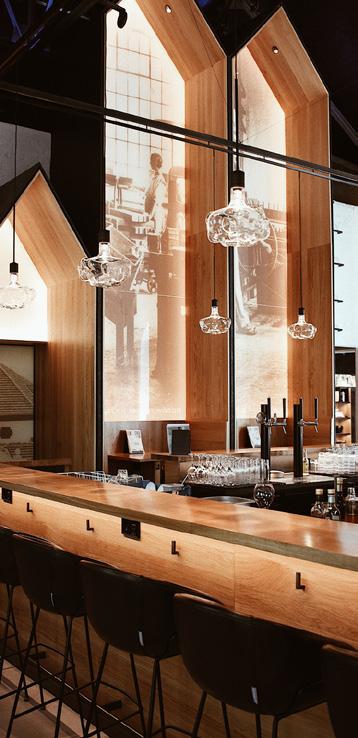



Wie eine Ikone wirkt der Turm der Durst Group kurz nach der Einfahrt in die Stadt Brixen. Das Gebäude symbolisiert mit seiner geschwungenen Form und den pixelförmigen Fenstern die Dynamik und den weltweiten Erfolg des Unternehmens, das sich mit digitaler Druck- und Produktionstechnologie beschäftigt.
Ein jeder von uns kommt täglich mit den Produkten, die auf den Durst Drucksystemen produziert werden, in Berührung – sei es großformatige Werbung, hochwertige Fliesen und Textilien, Etiketten oder clevere Verpackungen. Doch kaum einer weiß, was sich hinter der Fassade abspielt und wer die Menschen sind, die die Welt „dekorieren“ und kennzeichnen.
La torre del Gruppo Durst appare come un'icona appena si entra nella città di Bressanone. Con la sua forma curva e le finestre pixelate, l'edificio simboleggia il dinamismo e il successo globale dell'azienda, specializzata nella stampa digitale e nella tecnologia di produzione.

Ognuno di noi entra quotidianamente in contatto con i prodotti realizzati con i sistemi di stampa Durst: pubblicità di grande formato, piastrelle e tessuti di alta qualità, etichette o imballaggi innovativi. Ma quasi nessuno sa cosa succede dietro la facciata e chi sono le persone che “decorano" e caratterizzano il mondo.
The Durst Group's tower appears as an icon as soon as you enter the city of Bressanone. With its curved shape and pixelated windows, the building symbolises the dynamism and global success of the company, which specialises in digital printing and production technology.
Every one of us comes into daily contact with products made with Durst printing systems: large-format advertising, high-quality tiles and textiles, labels or intelligent packaging. But hardly anyone knows what goes on behind the facade and who the people are who “decorate” and label the world.

DE „Ich liebe großformatige Anwendungen, zwingen sie den Betrachter doch, sich durch eine Distanz und Perspektivenwechsel dem Motiv zu nähern“, sagt Klaus Pobitzer, international anerkannter Künstler aus Südtirol mit Sitz in Wien und Schlanders. „Dadurch fällt die Kunst nicht in die Falle des schnellen Konsums und kann sich entfalten.“
Klaus Pobitzer wurde von der Durst Group beauftragt, das „Geheimnis“ hinter dem Durst Group Headquarter zu lüften. Herausgekommen ist das Kunstprojekt „Inside/Out“. Im Mittelpunkt stehen die großformatigen Einzel- und Gruppenportraits des Künstlers, die die Mit-
arbeiter der Durst Group in ihrer Arbeitsumgebung zeigen sowie technische Details der Drucksysteme und ihrer Fertigungsprozesse.
„Wir transportieren das größte Kapital des Unternehmens mit ‚Inside/Out‘ nach außen:
Die Mitarbeiter und die Technologie“, sagt der Künstler. „Das Ganze präsentiert in einer Anwendung, die von den Durst Drucksystemen selbst produziert worden sind.“
Um das Kunstprojekt nachhaltig abzuschließen, wurde ein Druckmaterial gewählt, welches im Anschluss an die Ausstellung zu wasserfesten Taschen für die Mitarbeiter und die Kunden weiterverarbeitet wird.

IT “Amo le applicazioni di grande formato, perché costringono lo spettatore ad avvicinarsi al soggetto e a guardarlo da una prospettiva diversa", afferma Klaus Pobitzer, artista altoatesino di fama internazionale con sede a Vienna e a Silandro. “In questo modo si evita che l'arte cada nella trappola del consumismo rapido e le si permette di espandersi.”
Klaus Pobitzer è stato incaricato dal Gruppo Durst di svelare il “segreto" che si cela dietro la sede dell’azienda. Il risultato è il progetto artistico Inside/Out. Al centro del progetto ci sono le immagini di grande formato di ogget-
„Ich liebe großformatige Anwendungen, zwingen sie den Betrachter doch, sich durch eine Distanz und Perspektivenwechsel dem Motiv zu nähern.“
“Amo le applicazioni di grande formato, perché costringono lo spettatore ad avvicinarsi al soggetto e a cambiare prospettiva.”
"I love large-format applications, because they force the viewer to approach the motif from a distance and from a different perspective."
Klaus Pobitzer, Artist
ti nascosti dell'artista, che mostrano i dipendenti del Gruppo Durst nel loro ambiente di lavoro e i dettagli tecnici dei sistemi di stampa e dei loro processi produttivi. “Con Inside/Out trasportiamo all'esterno la più grande risorsa dell'azienda: i dipendenti e la tecnologia", spiega l'artista. “Il tutto viene presentato in un'applicazione prodotta dagli stessi sistemi di stampa Durst.”
Per portare a termine il progetto artistico in modo sostenibile, è stato scelto un materiale di stampa che, dopo la mostra, sarà ulteriormente trasformato in borse impermeabili per i dipendenti e i clienti.
EN “I love large-format applications, because they force the viewer to approach the motif from a distance and from a different perspective," says Klaus Pobitzer, an internationally renowned South Tyrolean artist based in Vienna and Silandro.
“This prevents art from falling into the trap of quick consumption and allows it to unfold." Klaus Pobitzer was commissioned by the Durst Group to unveil the “secret” behind the company’s headquarters. The result is the art project Inside/Out. At the heart of the project are the artist's large-format images of hidden objects, showing Durst

Group employees in their working environment and the technical details of their printing systems and production processes. “With Inside/Out we transport the company's greatest asset to the outside world: the employees and the technology," the artist explains. “Everything is presented in an application produced by Durst printing systems themselves."
In order to carry out the art project in a sustainable way, a printing material was chosen, which will be further processed into waterproof bags for employees and customers after the exhibition.



SOUTH TYROL’S GLOBAL PLAYER
DE Christoph Gamper, seit 2013 CEO und Miteigentümer der Durst Group, hatte die Idee für die Zusammenarbeit mit dem Künstler Klaus Pobitzer. „Wir sind zwei Vinschgauer Buben“, sagt Gamper. „Doch was uns vereint, ist nicht Sozialromantik, sondern, dass wir Südtirol für lange Zeit verlassen haben und nun zurückgekehrt sind, um Impulse für die Zukunft unserer Heimat zu geben. Mit ‚Inside/Out‘ transportieren wir für die Durst Group und unseren Standort alle wichtigen Botschaften: der Mensch im Vordergrund, Technologie als Lösungsweg, Innovation als Mission und Nachhaltigkeit als ganzheitliches Konzept.“
Die Durst Group entwickelt und produziert nachhaltige und disruptive Digitaldruck- und Produktionstechnologien. Das Unternehmen beschäftigt über 1000 Mitarbeiter an 20 Niederlassungen weltweit und ist mit seinen Drucksystemen in 80 Ländern vertreten. Das 1936 gegründete Familienunternehmen ist ein Pionier in der Reproduktion – vom Postkartendrucker über Fotoapparate, Vergrößerer bis zum heutigen Digitaldruck. Aus diesem Grund gibt es auch eine enge Zusammenarbeit des Unternehmens mit dem Lumen; das Museum für Bergfotografie am Kronplatz vereint wie die Durst Group die Symbiose zwischen Mensch, Berg, Technologie und Resilienz.
IT Christoph Gamper, CEO dal 2013 e comproprietario del Gruppo Durst, ha avuto l'idea della collaborazione con l'artista Klaus Pobitzer. “Siamo due ragazzi della Val Venosta", dice Gamper. “Ma ciò che ci unisce non è il romanticismo sociale, bensì il fatto che abbiamo lasciato l'Alto Adige per molto tempo e ora siamo tornati per dare impulso al futuro della nostra terra. Con Inside/Out trasmettiamo tutti i messaggi importanti per il Gruppo Durst e per la nostra sede: le persone in primo piano, la tecnologia come soluzione, l'innovazione come missione e la sostenibilità come concetto olistico.”



„Der Mensch im Vordergrund, Technologie als Lösungsweg, Innovation als Mission und Nachhaltigkeit als ganzheitliches Konzept.“
“Le persone in primo piano, la tecnologia come soluzione, l'innovazione come missione e la sostenibilità come concetto olistico.”
"People as the focus, technology as the solution, innovation as the mission and sustainability as a holistic concept."


Il Gruppo Durst sviluppa e produce tecnologie di stampa digitale per produzioni sostenibili e dirompenti. L'azienda impiega oltre mille persone in venti sedi in tutto il mondo ed è presente con i suoi sistemi di stampa in ottanta Paesi. Fondata nel 1936, l'azienda a conduzione familiare è un pioniere della riproduzione, dalle stampanti per cartoline alle macchine fotografiche, agli ingranditori e alla stampa digitale di oggi. Per questo motivo, l'azienda collabora strettamente con il Lumen. Come il Gruppo Durst, anche il Museo della fotografia di montagna di Plan de Corones unisce in simbiosi persone, montagne, tecnologia e resilienza.
EN Christoph Gamper, CEO and co-owner of the Durst Group since 2013, came up with the idea for the collaboration with artist Klaus Pobitzer. “We are two guys from the Venosta Valley," says Gamper. “But what unites us is not social romance, but rather the fact that we left South Tyrol for a long time and have now returned to give impetus to the future of our land. With Inside/Out we convey all the messages that are important for the Durst Group and our locality: People as the focus, technology as the solution, innovation as the mission and sustainability as a holistic concept."
The Durst Group develops and produces sustainable and disruptive digital printing and production technologies. The company employs more than 1,000 people in 20 locations worldwide and has a presence with its printing systems in 80 countries. Founded in 1936, the family-owned company is a pioneer in reproduction, from postcard printers to the cameras, enlargers and digital printing of today. For this reason, the company cooperates closely with Lumen. Like the Durst Group, the Museum of Mountain Photography at Plan de Corones combines the symbiosis of people, mountains, technology and resilience.

Bei Kork denken die meisten an Pinnwände oder Flaschenkorken, eher nicht an maßgefertigte Teppiche, edle Tischsets, lustig bedruckte Wickelauflagen oder personalisierte Yogamatten. Die Idee, aus dem nachhaltigen Naturmaterial schöne Dinge für daheim zu fertigen, kam Clarissa Steurer durch einen Fernsehbeitrag über veganes Leder. Fünf Jahre ist es her, dass die gelernte Textilerin den Schritt in die Selbstständigkeit gesetzt und ihr Label Clarissakork gegründet hat. Aus der One-Woman-Show ist mittlerweile ein Unternehmen mit rund 20 Mitarbeitern geworden – ganz ohne Business Angel, mit wenig Anfangskapital und null Followern auf Social Media. Heute werden in der neu gebauten Manufaktur mitten im schönen Bregenzerwald im Westen von Österreich über 140 verschiedene Produkte aus robustem Korkleder hergestellt: mal bestickt oder bedruckt, für Erwachsene und Kinder – jedenfalls immer mit viel Herzblut und von Hand gefertigt.
Pensando agli usi del sughero, vengono in mente per lo più i tappi delle bottiglie di vino oppure le bacheche, non certo tappeti su misura, eleganti tovagliette, simpatici fasciatoi o materassini yoga personalizzati. A Clarissa Steurer, l’idea di realizzare altri oggetti per interni in questo materiale naturalmente sostenibile venne guardando un documentario sulla pelle vegana. Da ormai cinque anni, la giovane austriaca, con alle spalle una formazione nel settore tessile, ha fondato il suo personalissimo marchio Clarissakork. Partita come unica dipendente di sé stessa, ora conta circa venti collaboratori – una crescita riuscita
Kork ist pflegeleicht, schadstofffrei und für Allergiker geeignet.
Il sughero è di facile manutenzione, privo di sostanze nocive e anallergico.
Cork is easy to clean, pollutant-free and suitable for people with allergies.


senza alcun business angel, con un modesto capitale iniziale e zero follower. Nella nuova sede della manifattura, immersa nella splendida foresta di Bregenz nella regione più occidentale dell’Austria, vengono confezionati oltre 140 prodotti diversi in robusta pelle di sughero: ricamati o stampati, per adulti e per bambini… In ogni caso, con tanta passione e rigorosamente a mano.
Most people think of pinboards or bottle corks when they think of cork. They tend not to think of custom-made rugs, elegant placemats, amusingly printed changing mats or personalised yoga mats. It was a television programme about vegan leather that gave Clarissa Steurer the idea of making
beautiful things for the home out of this sustainable and natural material. The trained textile worker took the step to start her own business five years ago and founded her label Clarissakork. The one-woman show has now become a company with around 20 employees. She did so without a business angel, with little initial capital and zero followers on social media. Today, the newly built factory in the middle of the beautiful Bregenzerwald in the west of Austria produces over 140 different products made from robust cork leather. They can be embroidered or printed, for both adults and children. They are always handmade with a lot of passion.
www.clarissakork.com

20 Jahre Liebe für das Schöne. /years love for detail.



Wussten Sie, dass man Risotto auch als Dessert servieren kann? Das Reisgericht passt zu jeder Gelegenheit, ob mit Gemüse, Fisch, Fleisch oder süßer Note. In ihrem neuen Buch „Passion Risotto“ präsentiert das „So kocht Südtirol“-Team wertvolle Tipps zur Zubereitung und Reisauswahl. Anhand von leicht verständlichen Schritt-für-Schritt-Anleitungen gelingt jede Variante auf Anhieb. Für ein besonders cremiges Erlebnis!
Come può un chicco così piccolo sprigionare tanta bontà? Servito con i più svariati condimenti a base di verdure, pesce, carne e

Cremig, cremiger, Risotto. 208 Seiten, Athesia-TappeinerVerlag.
Disponibile solo in lingua tedesca.
Available only in German.
anche come dolce, il risotto è perfetto in ogni contesto. Nel nuovo libro di ricette, gli chef di Cucinare nelle Dolomiti offrono dei consigli su come preparare questa prelibatezza e quale tipologia di riso scegliere, come anche qualche loro rivisitazione altoatesina di alcuni piatti classici italiani.
Did you know that you can also serve risotto as a delicious dessert? This special grain pairs perfectly with vegetables, fish, meat but is equally appetising as a sweet course. In their new book “Passion Risotto”, the “So kocht Südtirol” team offers you countless
 Heinrich Gasteiger, Gerhard Wieser & Helmut Bachmann
Heinrich Gasteiger, Gerhard Wieser & Helmut Bachmann
precious tips to prepare scrumptious meals –and even guides you in selecting the right variety of rice for each dish. The recipes are easy to recreate thanks to the straightforward step-by-step guides. Deliciously creamy results are guaranteed!


Zutaten
1 kg Datteltomaten oder reife Fleischtomaten
• 125 ml Olivenöl
• 80 g Zwiebeln
1 Knoblauchzehe
1 EL Balsamicoessig
8 Basilikumblätter
• 125 ml Fleischsuppe
• 2 Tropfen Tabasco
Salz
Cayennepfeffer
Zum Garnieren
• Basilikum
1 EL Olivenöl
Zubereitung
Zuerst die Datteltomaten waschen, den Stielansatz herausschneiden, die Tomaten vierteln und die Kerne entfernen. In einem Kochtopf ein wenig Olivenöl erwärmen und die klein geschnittenen Zwiebeln und den Knoblauch darin dünsten. Die Tomaten dazugeben, salzen, etwa 20 Minuten mitdünsten und zusammen mit dem Balsamicoessig und den Basilikumblättern im Mixer pürieren. Beim Mixen langsam das restliche Olivenöl und die kalte Fleischsuppe einlaufen lassen. Die Tomatensuppe durch ein feines Sieb streichen und kalt rühren (evtl. auf Eiswürfelwasser). Zum Schluss die Suppe mit Tabasco, Salz und Cayennepfeffer leicht pikant abschmecken. Mit Basilikum und Olivenöl garnieren und servieren.
Ingredienti
1 kg di datterini o pomodori
costoluti maturi
• 125 ml di olio d’oliva
• 80 g di cipolla
1 spicchio d’aglio
1 cucchiaio di aceto balsamico
8 foglie di basilico
• 125 ml di brodo di carne
• 2 gocce di Tabasco
Sale
Pepe di Caienna
Per guarnire
• Un po’ di basilico
1 cucchiaio di olio d’oliva
Preparazione
Lavare i pomodorini, asportare l’attacco del picciolo, tagliarli a spicchi e ripulirli dell’interno. Riscaldare un po’ d’olio in una pentola e stufarvi la cipolla e l’aglio tagliati finemente. Dopodiché, unire i pomodori, salare, proseguire per venti minuti la cottura, infine ridurli in purea con l’aceto balsamico e le foglie di basilico versando a filo l’olio rimanente e il brodo di carne freddo. A questo punto, filtrare la crema attraverso un passino a maglie sottili e mescolarla a freddo (eventualmente in acqua e ghiaccio). Alla fine, aggiustare di sale e dare un tono un po’ piccante al piatto con il Tabasco e il pepe di Caienna; guarnire con il basilico e l’olio d’oliva, poi servire.
Ingredients
1 kg datterini tomatoes or beef tomatoes
• 125 ml olive oil
• 80 g onions
1 clove garlic
1 tbsp balsamic vinegar
8 basil leafs
• 125 ml beef stock
• 2 drops of tabasco
salt
cayenne pepper
For garnish
• basil
1 tbsp olive oil
Preparation
Start by carefully washing the date tomatoes, then cut out the stems, quarter them and remove the seeds. Heat a little olive oil in a saucepan and sauté the finely chopped onions and garlic in it. Add the tomatoes, season with salt and then simmer for about 20 minutes before pureeing them in a blender with the balsamic vinegar and basil leaves. Slowly pour in the remaining olive oil and the cold meat stock while you are blending. Pass the tomato soup through a fine sieve and stir until cold (on ice water if necessary). To finish, season the soup with Tabasco, salt and cayenne pepper to taste. Finaly garnish the plated soup with basil and olive oil before serving.


Für 4 Personen
Einfach zubereitet in 30 Minuten
Zutaten
• 80 g Zwiebeln
• 2 EL Öl
280 g Rundkornreis (Arborio, Carnaroli oder Vialone Nano)
• 50 ml Weißwein
• 1 l heiße Geflügelbrühe oder heißes Wasser
• 60 g Speckstreifen, geröstet 30 g kalte Butter
30 g Parmesan, gerieben
• 80 g Mascarpone
• Salz
• Pfeffer aus der Mühle
Zum Garnieren
4 Eigelb
• Speckstreifen, geröstet
• Schnittlauch schwarzer Pfeffer aus der Mühle
Zubereitung
Als Erstes die Zwiebeln schälen, fein schneiden und in Öl leicht dünsten. Den Reis beigeben und bei milder Hitze unter ständigem Rühren glasig werden lassen. Mit Weißwein ablöschen und die Flüssigkeit vollständig einkochen lassen, bis der Alkohol verdampft ist. Die Geflügelbrühe nach und nach so aufgießen, dass der Reis immer mit Flüssigkeit bedeckt ist. Unter oftmaligem Rühren etwa 18 Minuten kochen lassen. Der Risotto soll bissfest, seine Konsistenz aber cremig sein. Mit Salz und Pfeffer abschmecken, die gerösteten Speckstreifen, die kalte Butter, den Parmesan und Mascarpone untermischen. Den Risotto mit rohem Eigelb, gerösteten Speckstreifen, schwarzem Pfeffer und Schnittlauch servieren.
Tipps
Sie können das Eigelb auch zusammen mit dem Mascarpone unter den Risotto mischen. Im klassischen italienischen Rezept steht Guanciale anstelle des Specks, Sie können aber auch Rohschinken verwenden.
Weinempfehlung der Kellerei Meran
Südt. Riesling DOC „Graf“ – Jahrgang 2022
Die Herstellung dieses anspruchsvollen, trocken-ausgebauten Rieslings erfolgt äußerst schonend. Ein majestätischer Wein.
Per 4 persone
Facile da preparare in 30 minuti
Ingredienti
• 80 g di cipolla
• 2 cucchiai di olio
280 g di riso Arborio, Carnaroli o Vialone Nano
• 50 ml di vino bianco
• 1 l di brodo di pollo o acqua calda
• 60 g di speck a striscioline croccanti
30 g di burro
30 g di Parmigiano grattugiato
• 80 g di mascarpone
• Sale
• Pepe macinato fresco
Per guarnire
4 tuorli
• Speck a striscioline croccanti
• Erba cipollina
Pepe nero macinato fresco
Preparazione
Sbucciare e sminuzzare la cipolla, quindi soffriggerla nell’olio. Versare il riso e tostarlo a fuoco lento, mescolando continuamente. Quando sarà diventato traslucido, sfumare con il vino bianco e lasciare evaporare la parte alcolica. A questo punto, iniziare a bagnare il riso con il brodo caldo, avendo cura che sia sempre coperto di liquido. Cuocere per circa diciotto minuti fino a che la sua consistenza risulti compatta e, allo stesso tempo, cremosa. Regolare di sale e pepe, aggiungere lo speck e mantecare con il Parmigiano, il mascarpone e il burro freddo di frigo. Impiattare e guarnire con il tuorlo crudo, altro speck croccante, erba cipollina e una macinata di pepe.
Suggerimento
È possibile mescolare il tuorlo direttamente nel risotto, insieme al mascarpone. La ricetta della tradizione italiana prevede l’uso del guanciale al posto dello speck, ma si può variare anche col prosciutto crudo.
Vino consigliato dalla
Cantina Merano
Alto Adige Riesling DOC “Graf” – annata 2022
La produzione di questo vino secco ed esclusivo avviene in maniera molto delicata. Un vino veramente imponente.
Serves 4 people
30 minutes easy
Ingredients
• 80 g onions
• 2 tbsp oil
280 g round-grain rice (Arborio, Carnaroli or Vialone Nano)
• 50 ml white wine
• 1 l hot chicken stock or hot water
• 60 g slices of bacon, fried
30 g cold butter
30 g parmesan, grated
• 80 g mascarpone
• salt
• pepper from the peppermill
For garnish
4 yolks
• slices of bacon, fried, for garnish
• chives for garnish black pepper from the peppermill
Preparation
Peel onions, finely chop them and then lightly sauté them in oil. Add the rice and let it turn glossy while continuously stirring. Deglaze with white wine and let the liquid evaporate completely. Once evaporated, continue adding chicken stock and make sure the rice is always covered by the liquid. Let it cook – stirring ever so often – for about 18 minutes. The risotto should still have bite, while its consistency should be creamy. Season it with salt and pepper to taste, then gently stir in the slices of bacon, cold butter, parmesan and mascarpone. Plate and serve the risotto with a raw egg yolk and garnish it with bacon slices, black pepper and chives.
Tips
You can also mix the egg yolk(s) with the mascarpone and stir it into the risotto. In the original italian recipe Guanciale is used instead of bacon. However, for this recipe you may also substitute it with dry-cured ham.
Wine recommendation from the Cantina Merano Winery
Alto Adige Riesling DOC “Graf” – vintage 2022
This sophisticated unique and dry Riesling is produced whit the utmost care. A truly majestic wine.
No & low alcohol drinks
Jede Menge Spaß mit dem prickelnden S’Pom Rosé Apfelcidre, dem neuen Aperitif-Hit Sparkling Rocco und den erfrischenden Bieren Freedl – und zwar alles mit wenig oder gar keinem Alkohol!
Il massimo del divertimento è garantito dal sidro di mele S’Pom Rosé, dalla nuova specialità per l’aperitivo Sparkling Rocco e dalle rinfrescanti birre Freedl – tutto con poco o senza alcol!
Enjoy yourself with the sparkling S’Pom Rosé apple cider, the new aperitif hit Sparkling Rocco and the refreshing Freedl beers –all of which have little or no alcohol content!
www.pursuedtirol.com
U.RO Bio Vodka Edelschwarz. Destilliert mit biologischem und zu 100 % in Südtirol angebautem Urroggen sowie biologischem Weizen aus den Alpen überrascht der Vodka mit seinem reinen, weichen und erfrischenden Aroma. Ein Vodka mit einzigartigem Charakter. Neu im Edelschwarz-Sortiment.
U.RO, la vodka bio di Edelschwarz. La new entry tra i prodotti Edelschwarz viene distillata da una varietà antica di segale, coltivata completamente in Alto Adige in modo biologico, e da grano bio delle Alpi. Questa vodka dal carattere unico convince per il suo aroma puro, morbido e rinfrescante.

U.RO Edelschwarz organic vodka. Distilled with organic primaeval rye that has been cultivated exclusively in South Tyrol, as well as with organic wheat from the Alps. This vodka surprises with its pure, soft and refreshing flavour. The new vodka in the Edelschwarz range has a very unique character. www.edelschwarz.it

Meraner Bio Kräuterwurzn. Genießen Sie das Ergebnis traditioneller Handwerkskunst von Galloni. Meraner Metzgerqualität seit 1966. 100 % frei von Konservierungsstoffen, Nitrit, Gluten und Laktose. In verschiedenen Geschmacksrichtungen in ausgewählten MPreis-Filialen und Pur Südtirol Märkten erhältlich. Salamini meranesi bio. Dal 1966, Galloni è sinonimo di carne e salumi di qualità artigianale, come i tipici salamini affumicati in diverse varianti. I prodotti bio dell’azienda meranese – senza conservanti, nitriti, glutine e lattosio – sono disponibile in filiali MPreis selezionate e presso Pur Südtirol.
Merano organic “Kräuterwurzn ”. Enjoy the products of Galloni's traditional craftsmanship. Quality Merano butchery since 1966. All 100% free of preservatives, nitrite, gluten and lactose. Available in various different flavours in selected MPreis branches and in the Pur Südtirol markets.
www.galloni-meran.it



Made to celebrate!
Der Sekt Brut Riserva 36 nach der klassischen Champagner-Methode ist ein echter Gaumenschmeichler.
Lo spumante metodo classico Brut Riserva 36 è una vera delizia per il palato.
The Brut Riserva 36 sparkling wine made according to the classic method is a real palate pleaser. www.kellereimeran.it www.cantinamerano.it

Dolomit. Hergestellt aus bester Südtiroler Milch und gehüllt in eine rustikale Rinde, reift der Hartkäse Dolomit in Ruhe zur Perfektion. Auf der Zunge schmilzt er cremig weich und lässt einzelne Salzkristalle spürbar werden. Sehr aromatisch, mit malzigen Röstnoten und einer leicht pikanten Würze hinterlässt der Dolomit einen bleibenden Eindruck.
Dolomit. Prodotto con il miglior latte vaccino dell’Alto Adige e avvolto in una crosta rustica, il formaggio a pasta dura Dolomit matura lunghi mesi fino alla perfezione. Ha una consistenza fondente che, sciogliendosi in bocca, lascia percepire i singoli cristalli dovuti alla stagionatura. Presenta un sapore aromatico con note tostate e leggermente piccanti.

Dolomit. Made from the best South Tyrolean milk and wrapped in a rustic rind, the hard cheese Dolomit matures to perfection. On the tongue the Dolomit melts creamily soft, tickling it with individual salt crystals. Its long aging process provides it with an aromatic spice and toasty notes. www.mila.it
Saftiger Barbecue-Traum.
Qualitativ hochwertiges Schweinefleisch trifft auf den rauchigen Geschmack der Barbecuesauce. Aus nur wenigen Zutaten zubereitet und ohne Konservierungsmittel ist die Recla BBQ-Haxe natürlich lecker und reich an Proteinen. Ein köstliches Gericht, das einfach und schnell zubereitet werden kann.
Per gli amanti del BBQ
La carne di suino di alta qualità incontra il gusto affumicato della salsa barbecue: preparato con pochi ingredienti e senza conservanti aggiunti, lo Stinco BBQ Recla è naturalmente buono e ricco di proteine. Per un piatto succulento pronto da portare in tavola in poche mosse.
For BBQ lovers
The high quality of the Recla pork meets the smoky taste of barbecue sauce to create a delicious, simple, and quick dish. With no added preservatives, the Recla BBQ pork knuckle is delicious by nature, rich in protein and prepared in just a few quick and simple steps.
www.recla.it
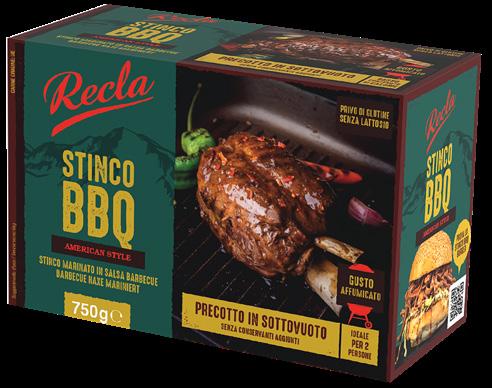

Entdecke den natürlichen Genuss mit Agnes & Luis! Unsere Produkte, aus erlesenen, lokalen Zutaten hergestellt, spiegeln die Liebe zum Detail und die Hingabe zur Qualität wider. Von unserem Garten direkt auf deinen Tisch.
Scopri il gusto naturale con Agnes & Luis! I nostri prodotti, a base di ingredienti locali selezionati, riflettono la passione per i dettagli e la dedizione alla qualità. Dal nostro orto direttamente sulla tua tavola.
Discover the natural delight with Agnes & Luis! Our products, made from selected local ingredients, reflect our passion for detail and our dedication to quality. From our garden straight to your table.
www.agnesluis.it

Das Sparkling Festival im Mai 2023 war zweifellos mondäner Höhepunkt des Jahres. Ein rundum gelungener, frühsommerlicher EventAbend in Marling, bei dem die Kellerei Meran, gemeinsam mit der Südtiroler Sektvereinigung und dem Prickelnden Dorf Marling eine erlesene Auswahl Südtiroler Schaumweine präsentierte.
Zusätzlich zum großen Sparkling Festival, das im Mai 2025 stattfinden wird, ist am Samstag, 27. April 2024 in der City.Vinothek in Meran eine Special Edition geplant. Ein Termin, den sich Sektliebhaber nicht entgehen lassen sollten.
Kartenreservierung: www.sparklingfestival.it
Il festival dedicato agli spumanti, tenutosi a maggio 2023, è stato senza dubbio l’evento più suggestivo dell’anno passato. Una riuscita serata d’inizio estate, dove Cantina Merano, l'Associazione produttori spumante Alto Adige e il “Paese delle bollicine – Marlengo" hanno presentato una raffinata selezione di bollicine.
In vista dell'evento biennale Sparkling Festival, che si terrà a maggio 2025, è previsto un evento speciale per sabato 27 aprile 2024 presso la City.Vinothek a Merano. Un appuntamento da non perdere per tutti gli appassionati del metodo classico.
Prenotazione biglietti: www.sparklingfestival.it
The Sparkling Festival held back in May 2023 was undoubtedly the year’s most glamorous highlight. It was a thoroughly successful early summer evening event in Marlengo, at which the Cantina Merano Winery, together with the South Tyrolean Sparkling Wine Association and Marlengo - “Il paese delle bollicine", showcased an exquisite selection of South Tyrolean sparkling wines.
In addition to the big Sparkling Festival, which will take place in May 2025, a special edition is planned for Saturday, 27th of April 2024 at the City.Vinothek in Merano. Sparkling wine lovers should not miss this event.
Ticket reservation: www.sparklingfestival.it

Der Likörwein Amadeo darf sich zu Recht als neuestes Meisterstück des Kellermeisters Stefan Kapfinger in der Raritäten-Linie der Kellerei Meran präsentieren. Dieser besondere Meditationswein besticht mit formvollendetem reichem, rundem und würzigem Geschmack sowie einer feinen, harmonischen Süße.
IT
Il vino liquoroso Amadeo può definirsi a tutti gli effetti l’ultimo capolavoro dell’enologo

Für alle Sinne – zwei trendige Treffpunkte, zwei exklusive Locations
Viel Platz zum Wohlfühlen, Erleben und Genießen bieten nicht nur die Panorama-Önothek in Marling und die erst kürzlich renovierte City.Vinothek in Meran, sondern auch die dazugehörenden außergewöhnlichen Räumlichkeiten, die für Seminare, Events und Veranstaltungen angemietet werden können. Zwei besondere Locations mit einzigartiger Kulisse für unvergessliche Momente.
Una festa per i sensi – due luoghi d’incontro trendy ed esclusivi
IT L’Enoteca panoramica a Marlengo e la City.Vinothek a Merano, recentemente rinnovata, offrono ampi spazi dove provare nuove esperienze gustative in uno scenario unico. Le straordinarie e suggestive sale annesse possono inoltre essere noleggiate per seminari, eventi e ricevimenti. Due location esclusive per momenti indimenticabili.
Stefan Kapfinger della Cantina Merano. Questo speciale vino da meditazione delizia l'olfatto con il suo bouquet ricco, rotondo e speziato, e conquista il palato anche grazie alla sua delicata e armoniosa dolcezza.
The Amadeo liqueur wine can rightly claim to be the latest masterpiece of cellar master Stefan Kapfinger in the Cantina Merano Winery's range of rarities. This special meditation wine is characterised by a perfectly rich, round and spicy flavour and a fine, harmonious sweetness.
Amadeo ist die erfolgreiche Interpretation der Kellerei Meran des bekannten Portweins aus Portugal.
Amadeo è la riuscita interpretazione della Cantina Merano del celebre Porto portoghese.
Amadeo is the Cantina Merano Winery’s triumphant interpretation of the famous Portuguese port wine.

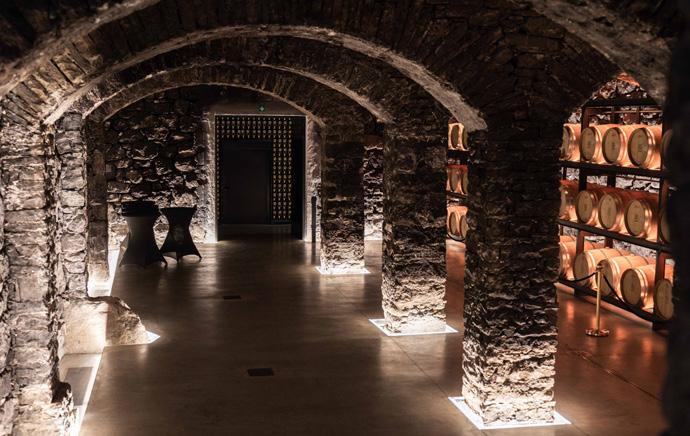

For all senses – two trendy meeting venues, two exclusive locations
EN The Panoramic Enoteca in Marlengo and the recently renovated City.Vinothek in Merano both offer plenty of space to feel good, experience and indulge. They also offer extraordinary rooms that can be hired for seminars, events and functions. Two special locations with a breathtaking backdrop to create unforgettable moments.

Wine Shop . Wine Tasting
Wine Shop . Wine Bar . Wine Tasting
Info +39 0473 447137
www.kellereimeran.it
www.cantinamerano.it
SENZA O CON POCO ALCOL, MA CON TANTO SAPORE NO AND LOW ALCOHOL: INDULGENCE WITHOUT SACRIFICE

Günther Hölzl genießt ein Glas seines Apfelsekts S’Pom Rosé.
Günther Hölzl presenta il suo sidro di mele S’Pom Rosé.
Günther Hölzl enjoying a glass of his sparkling apple wine S’Pom Rosé.
Mocktail, dry January, sober October – immer mehr Wörter und Trends entwickeln sich rund um das Thema „No and low alcohol“, also Getränke mit keinem oder geringem Alkoholgehalt. Dass sich dieses Thema in den letzten Jahren dermaßen stark entwickelt hat, dafür gibt es viele Gründe, wie Günther Hölzl vom Meraner Weinhaus weiß:
„Immer mehr Menschen möchten gesundheitsbewusst leben und verzichten deshalb zur Gänze oder zeitweise auf alkoholische Getränke. Daneben gibt es natürlich auch einige, die auf Grund von Medikamenten oder Schwangerschaften keinen Alkohol zu sich nehmen dürfen. Auch das Besprechen wichtiger Angelegenheiten bei Geschäftsessen führt dazu, dass viele eher auf Alkohol verzichten, und im Straßenverkehr gelten europaweit strenge Richtlinien bei der Promillegrenze.“ Kein Wunder also, dass immer mehr innovative Technologien und Produkte auf den Markt kommen, die sich diesem Konzept verschrieben und ihren Einzug auch in die Sternegastronomie gefunden haben. „Alkoholfreie Varianten von Bier, Wein und Aperitifs werden von Gastronomen gerne aufgenommen, weil sie im Gegensatz zu Säften und Wasser verdauungsfördernd sind und dank ihrer Aromen als ideale Essensbegleiter fungieren“, erklärt Günther Hölzl.
Eine Besonderheit im Weinland Südtirol ist beispielweise der S’Pom Rosé, wobei das „S“ für Sparkling und Südtirol, das „Pom“ für Äpfel und das „Rosé“ für Roséwein steht. Es handelt sich um einen hellleuchtenden rosa Apfelsekt mit 4 % Alkohol und eine Neuheit des Jahres 2024. Innovativ ist auch Freedl,
ein alkoholfreies Bier. „Die große Neuheit bei diesem Produkt ist, dass dem Bier nicht wie normalerweise der Alkohol entzogen wird, sondern dass es durch die Verwendung spezieller Hefen von Natur aus alkoholfrei ist“, sagt Maria-Elisabeth Laimer vom Gasthaus Pfefferlechner, zu dem eine eigene Hausbrauerei gehört. „Als mein Bruder Maximilian und ich vor fünf Jahren den ersten Personen gesagt haben, was wir vorhaben, wurden wir oft belächelt. Als die ersten dann aber das Bier probiert haben, waren sie positiv überrascht. Das ist bis heute die Reaktion: Erstaunen, dass alkoholfrei nicht Verzicht auf Genuss und Geschmack bedeuten muss.“
Auch die Reaktionen auf den alkoholfreien Aperitif Sparkling Rocco waren sehr positiv, wie Josef Holzner, Entwickler des Getränks, erzählt: „Die Säure im Apfel verhält sich in der Nase wie saure Beeren und wilde Waldfrüchte. Im Trunk schmeckt man Rhabarber und sauren Apfel. Die Kohlensäure verleiht dem Produkt noch mehr Frische. Das Auge trinkt natürlich mit, deshalb ist auch die Optik neben dem Geschmack sehr wichtig.“
Bei Taufen, Hochzeiten, Geschäftsessen, Geburtstagen oder einfach nur zum Feierabend: Getränke mit weniger oder keinem Alkohol können zu jeder Tageszeit konsumiert werden. Der Markt hat großes Potential, wie Josef Holzner hervorhebt: „Studien prognostizieren den Anstieg an alkoholfreien und alkoholreduzierten Getränken um über 30 % in den nächsten Jahren.“ Auch Maria-Elisabeth Laimer ist davon überzeugt, dass diese Produkte ein Teil der Genusskultur von
morgen sind: „Flex-Drinking, also die bewusste Entscheidung, wann man alkoholisch und wann nicht alkoholisch genießt, wird die neue Norm.“ Welche neuartigen Getränke in den nächsten Jahren in Südtirol wohl auf den Markt kommen werden? Es bleibt spannend!
Mocktail, Dry January, Sober October… Nascono di continuo espressioni e trend, il cui concetto alla base è quello di consumare drink a basso contenuto o completamente senza alcol. Negli ultimi anni, infatti, questo è un tema particolarmente diffuso per diversi motivi: “Sempre più persone scelgono di seguire uno stile di vita salutare e quindi escludono, definitivamente o per uno specifico lasso di tempo, l’alcol dalla propria dieta. Ci sono poi donne in gravidanza e soggetti in cura farmacologica che, per ovvie ragioni, non possono assumere alcolici. C’è, invece, chi evita di bere durante i pasti di lavoro in cui si discute di questioni importanti. Inoltre, in tutta Europa, il codice della strada è rigido rispetto al livello massimo di alcolemia consentito alla guida”, spiega Günther Hölzl dell’enoteca Meraner Weinhaus. Non c’è da stupirsi, dunque, se sul mercato si trovano proposte alternative e prodotti innovativi, presenti poi anche nei ristoranti stellati. “Le varianti analcoliche di birra, vino e dei vari aperitivi sono molto apprezzate dai ristoratori, perché, a differenza dei soft drink e dell’acqua, favoriscono la digestione e accompagnano bene le varie portate”, dice Hölzl.
Ad esempio, una specialità nata in Alto Adige è S’Pom Rosé, dove la “S” sta per spumante e Sudtirolo e “Pom” deriva dal francese pomme,
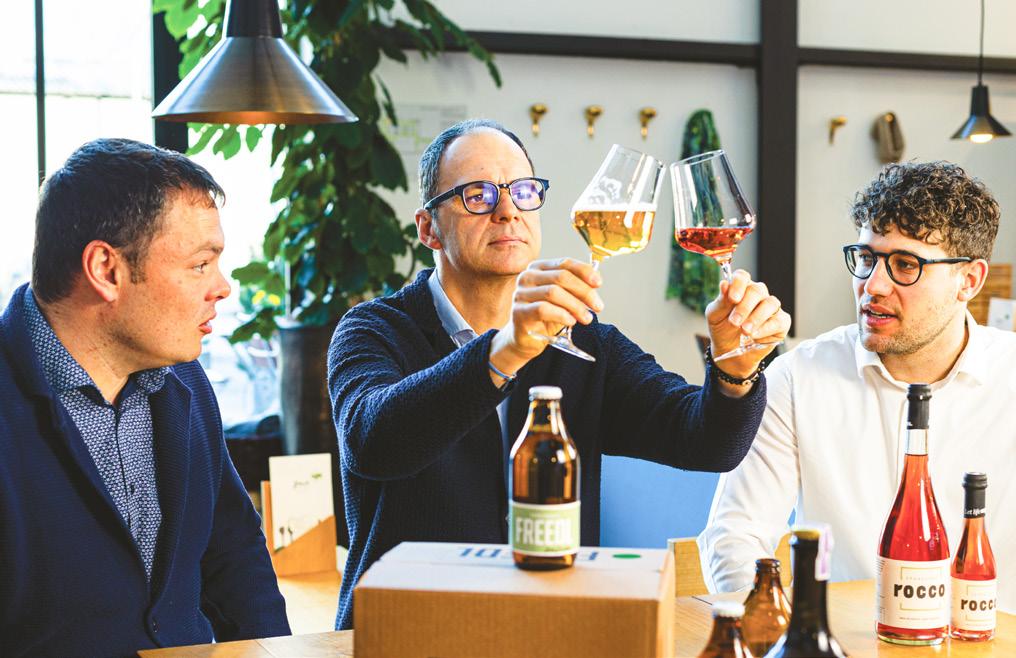
Maximilian Laimer, Günther Hölzl und Josef Holzner tauschen sich über ihre Pioniergetränke aus.
Maximilian Laimer, Günther Hölzl e Josef Holzner si confrontano sulle loro creazioni.
Maximilian Laimer, Günther Hölzl and Josef Holzner discuss their trailblazing drinks.
Hier wird seit 2019 das alkoholfreie Bier Freedl produziert.
Qui è dove dal 2019 viene prodotta la birra analcolica Freedl.
The alcohol-free beer 'Freedl' has been produced here since 2019.

ovvero mela. Si tratta di un sidro rosato con una gradazione alcolica del 4%, che, assieme alla birra analcolica Freedl, rappresenta una novità del 2024. “La peculiarità di Freedl è che l’alcol non viene rimosso come si fa normalmente per altre birre simili, bensì si utilizzano lieviti specifici così che non sia contenuto per natura”, specifica Maria-Elisabeth Laimer dell’osteria Pfefferlechner, con birrificio proprio. “Cinque anni fa, quando io e mio fratello Maximilian raccontavamo di questo progetto, ricevevamo dei sorrisini poco convinti. Quando poi abbiamo proposto per la prima volta la nostra birra analcolica, ha regnato lo stupore. Ancora oggi è così, perché continua a sorprendere che rinunciare all’alcol non significa fare a meno di un buon sapore o del piacere.”
Anche l’aperitivo analcolico Sparkling Rocco ha ricevuto riscontri positivi e a dirlo è il suo ideatore Josef Holzner: “L’acidità della mela arriva al naso come fanno i sentori aspri delle bacche e dei frutti di bosco; essa si percepisce anche al palato, assieme al rabarbaro. Inoltre, la presenza di anidride carbonica conferisce al prodotto – particolarmente invitante alla vista – ancora più freschezza”.
A battesimi, matrimoni, business event, compleanni o semplicemente a fine giornata: le bevande senza o con poco alcol possono essere consumate in ogni occasione. Secondo Josef Holzner, hanno anche un grande potenziale: “Alcuni studi prevedono un aumento di oltre il 30% nei prossimi anni”. Laimer concorda ed è convinta che il flex drinking, ovvero decidere con consapevolezza quando bere alcolici oppure no, diventerà la regola in futuro. E allora, lasciatevi sorprendere dalle golose bontà che si possono gustare in Alto Adige e dalle novità che arriveranno: non avete che l’imbarazzo della scelta.
Mocktail, dry January, sober October –more and more phrases and fads are developing around the topic of “no and low alcohol” drinks. There are plenty of reasons why this trend has gained such momentum in recent years. Günther Hölzl from Meraner Weinhaus is well aware of this: “An increasing number of people want to live a health-conscious life and are therefore abstaining from alcoholic drinks – either altogether or for periods of time. There are of course also those who are not allowed to drink alcohol because of medication or during pregnancy. Many people also tend to abstain from alcohol when discussing important matters at business lunches and dinners. There are also strict guidelines on the blood alcohol level that apply to road traffic throughout Europe.” It is therefore no wonder that more and more innovative products and technologies are being launched on the market which are dedicated to this concept. They have also found their way into Michelin-starred restaurants.
“Non-alcoholic versions of beer, wine and aperitifs are popular with restaurateurs because, in contrast to juices and water, they help digestion and their flavours make them ideal accompaniments to food,” Günther Hölzl explains.
S'Pom Rosé, for example, is a speciality in the South Tyrolean wine region. The “S” stands for sparkling and South Tyrol, the “Pom” for apples and the “Rosé” for rosé wine. It is a bright pink and sparkling apple wine containing 4% alcohol and an innovative novelty for 2024. Another new product is the non-alcoholic beer called Freedl. “The great new thing about this product is that the alcohol is not removed from the beer, as is normally the case. Instead, it is natural-
ly alcohol-free through the use of special yeasts,” says Maria-Elisabeth Laimer of the Pfefferlechner inn, which has its own inhouse brewery. “When my brother Maximilian and first told people what we were planning to do five years ago, we were often laughed at. However, when the first few of them tried the beer, they were positively surprised. That has remained the reaction to this day: amazement that alcohol-free beer doesn’t have to compromise on taste and pleasure.”
Feedback on the non-alcoholic aperitif Sparkling Rocco has also been overwhelmingly positive, according to Josef Holzner, developer of the drink: “The acidity of the apple is reminiscent of sour berries and wild forest fruits in the nose. You can taste rhubarb and sour apples in the drink. Carbon dioxide adds even more freshness to the product. The eye naturally shares in the pleasure, which is why the appearance is also very important in addition to the flavour.”
Whether at christenings, weddings, business lunches, birthdays – or simply after a long day’s work: non-alcoholic or low-alcohol drinks can be enjoyed at any time of day. Josef Holzner points out that the market has great potential: “Studies predict a 30% growth in non-alcoholic and low-alcohol drinks in the coming years.” Maria-Elisabeth Laimer also believes that these types of products will be part of tomorrow’s enjoyment culture: “Flex-drinking, i.e. making a conscious decision about when to enjoy alcoholic and non-alcoholic beverages, will be the new norm.” Let’s see which new types of drinks will hit the South Tyrolean market in the coming years. The suspense never ends!
3000
500

Qualitätsprodukte von prodotti genuini da quality products from
Bauern & Manufakturen agricoltori & produttori farmers & artisanal producers
100%
made in South Tyrol
Meran/o
Lana
Bozen / Bolzano

Brixen / Bressanone
Bruneck / Brunico
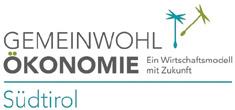
Entdecke unseren Onlineshop
Scopri il nostro shop online
Discover our online shop

Versand in ganz Europa
Spedizioni in tutta Europa
Delivery throughout Europe
www.pursuedtirol.com




In wenigen Minuten von Meran in höhere Lagen –von Vellau, oberhalb von Algund, eröffnet sich ein atemberaubender Blick auf den gesamten Talkessel.
Dalla frazione di Velloi, raggiungibile in pochi minuti da Lagundo, si gode di un panorama spettacolare sull’intera conca meranese e la Val d’Adige.
In just a few minutes from Merano to higher elevations: you can enjoy breathtaking views of the entire valley basin from the village of Velloi, just above Lagundo.

Ziegen füttern, Zwergschafe streicheln, Kamele bestaunen. Oberhalb des Dorfes Gfrill befindet sich der alte Bergbauernhof Rainguthof, der mit seinem Freiluftgelände in ein wahres Paradies für Familien mit Kindern
umgebaut wurde. Neben heimischen Tieren wie Schweinen, Kühen und Rehen können auch Exoten wie Lamas und Kamele beobachtet werden. Auf das bereitgestellte Futter freuen sich die Tiere besonders. Ein Spiel-
platz macht den Ausflug in den Streichelzoo perfekt. Freiwillige Spende erwünscht.
Caprette, pecore nane e persino cammelli tutti da accarezzare: si trovano allo storico
maso Rainguthof, sopra il paese di Caprile, che ospita diversi animali in recinti all’aperto, da quelli autoctoni come maiali, mucche e cerbiatti fino ad alcuni esotici come i lama. Si tratta di un vero paradiso per le famiglie con bambini, i quali, oltre ad ammirare i numerosi animaletti, possono anche dare loro il mangime messo a disposizione oppure divertirsi presso il vicino parco giochi. È gradita un’offerta libera.
Feed goats, pet pygmy sheep and marvel at camels. The old Rainguthof mountain farm is located above the village of Caprile. Its outdoor area has been transformed into a true paradise for families with children. In addition to domestic animals, including pigs, cows and deer, you can also meet exotic animals like llamas and camels. Children can look forward to feeding the animals with the provided food. A playground makes the trip to this petting zoo perfect. Donations are appreciated.
Der Tappeinerweg oberhalb von Meran zählt zu den längsten und schönsten Höhenpromenaden Europas. Der Spazierweg wurde nach dem Kurarzt, Anthropologen und Botaniker Franz Tappeiner (1816–1902) benannt und konnte vor allem durch seine großzügigen Spenden in drei Bauabschnitten (1893, 1911 und 1928) angelegt werden. Wärmeliebende Mittelmeerzypressen und Pinien prägen die üppige Vegetation mit Blick auf die Stadt, das Meraner Becken und die atemberaubende Bergkulisse am Tappeinerweg.
La Passeggiata Tappeiner, sopra Merano, è tra la più lunghe e belle d’Europa nel suo genere. Il soleggiato itinerario è stato dedicato al medico, antropologo e botanico Franz Tappeiner (1816-1902), poiché fece cospicue donazioni per la sua
realizzazione, che avvenne in tre fasi: 1893, 1911 e 1928. Lungo il percorso prospera una rigogliosa vegetazione, dove si alternano pini, cipressi e altre specie sia locali che mediterranee. Inoltre, si gode di una vista straordinaria sulla città, sulla conca atesina e sulle montagne circostanti.
The Tappeiner Promenade above Merano is one of the longest and most beautiful alpine promenades in Europe. Named after Franz Tappeiner (1816–1902) – spa physician, anthropologist and botanist – it was constructed in three stages (1893, 1911 and 1928). This was made
possible thanks to his generous donations. The lush vegetation along the path is characterised by warmth-loving Mediterranean cypresses and pine trees.
The Tappeiner Promenade offers views of the town as well as the Merano basin and the breathtaking mountain scenery.




Bewegungseinheit im urbanen Grün
Esercizi guidati nel verde urbano
Exercise sessions in green urban spaces



Spazieren, Entdecken und Genießen in Gesellschaft
La passeggiata enogastronomica Walk, explore and indulge

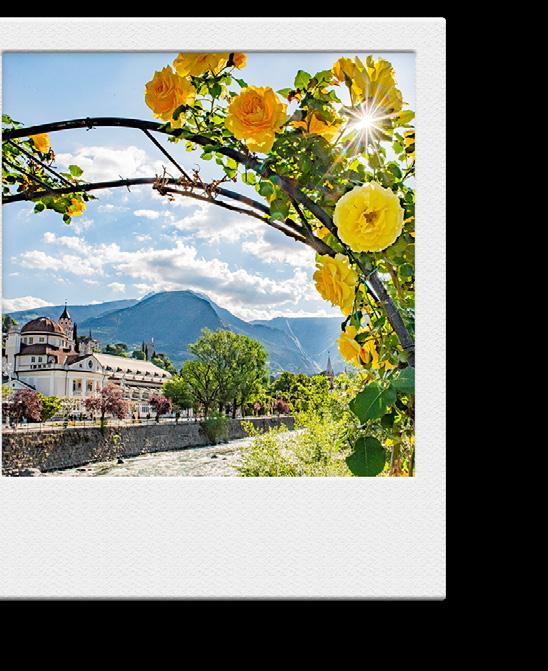


TUESDAY NIGHT
Musikalischer Kulttermin des Meraner Sommers
L’evento musicale cult dell’estate
The musical events of the summer
Promenaden und Palmen, Gärten und Parks, Villen und Prachtbauten. Das ist Meran. Meran sind auch wir, seine Bewohnerinnen und Bewohner. Unser italienisches Lebensgefühl, unsere alpinen Spezialitäten, die italienische Kochkunst; manchmal zwischen Kaiserschmarrn und Vernatsch, ein anderes Mal zwischen „Pasta all’arrabbiata“ und einem Tiramisu. Unsere Musiker, die in langen Sommernächten die Stadt beleben. Die Stadtführer, die von über 700 Jahren Stadtgeschichte berichten. Jene, die unsere Straßen sauber
halten, das urbane Grün pflegen, die in den Küchen zaubern. Wir sind die Alteingesessenen, die gerade Angekommenen. Jene, die den Zauber der Stadt, die Natur in den Parks und das Leben in der Passer erhalten möchten. Meran, das sind wir alle.
Passeggiate tra vette e palme, parchi e giardini, ville e sfarzosi edifici. Questa è Merano. Ma Merano siamo anche noi, che la abitiamo. Quella dolce vita italiana mista alla
alternate ai sapori mediterranei, tra il Kaiserschmarrn e il tiramisù, le penne all’arrabbiata sul piatto e la Schiava nel calice. Sono i musicisti che animano il centro durante le lunghe sere d’estate. Le guide che raccontano gli oltre settecento anni di storia della città. Coloro che mantengono pulite le strade e curano gli spazi verdi, quelli che creano manicaretti nelle cucine. Chi ci vive da sempre e chi è appena arrivato. Chi desidera preservare la magia della città, la natura circostante e la vita nel torrente Passirio. Merano è tutto questo – e molto di più.
Promenades and palm trees, gardens and parks, villas and stately mansions. This is Merano. We, its inhabitants, are also Merano. Our Italian lifestyle, our Alpine delicacies, our Italian cuisine: sometimes between Kaiserschmarrn and Vernatsch, other times between pasta all'arrabbiata and a tiramisu. Or the musicians who enliven the city during the long summer nights. The city guides who tell of the city's 700 years of history. The people who keep our streets clean, maintain the urban greenery, who work their magic in the kitchens. We are the long-established and the new arrivals. We are those who want to preserve the magic of the city, the natural beauty of the parks and the life along the River Passirio. Merano, that's all of us.


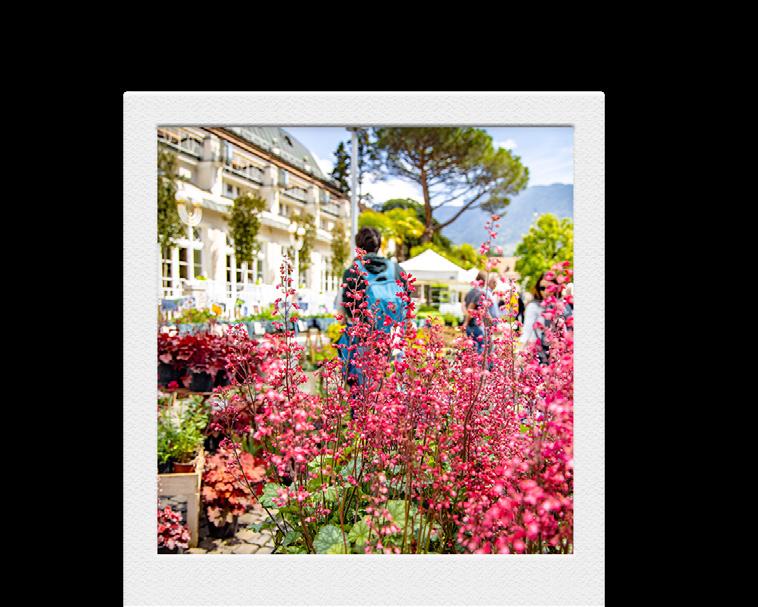

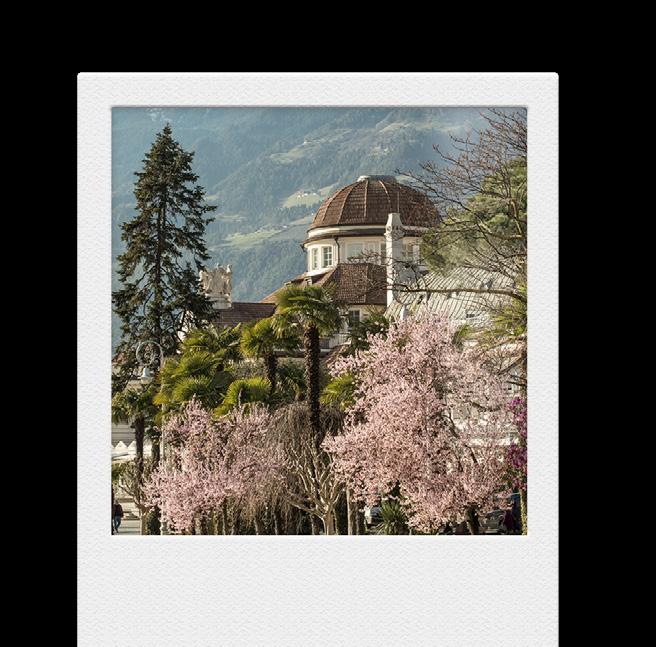




WERTGUTSCHEINE
VIP-GONDEL
ALPIN BOB ALS GESCHENK
BUONI VALORE
CABINA VIP O ALPIN BOB COME REGALO
VALUE VOUCHER
VIP GONDOLA
ALPIN BOB AS A GIFT
MINUTEN FAHRT MIT DER GRÖSSTEN SEILBAHN SÜDTIROLS
MINUTI DI VIAGGIO CON LA FUNIVIA
PIÙ GRANDE DELLʼALTO ADIGE
MINUTES RIDE WITH SOUTH TYROLʼS LARGEST ROPEWAY
KRAFT, BALANCE, GESCHICKLICHKEIT = BERGABENTEUER!
EQUILIBRIO, FORZA, AGILITÀ = AVVENTURA IN MONTAGNA!
BALANCE, STRENGTH, AGILITY = MOUNTAIN ADVENTURE!



L’affascinante mondo delle succulente
The spellbinding world of succulents


Sukkulenten präsentieren sich in unterschiedlichsten Formen.
Le succulente si presentano nelle forme più disparate.
Succulents can take many different forms.


Überlebenskünstler – so lassen sich Sukkulenten mit einem Wort beschreiben. Die Pflanzen haben erstaunliche Strategien entwickelt, um an den besonders trockensten Orten der Welt zu gedeihen. Die berühmteste Sukkulente ist der Kaktus, aber wussten Sie, dass auch die Vanille zu dieser Pflanzengruppe zählt? Schon die Mayas und Azteken machten sich dieses Gewürz zu Nutze. Im alten Griechenland hingegen beschrieb der Arzt Dioskurides die Wirkung von Rosenwurz, deren getrocknete Wurzeln nach Rosenblüten duften. Auch die Dach-Hauswurz zählt zu den Heilpflanzen und wurde im Alpenraum als Salbe unter anderem bei Insektenstichen und Verbrennungen verwendet und nebenbei sollte sie auf dem Dach auch noch vor Blitzeinschlägen schützen. Das entzündungshemmende und kühlende Gel der Aloe Vera wiederum wird noch heute vielen Kosmetikprodukten zugesetzt. Doch Sukkulenten liefern uns auch köstliche Früchte, wie Ananas und Papaya, werden zu Genussmitteln wie Tequila weiterverarbeitet und hielten mitunter als Halluzinogene in die Drogenszene Einzug. Und wer hätte gedacht, dass sich die resistenten Fasern der Sisalagave sogar in Teebeuteln und Banknoten wiederfinden? Noch mehr kuriose Geschichten und interessante Fakten gilt es bei einem Besuch der Sonderausstellung „Succu… was?“ in den Gärten von Schloss Trauttmansdorff vom 29. März bis 15. November zu entdecken. Tauchen Sie nur wenige Minuten vom Zentrum Merans entfernt in die faszinierende Welt dieser Überlebenskünstler ein!
Maestre di sopravvivenza, ecco come si potrebbero descrivere le succulente. Queste piante, infatti, hanno escogitato ingegnose strategie per prosperare in zone molto aride. La più famosa è certamente il cactus, ma lo sapevate che anche la vaniglia appartiene allo stesso raggruppamento botanico? Questa spezia era nota già ai Maya e agli Aztechi, men-
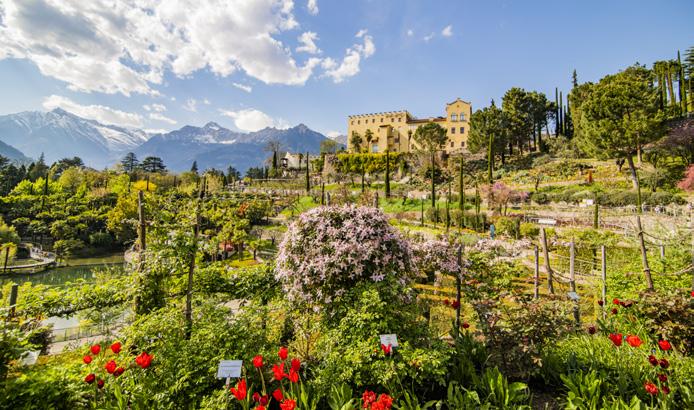
tre ai tempi dell’antica Grecia il medico Dioscoride descrisse le proprietà della rodiola rosea, così chiamata per il profumo di rosa delle sue radici essiccate. Anche il semprevivo maggiore – popolarmente noto come “dei tetti” perché si credeva che crescendo lì proteggesse dai fulmini – era considerato una pianta grassa medicinale e, nell’arco alpino, veniva adoperato sotto forma di unguento contro punture di insetti o ustioni. Ancora, il gel dell’aloe vera, rinfrescante e antinfiammatorio, trova tutt’oggi impiego in molti cosmetici. Le succulente, inoltre, danno deliziosi frutti, tra cui l’ananas e la papaya, o vengono distillate per produrre la tequila; addirittura, in passato da alcune si estraevano sostanze allucinogene. E chi l’avrebbe mai detto che per le bustine di tè e le banconote si utilizzassero le resistenti fibre della sisal? Per conoscere altre curiosità riguardo a queste piante, visitate la mostra temporanea “Succu… cosa?” presso i Giardini di Castel Trauttmansdorff dal 29 marzo al 15 novembre, a pochi minuti dal centro di Merano. Lasciatevi affascinare dal variegato mondo delle succulente!
The best word to describe succulents is “survivalists”. These plants have developed amazing coping strategies to thrive in particularly dry places around the world. The most famous succulent is probably the cactus – but did you know that vanilla also belongs to this plant family? The Maya and Mēxihcah (formerly Aztecs) already utilised this aromatic spice. By contrast, in ancient Greece, the physician Dioscorides described the effect of the dried roots of roseroot, which smell of rose petals. The common houseleek is another medicinal plant. In the Alpine region, it was used as an ointment for insect bites and burns, amongst other things. In addition, it was also believed to protect against lightning strikes when grown on the roof. The anti-inflammatory and cool gel of the aloe vera plant is added to many cosmetic products to this day. However, succulents also provide us with delicious fruits such as pineapples and papayas. They are processed into concoctions such as tequila and are sometimes even used as hallucinogens in the drug scene. Who would have guessed that the resistant fibres of the sisal agave can be found in tea bags and banknotes? Discover many more curious stories and interesting facts during a visit to the special exhibition “Succu... what?” in the Gardens of Trauttmansdorff Castle from March 29th to November 15th. Immerse yourself in the fascinating world of these survival artists – just a few minutes from the city centre of Merano!
St-Valentin-Str. | Via San Valentino 51A I-39012 Meran/o
T. +39 0473 255600 info@trauttmansdorff.it www.trauttmansdorff.it
DE Ja zur kompletten Nachhaltigkeit bei Wein und in der Gastronomie: So lässt sich das Konzept „Sostökonomie“ des visionären Schirmherrn Helmuth Köcher des Merano WineFestival am besten beschreiben. Unter dem Motto „Back to the roots“ findet die 33. Ausgabe der Veranstaltung vom 8. bis zum 12. November statt – für eine Rückkehr zum „Duft der Erde“. Neben der klassischen Veranstaltung erwarten die Besucher weitere Highlights, wie der internationale Bereich mit Produkten aus aller Welt. Im Einklang mit dem von Köcher ausgerufenen Motto stehen zwei weitere Events auf dem Programm: Bei Bio & Dynamik dreht sich alles um biologische, biodynamische, organische und orange Weine, während beim Nachhaltigkeitsgipfel „Breath and Cry of the Earth“ Probleme und Lösungen bezüglich des Klimawandels diskutiert werden. Experten der grünen Branche, bedeutende Persönlichkeiten der Weinwelt, Sterneköche, Institutionen, Prominente und Künstler werden in diesen Tagen zu Botschaftern der Qualität dieser Veranstaltung.
IT Si tratta di un nuovo concetto ideato da Helmuth Köcher, il visionario patron del Merano WineFestival che vuole dire sì alla piena sostenibilità del settore food & wine. Il claim della 33^ edizione dell’evento, che si terrà dall’8 al 12 novembre, rimane “Back to the roots”, a sottolineare ulteriormente la volontà di un ritorno alle origini, ai profumi autentici della terra. Oltre al format classico, vengono proposti nuovi highlight, come lo spazio International, dedicato ai prodotti dal mondo. In linea con il tema promosso da Köcher per la kermesse sono anche bio&dynamica – con ampio focus su vini organici, biodinamici e orange – e il summit sulla sostenibilità “Breath and Cry of the Earth”, volto a discutere costruttivamente di problematiche e soluzione legate ai cambiamenti climatici. Sono attesi numerosi ospiti, come esperti del settore green, personalità di spicco dell’enologia, chef stellati, istituzioni e artisti, i quali si fanno tutti promotori dell’eccellenza in ogni sua sfumatura.


EN An innovative concept created by the visionary patron of the Merano WineFestival Helmuth Köcher, who wants to fully embrace sustainability in the food and wine sector. The slogan of the 33rd edition of the event, which will be held from 8 to 12 November, is “Back to the Roots”, which further underlines the desire to return to the origins, to the authentic scents of the earth. In addition to the classic format, new highlights are proposed, such as the international space, which is dedicated to

Das Event findet vom 8. bis 12. November statt.
Il Merano WineFestival torna dall’8 al 12 novembre.
The Merano WineFestival returns from 8 - 12 November.
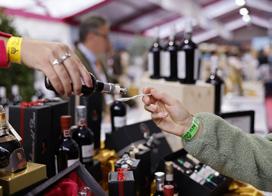
products from all over the world. Bio&dynamica – with a broad focus on organic, biodynamic and orange wines – and the sustainability summit “Breath and Cry of the Earth” – highlighting and discussing issues and solutions related to climate change – are also in line with the theme promoted by Köcher for the event. Numerous guests are expected, such as experts in the green sector, prominent wine personalities, starred chefs, institutions and artists, all promotors of excellence in its varied nuances.


Rolando


DO-GI 22.08. ROLANDO VILLAZÓN . LAUTTEN COMPAGNEY BERLIN
MO-LU 26.08. JANOSKA ENSEMBLE
DI-MA 27.08. WIENER KAMMERORCHESTER . SEBASTIAN KNAUER
DO-GI 29.08. PITTSBURGH SYMPHONY ORCHESTRA (USA) MANFRED HONECK
FR-VE 30.08. ARS NOVA COPENHAGEN . SOFI JEANNIN
DO-GI 05.09. PHILHARMONIA ORCHESTRA LONDON DANIELE RUSTIONI . YULIANNA AVDEEVA
SO-DO 08.09. LATVIAN VOICES
MI-ME 11.09. UTE LEMPER & BAND
DO-GI 12.09. STAATSKAPELLE DRESDEN DANIELE GATTI . RUDOLF BUCHBINDER
MO-LU 16.09. TOBIAS MORETTI & ARMONICO TRIBUTO
DI-MA 17.09. ZÜRCHER KAMMERORCHESTER . DANIEL HOPE
MI-ME 18.09. MNOZIL BRASS
DO-GI 19.09. ORCHESTRA DELL’ACCADEMIA NAZIONALE DI SANTA CECILIA . GIANANDREA NOSEDA
MO-LU 23.09. WIENER SYMPHONIKER . PETR POPELKA
Präsident-Presidente: Hermann Schnitzer Intendant-Direttore artistico: Andreas Cappello
www.meranofestival.com
event sponsors: main sponsors:
A tribute to the Inca

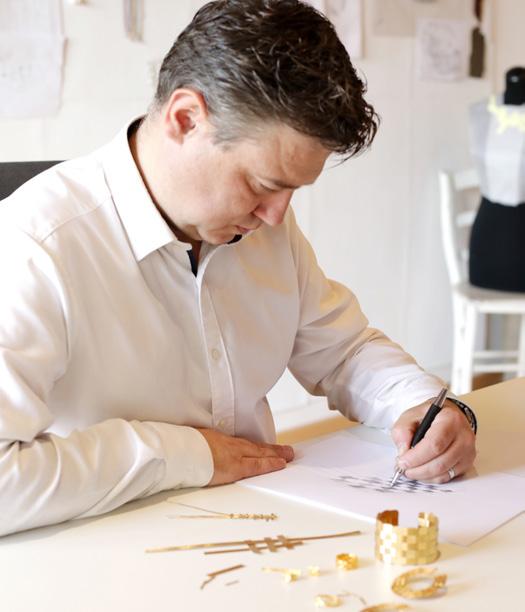

Das Reich der Tawantinsuyu, oder auch Inka genannt, zählt wohl zu den wohlhabendsten seiner Zeit. Faszinierend ist vor allem ihre hochwertige Verarbeitung von Gold, das wegen seiner Schönheit als heiliges Material verehrt wurde. Die Geschichte der südamerikanischen Hochkultur fesselte auch Goldschmiede wie Hannes Gamper, Schmuckdesigner und CEO von Tiroler Goldschmied. Mit seiner eigenen „Inka Kollektion“ von La Preziosa feiert er eine Hommage an die geschickten Goldschmiede der Alten Welt. Ein Armreif mit spezieller Oberflächenbearbeitung und aufwändig miteinander verflochtenen Goldstreifen, der sich federleicht an den Körper der Trägerin schmiegt, erlangte sogar eine besondere Auszeichnung: Mit dem renommierten German Design Award 2024 in der Kategorie „Excellent Product Design/ Luxury Goods“ krönt der studierte Bildhauer und Goldschmied seine langjährige Leistung und führt das Wirken des größten Juweliers Südtirols mit großem Erfolg fort.
L’impero di Tawantinsuyu, ovvero del popolo inca, fu probabilmente uno dei più prosperi del suo tempo. Ciò che affascina in modo particolare di questa civiltà è la maestria con cui veniva lavorato l’oro – venerato come un materiale sacro per via della sua
bellezza. Oggi, la storia della cultura alta sudamericana attrae orafi come Hannes Gamper, designer di gioielli e CEO di Tiroler Goldschmied, il quale ha voluto rendere omaggio agli abili “colleghi” del mondo antico, realizzando la collezione Inka per il suo marchio La Preziosa. Il bracciale rifinito con strisce d’oro intrecciate in superficie, che avvolge delicatamente il polso di chi lo indossa, è stato persino insignito del prestigioso “German Design Award 2024”, nella categoria “Excellent Product Design – Luxury Goods”. Un riconoscimento che corona i tanti anni di professione dello scultore e orafo esperto, che porta avanti con successo il più grande e rinomato punto di riferimento nel settore della gioielleria in Alto Adige.
The Tawantinsuyu Empire, also known as the Inca Empire, was probably one of the most prosperous in its time. Their sophisticated craftsmanship with gold, which was revered as a sacred material due to its beauty, is particularly fascinating. The history of the South American civilisation also fascinated goldsmiths such as Hannes Gamper, jewellery designer and CEO of Tiroler Goldschmied. With his own “Inka collection” from La Preziosa, he pays homage to the skillful goldsmiths of the ancient world. A bangle with an intricately in-
terwoven gold strip and a special surface finish, that nestles against the wearer's body as light as a feather, even won a special award. Gamper, who studied sculpture and goldsmithing, crowned his many years of achievement with the prestigious German Design Award 2024 in the “Excellent Product Design/Luxury Goods” category and continues the work of South Tyrol's largest jeweller with great success.
Meran | Merano
Tirol | Tirolo | Tyrol Schenna | Scena
Quellenhof Italy
Rottach-Egern am Tegernsee Germany
www.tirolergoldschmied.it



Our world keeps spinning!
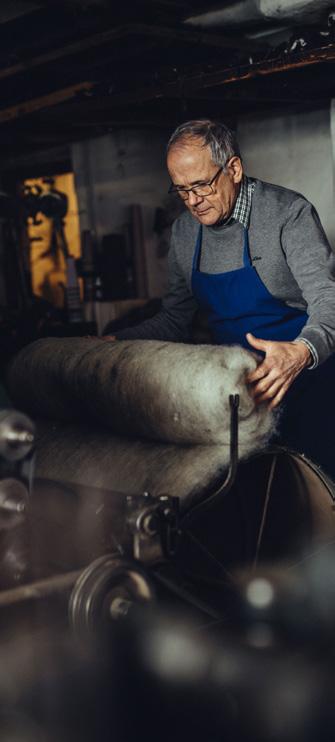
Traditionshandwerk aus St. Leonhard im Passeiertal Spinnradl hat sich im Laufe der Zeit einen Namen gemacht, wenn es darum geht, aus Südtiroler Bergschafwolle besondere Strickjacken zu kreieren, die ganz auf die individuellen Bedürfnisse des Kunden angepasst sind. Jeder Arbeitsschritt, von der Wollverarbeitung bis hin zur Maßanfertigung, wird in den Werkstätten in St. Leonhard in Passeier mit viel Engagement und Herzblut ausgeführt. Auf diese Weise garantieren die Hersteller, dass jede Eigenkreation das Siegel eines Unikats trägt und durch seine hochwertige Verarbeitung ein Leben lang hält. Das Geschäft mit der Maßschneiderin im Ortszentrum lädt ein, das vielfältige Wollsortiment kennenzulernen.
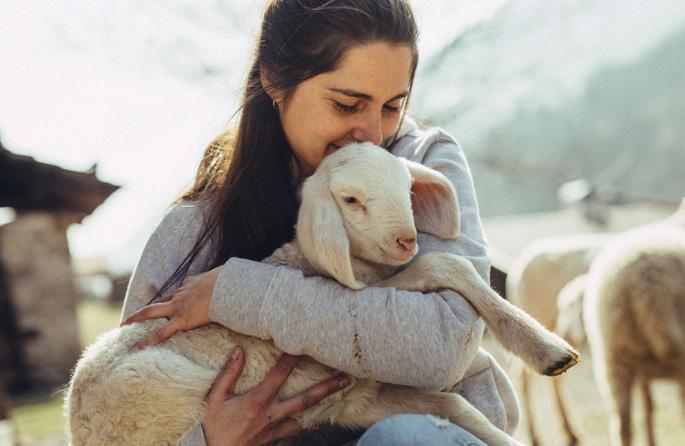


Artigianato tradizionale a San Leonardo in Val Passiria Nel corso degli anni, la sartoria Spinnradl si è fatta un nome nella creazione di maglieria in lana di pecora alpina tirolese, realizzata secondo le esigenze di ogni singolo cliente. Dalla lavorazione della materia prima alla personalizzazione finale, ciascuna fase del processo di produzione viene svolta con dedizione e passione, nei laboratori di San Leonardo in Passiria. L’obiettivo è di garantire l’unicità dei vari capi e la loro durata nel tempo, grazie anche a un trattamento di alta qualità. Sita nel centro del paese della Val Passiria, questa sartoria su misura invita ad andare a scoprire l’ampia gamma di prodotti in lana di cui dispone.

Over the years, Spinnradl has made a name for itself when it comes to creating special cardigans made from South Tyrolean mountain sheep’s wool. The cardigans are completely customisable to the individual needs of the client. Each step of the process – from processing the wool to the customisation – is carried out with great dedication and passion in the workshops located in San Leonardo in Passiria. The manufacturers thus guarantee that each of their in-house creations bears the seal of uniqueness and lasts a lifetime thanks to its high-quality craftsmanship. The tailor’s shop in the town centre invites you to discover the wide range of wool products.
www.spinnradl.it
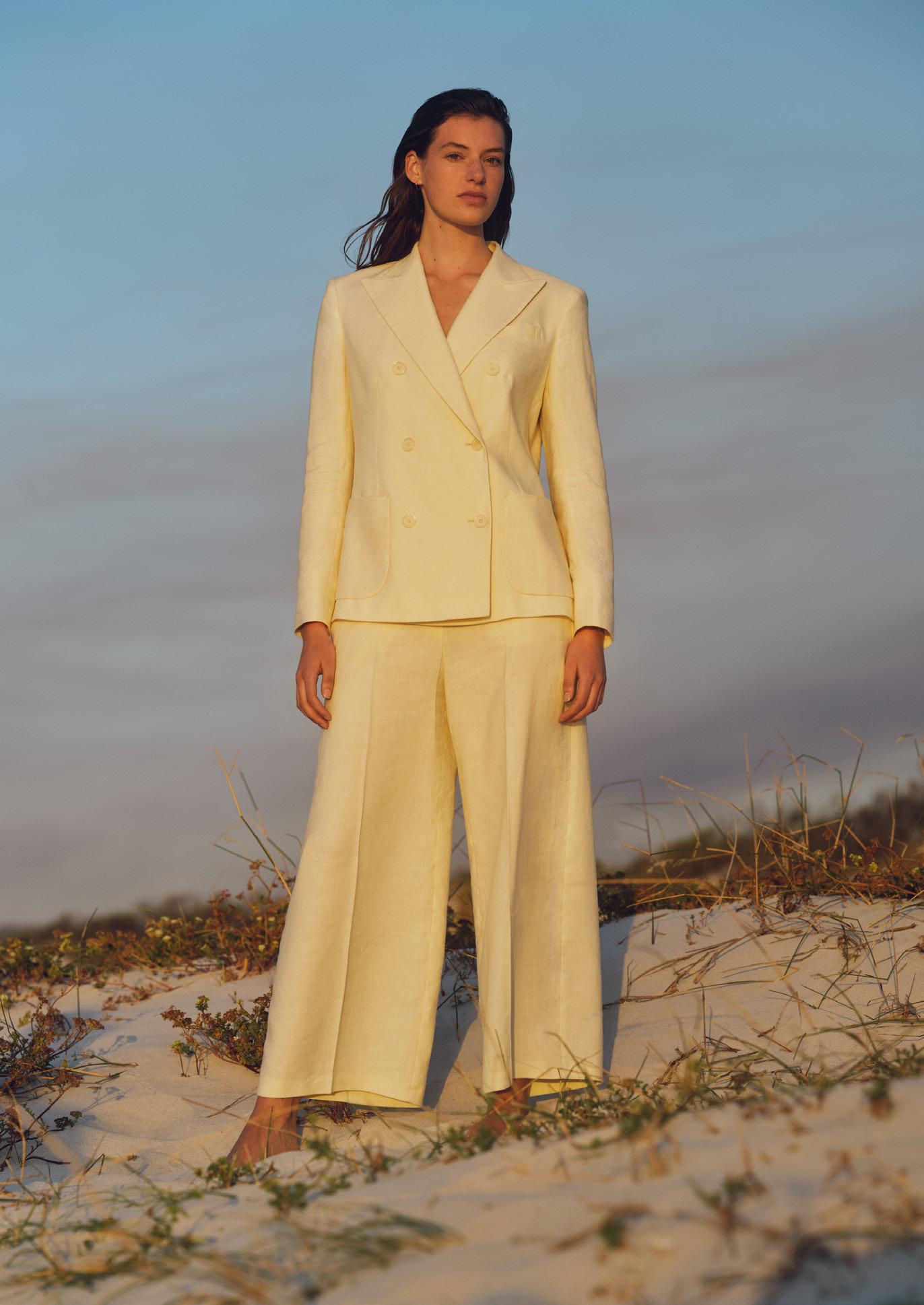

Die Kabinenbahn König Laurin bringt Aktivbegeisterte auf angenehme Weise hoch auf den Rosengarten, wo zahlreiche Wanderwege und Klettersteige beginnen..
La moderna funivia König Laurin porta comodamente ai piedi del Gruppo del Catinaccio, da dove partono numerosi itinerari escursionistici così come vie ferrate.
The King Laurin cable car transports outdoor enthusiasts comfortably up the Catinaccio Group, where numerous hiking trails and via ferratas begin.

Und fünf, sechs, sieben, acht … Wärmen Sie sich für das Festival „Tanz Bozen“ auf, das vom 12. bis 27. Juli zum 40. Mal in der Hauptstadt Südtirols stattfindet. Jedes Jahr können Sie bei diesem Event, das von der Stiftung Haydn
An der Südtiroler Weinstraße nahe Bozen befindet sich ein Naturjuwel: der Kleine Montiggler See. Den Badesee können Sie bei einem ca. 30-minütigen Spaziergang umrunden, der für alle geeignet ist. Dank der üppigen Vegetation der Nadel- und Laubwälder, die vor den Sonnenstrahlen schützen, ist der Ausflug an heißen Sommertagen besonders angenehm. Wer gerne noch länger in dieser malerischen Umgebung verweilt, dem sei ein Abstecher zum Strandbad mit Restaurant oder zum Großen Montiggler See empfohlen.
A breve distanza da Bolzano, lungo la Strada del vino, si trova una perla naturale del territorio altoatesino: il Lago piccolo di Monticolo, balneabile e cinto da un sentiero che si snoda all’ombra di conifere e latifoglie. La passeggiata, di trenta minuti circa e adatta a tutti, è piacevole specie nelle giornate più calde, grazie alla vegetazione che assicura riparo dal sole. Chi desidera prolungare
organisiert wird, künstlerischen Darbietungen im Stadttheater sowie an anderen Orten der Stadt beiwohnen. Außerdem bietet das Südtiroler Kulturinstitut ein abwechslungsreiches Workshopprogramm für verschiedene
la propria permanenza in questo quadro idilliaco può soffermarsi al lido e al suo ristorante oppure raggiungere il Lago grande.
Along the Wine Route near Bolzano, there is a South Tyrole-
Tanzstile und Altersklassen. Sind Sie bereit, Bozen im Tanzschritt zu erkunden?
E cinque, sei, sette, otto… Iniziate a scaldarvi in attesa del festival Bolzano Danza, che dal 12
an highlight: the Small Monticolo Lake. It is perfect for swimming and is surrounded by a winding path in the shade of lush vegetation. The walk, which takes about 30 minutes and suitable for everyone, is especially pleas-
al 27 luglio animerà il capoluogo altoatesino celebrando il suo 40° anniversario. Ogni anno, l’evento organizzato dalla Fondazione Haydn affianca alle performance artistiche – ospitate nel Teatro comunale così come in vari luoghi della città – anche un variegato programma di workshop per appassionati e curiosi di ogni genere ed età, a cura di Südtiroler Kulturinstitut. Siete pronti a (ri)scoprire Bolzano a passo di danza?
And five, six, seven, eight... Warm yourself up in anticipation of the 40th anniversary of the Bolzano Danza festival, which will liven up the South Tyrolean capital from 12 to 27 July. The event organised by the Haydn Foundation combines artistic performances hosted in the municipal theatre, as well as in various places in the city, every year. Discover a varied programme of workshops for people of all ages, organised by the “Südtiroler Kulturinstitut". Are you ready to (re)discover Bolzano through dance?
ant on the hottest summer days, thanks to the trees that provide shelter from the sun. Those who wish to extend their stay in this idyllic setting can stop at the lido and its restaurant or continue on to the Big Monticolo Lake.

In posizione centrale ed esclusiva Enjoy an exclusive, central location

Il nuovo cuore di Bolzano

Es ist das exklusivste Wohnen Südtirols: direkt im Zentrum der Landeshauptstadt Bozen, zwischen Hauptbahnhof und Altstadt gelegen, mit dem Auto erreichbar und dennoch fernab vom Straßenlärm. Die ersten Wohnungen werden im Frühling 2025 übergeben. Derzeit wird noch eifrig gearbeitet auf der Baustelle des WaltherPark, das einzigartige, innovative und nachhaltige Projekt im Herzen Bozens aus der Feder von Weltarchitekt und Pritzker-Preisträger 2023 David Chipperfield. Das Beste: Am Dach des Baukörpers beginnt das Wohnen, das Parterre liegt
in 15 m Höhe und hat private Gärten. Loggias und Terrassen der oberen Etagen eröffnen den Blick in die Weite. Penthouse-Wohnungen bieten freie Sicht auf den gesamten Talkessel und den umliegenden Horizont.
Se cercate le abitazioni più in dell’Alto Adige, le troverete nel cuore di Bolzano, tra la stazione ferroviaria e il centro storico –eppure accessibili con l’auto e isolate dai rumori della città. Sono gli appartamenti del WaltherPark e i primi saranno consegnati nella primavera 2025. Lavori in corso, dunque,
nel cantiere di questo progetto unico, innovativo e sostenibile, ideato dall’architetto di fama mondiale David Chipperfield, vincitore del Premio Pritzker nel 2023. Le particolarità? Gli appartamenti si sviluppano sul tetto dell’edificio, a 15 m di altezza, dove si trova anche un’area verde con giardini privati. Quelli con loggia e terrazza ai piani superiori godono di ampi scenari, mentre gli attici offrono una vista unica sul parco e sulle Dolomiti.
This is the most exclusive residential area in South Tyrol: located right in the centre of the capital city Bolzano, between the main railway station and the old town. It is accessible by car and yet far away from the hustle and bustle of the streets. The first apartments will be ready in spring of 2025. Walth-

erPark's construction work is currently in full swing. This unique, innovative and sustainable project in the heart of Bolzano was designed by world renowned architect and 2023 Pritzker Prize winner David Chipperfield. The best part? Residential apartments will begin on the roof of the building. The ground floor apartments are situated at a height of 15 m and will have private gardens. Loggias and terraces on the upper floors open up views into the surrounding breathtaking landscape, while penthouses will offer uninterrupted views of the beautiful surrounding Dolomites.
2-3-4-Zimmer- und Penthouse-Wohnungen stehen zum Verkauf.
Bi-, tri-, quadrilocali o attici in vendita.
2-3-4-room and penthouse flats for sale.
T. +39 0471 1830460
sales@waltherpark.com www.waltherpark.com
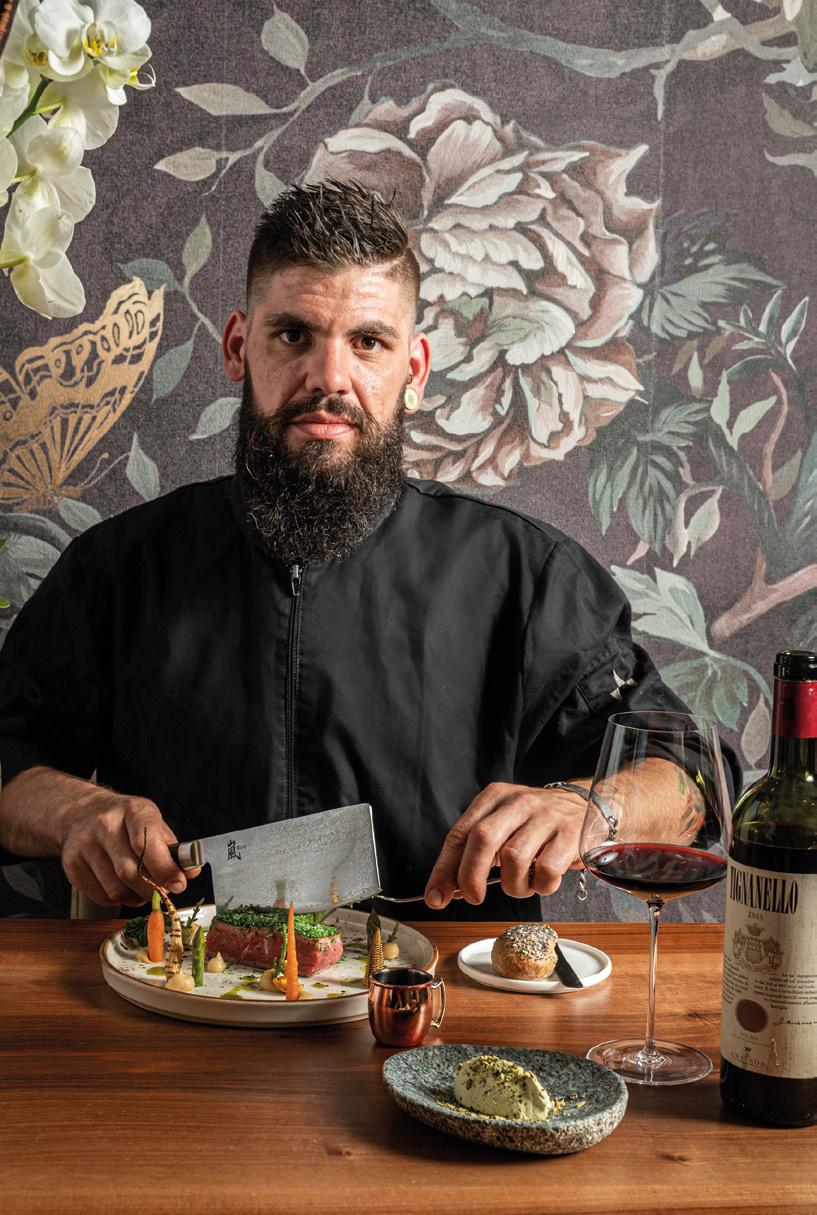

Wir präsentieren Ihnen unsere herausragende Tätigkeit im Bereich des Recyclings und Schrotthandels. Seit über 65 Jahren gelten wir als wichtige Adresse in diesem Sektor und bemühen uns seitdem, die Auswirkungen auf die Umwelt durch innovative Lösungen und führende Beratung zu reduzieren. Vertrauen, Transparenz und Professionalität bilden die Basis unserer Dienstleistungen. Unser Ziel ist es, eine nachhaltige Zukunft zu kreieren, in
Wir sammeln und entsorgen auch gefährliche und medizinische Abfälle.
Raccogliamo e smaltiamo anche rifiuti pericolosi e sanitari.
We also collect and dispose of hazardous and sanitary waste.

der ein verantwortungsvolles Wastemanagement zum Schlüssel für eine saubere und gesunde Umwelt wird. Gemeinsam können wir etwas bewegen und zu einer Welt beitragen, in der Nachhaltigkeit im Zentrum einer jeden Entscheidung steht.
Presentiamo la nostra eccellenza nel riciclaggio dei rifiuti e nel commercio di rottami. Siamo un punto di riferimento nel settore da oltre sessantacinque anni, e da sempre ci impegniamo a ridurre l’impatto ambientale attraverso soluzioni innovative e consulenze all’avanguardia. Il nostro servizio si fonda sui valori della fiducia, della trasparenza e della professionalità. L’obiettivo è quello di creare un futuro sostenibile, dove la gestione responsabile dei rifiuti è la chiave per un ambiente più pulito e prospero. Insieme possiamo fare la differenza: contribuire a un mondo in cui la sostenibilità è al centro di ogni decisione.
We are proud to represent excellence in waste recycling and scrap trading. We have been a leader in the sector for over 65 years, always committed to reducing environmental impact through innovative solutions and cutting-edge consultancy. Our service is based on the values of trust, transparency and professionalism. The goal is to create a sustainable future, where responsible waste management is the key to a cleaner and more vibrant environment. Together we can make a difference: contribute to a world in which sustainability is at the centre of every decision.
Johannes-Kepler-Straße | Via G. Keplero 5
I-39100 Bozen | Bolzano
T. +39 0471 918191 info@lamafer.com www.lamafer.com
Entdecken Sie unsere Vielfalt an Druckprodukten!
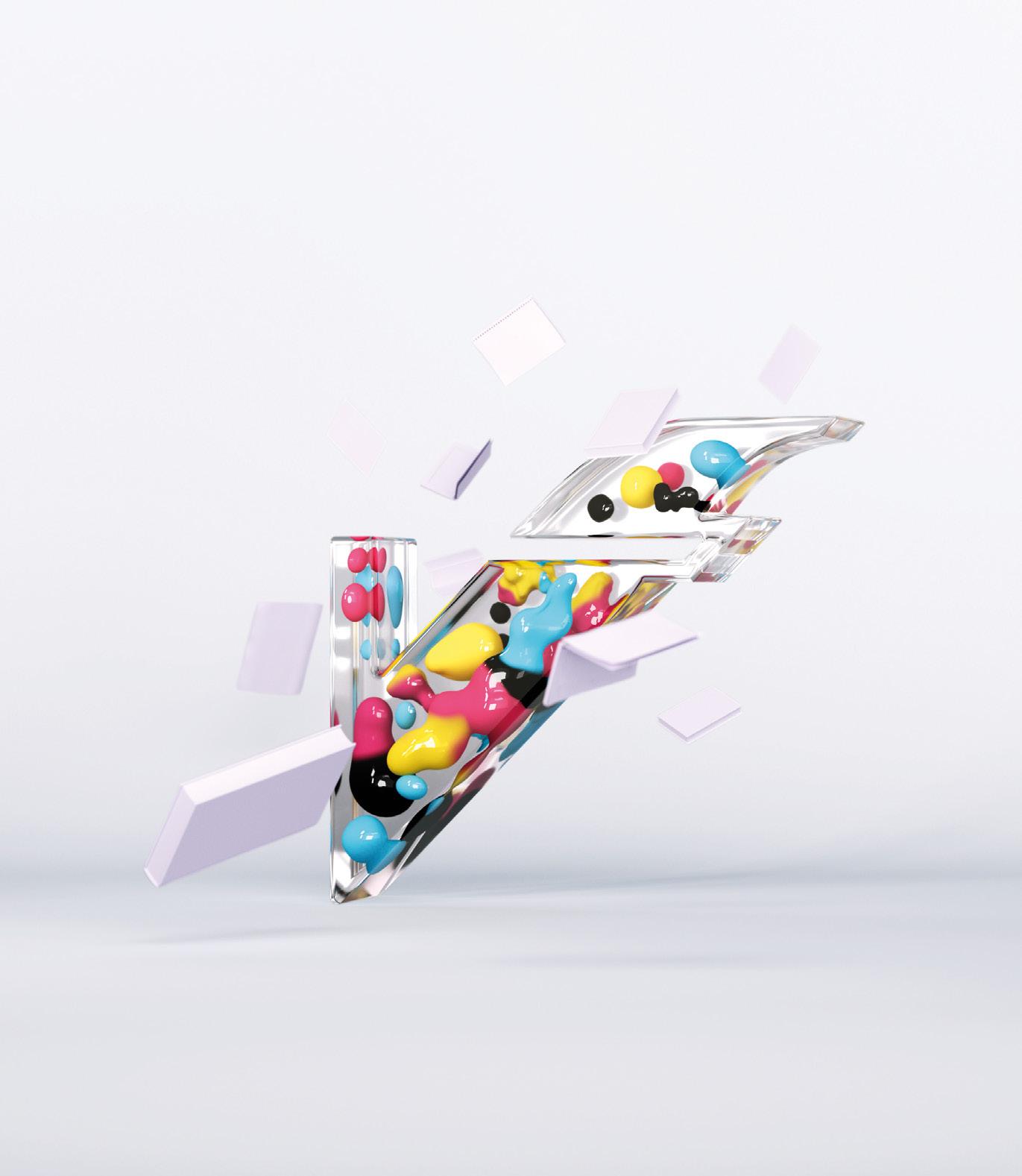
Druckberatung und Gestaltung
Große Produktauswahl
High-QualityDruck Versand und Lieferung
Bestellen Sie jetzt Ihr individuelles Druckprodukt, das Ihre Botschaft hervorragend vermittelt. Wir bieten unschlagbare Preise, erstklassige Qualität und schnelle Lieferung. Entdecken Sie unsere DruckproduktVielfalt auf: varesco.it
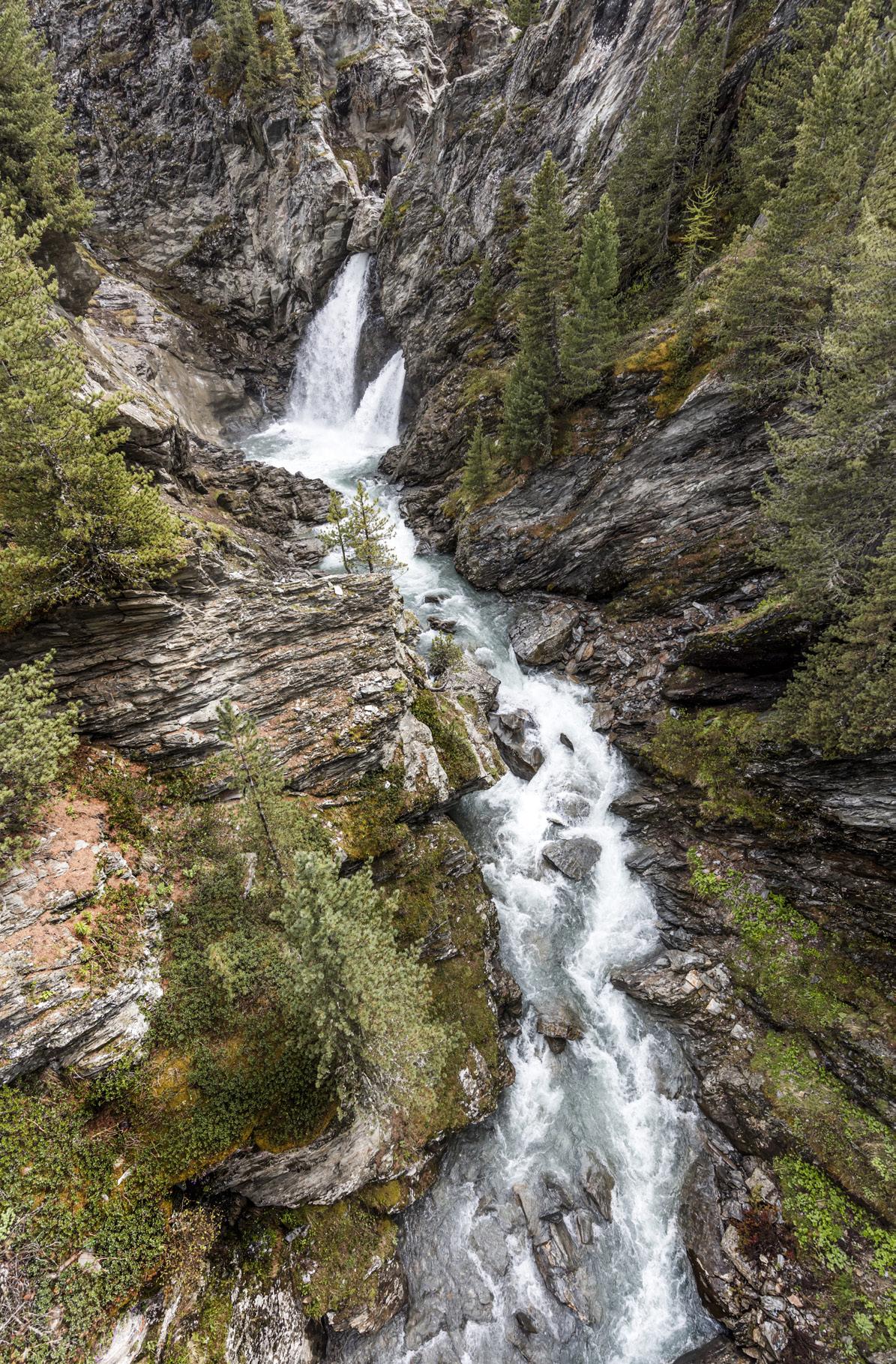
Der Vinschgau begeistert mit idyllischen Plätzen und sonnigen Almen, aber auch mit seiner wilden Natur, wie etwa in der Plimaschlucht im Martelltal.
Un territorio ricco di luoghi idilliaci e soleggiati, ma anche con una natura selvaggia come quella della gola del rio Plima, in Val Martello.
The Venosta Valley will delight you with its idyllic spots and sunny Alpine pastures, but also with its wild nature: like here in the Plima Gorge in Martello Valley.

Sich in Geschicklichkeit üben, Neues ausprobieren und unbekannte Talente entdecken: Im generationsübergreifenden Erlebnispark in Naturns kann man sich in unzähligen
Aktivitäten ausprobieren und spielerisch Eigenschaften wie Geduld und Ausdauer trainieren. Ein spannendes Projekt, das sowohl Kindern als auch Erwachsenen, die im Herzen
jung geblieben sind, einen erfolgreichen Spielenachmittag garantiert. Zwei Grillplätze sowie ein Kiosk mit Getränken und Imbissen stehen den Besuchern zur Verfügung.
Mettere alla prova le proprie abilità, cimentarsi in nuove attività, scoprire talenti nascosti ed esercitare ludicamente pazienza e resistenza: ecco cosa si può fare al parco avventura di Naturno, il quale unisce persone di tutte le generazioni, con tantissimi giochi. Si tratta di un entusiasmante progetto che invita piccoli e grandi – ma sempre bambini dentro – a trascorrere un pomeriggio stimolante. Qui i visitatori troveranno anche due aree barbecue e un chiosco con bevande e snack.
Practise your skills, learn new things and discover unknown talents: You can try your hand at countless activities in the intergenerational adventure park in Naturno and playfully train skills, such as patience and endurance. This exciting project guarantees a memorable afternoon of play for both children and adults who are young at heart. There are also two barbecue areas and a refreshment kiosk with drinks and snacks available to visitors.
Diese spitzen Drachenzähne, die bis zu einem halben Meter aus der Erde ragen, erinnern an eine Filmkulisse. Bei Reschen, an der Grenze zwischen Italien und Österreich, erstreckt sich auf einer Länge von fast 500 m die Panzersperre Plamort, in Beton gegossene Lärchenholz-Pfähle. Die Befestigungsanlage wurde 1938 errichtet und sollte vor einer eventuellen Invasion der deutschen Wehrmacht schützen. Heute sind die Drachenzähne ein denkmalgeschütztes Mahnmal aus einer nicht so weit zurückliegenden Vergangenheit.
Trovarsi di fronte a degli spuntoni di mezzo metro e pensare di essere sul set di un film: può succedere a Pian dei Morti, presso Resia. Al confine tra Italia e Austria, infatti, sorge uno sbarramento anticarro lungo circa 500 m, realizzato con pali in larice infissi nel terreno, rico-
perti di cemento e sormontati da cosiddetti “denti di drago” in acciaio. I lavori furono avviati nel 1938, con lo scopo di proteggere da eventuali invasioni da parte delle forze armate naziste. Oggi, lo sbarramento è sotto tutela dei beni culturali.
The pointed dragon's teeth protruding up to half a metre from the ground are reminiscent of a film set. The Plamort armoured barrier near Resia, on the border between Italy and Austria, stretches over a length of almost 500 m. It is made of larch wood posts
that have been cast in concrete. Built in 1938, the fortification was intended to protect against a possible invasion by the German Wehrmacht. Nowadays, these dragon's teeth are a protected historic monument memorial from a not-so-distant past.

Esperienze da vivere sul Monte Sole | Outdoor experiences on the Monte Sole

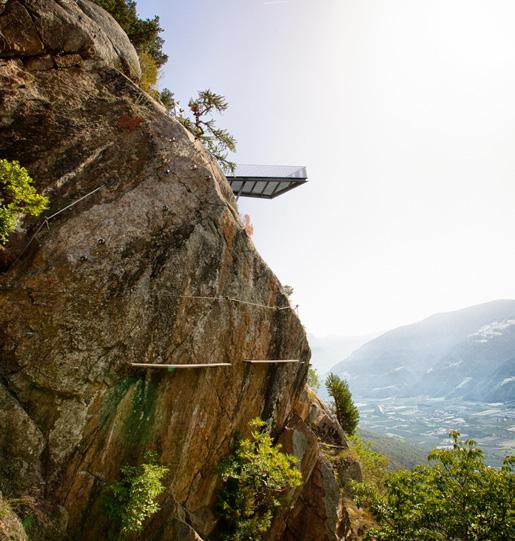
Am Fuße der Texelgruppe gelegen, ist Naturns der ideale Ausgangspunkt für Bergbegeisterte jeglicher Art. Besonders bekannt ist der Meraner Höhenweg, der nicht nur fantastische Panoramablicke bietet, sondern auch durch die legendäre 1000-Stufen-Schlucht führt. Genau genommen, sind es 989 Stufen aus Metall, Holz und Stein sowie eine Hängebrücke, die hier auf Wanderer und Trailrunner warten. Urige Gasthäuser laden auf dem Weg zu einer wohlverdienten Pause ein. Am Ende erreicht man die Bergstation der Seilbahn Unterstell, von wo aus es in wenigen Minuten zurück nach Naturns geht. Vorher aber ist ein Abstecher zur nur 10 Minuten entfernten Aussichtsplattform angesagt, die über einem Felsen 16 m weit in die Luft hinausragt. Übrigens: Besagter Felsen erscheint in Form eines menschlichen Gesichts, genauer gesagt des guten Untersteller Geistes, der am Sonnenberg für Ordnung sorgt. Wer dem Geist besonders nahe kommen möchte, der kann sich über den Übungs- und Familienklettersteig „Knott“ am Felsen hochhangeln. Für erfahrene Kletterer empfiehlt sich hingegen der „Hoachwool“, der entlang des historischen Wasserleitungssystems Schnalstal-Naturns Einblick in die einstige gefährliche Arbeit der zuständigen Bauern gewährt. Seit 2023 sorgen zwei neue Varianten mit Schwierigkeitsstufe E/F und B/C für noch mehr Klettervergnügen. Ob mit oder ohne Kletterausrüstung, eines ist gewiss: Wer Naturns besucht, der darf sich auf ein Wanderparadies und Ausflüge in grenzenlosen Höhen freuen.
Sito ai piedi del Gruppo di Tessa, Naturno è il punto di partenza per variegate esperienze in quota. Un itinerario particolarmente noto tra escursionisti e trail runner è l’Alta via di Merano, che offre scorci mozzafiato e conquista con il leggendario tratto nella Gola dei mille scalini. Per la precisione, i gradini – in metallo, legno o pietra naturale – sono 989, ai quali si aggiunge un suggestivo ponte so-
Der „Knott“ besteht aus vier Klettersteigrouten.
La ferrata Knott presenta quattro itinerari attrezzati diversi.
The "Knott" comprises four via ferrata routes.
speso. Lungo il percorso, è possibile fermarsi in tipiche osterie per una meritata pausa ristoratrice. Alla fine, si raggiunge la stazione a monte della funivia Unterstell, che porta in pochi in minuti a Naturno paese. Prima di scendere a valle, tuttavia, merita recarsi alla piattaforma panoramica, a dieci minuti, che, dalla imponente roccia sulla quale poggia, si protende per ben 16 m nel vuoto. A proposito: tale roccia si dice abbia le sembianze di un volto umano, o, per meglio dire, del cosiddetto “spirito buono di Unterstell”, il quale controlla che sul Monte Sole tutto proceda per il verso giusto. Chi desidera toccare la pietra con mano, può arrampicarsi sulla via ferrata Knott, adatta anche ai principianti. I più esperti, invece, possono percorrere la ferrata Hoachwool, che si sviluppa lungo gli antichi sistemi irrigui tra la Val Senales e Naturno, mostrando quant’era pericoloso un tempo il lavoro dei contadini addetti. Dal 2023, ci sono due varianti di diversa difficoltà: B/C oppure
Naturns bietet auch viele Möglichkeiten für wohltuende Entspannung.
A Naturno ci sono anche svariati modi per dedicarsi al relax.
Naturno is also the perfect place to relax and unwind.
E/F, così ciascuno sceglie il livello desiderato. Insomma, con o senza imbrago, una cosa è certa: Naturno riserva attività nella natura per ogni gusto.
Naturno is located at the foot of the Gruppo di Tessa and is the ideal starting point for mountain enthusiasts of all disciplines. The Merano High Mountain Trail is particularly well-known. It not only offers fantastic panoramic views, but also leads through the legendary 1000-step gorge. Strictly speaking, there are 989 steps made of metal, wood and stone; there is also a suspension bridge awaiting hikers and trail runners. Rustic inns invite you to take a well-earned breather along the way. When you reach the mountain station of the Unterstell cable car, you can return to Naturno in just a few minutes. However, a detour to the viewing platform is required first. It is only 10 minutes away and towers 16 m into the air just above a rock. Incidentally, the rock in question is shaped like a human face, more precisely like the good ghost of Unterstell, who keeps order on the Monte Sole. If you want to see the ghost up close, you can shimmy up the rock via the “Knott” training and family climbing trail. Experienced climbers, on the other hand, are recommended to take the “Hoachwool” trail, which provides an insight into the once dangerous work of the farmers along the historic Senales Valley-Naturno water supply system. Two new variants with difficulty levels E/F and B/C have been offering even more climbing fun since 2023. One thing is certain, whether with or without climbing equipment: anyone visiting Naturno can look forward to a hiking paradise and adventures at seemingly limitless heights.

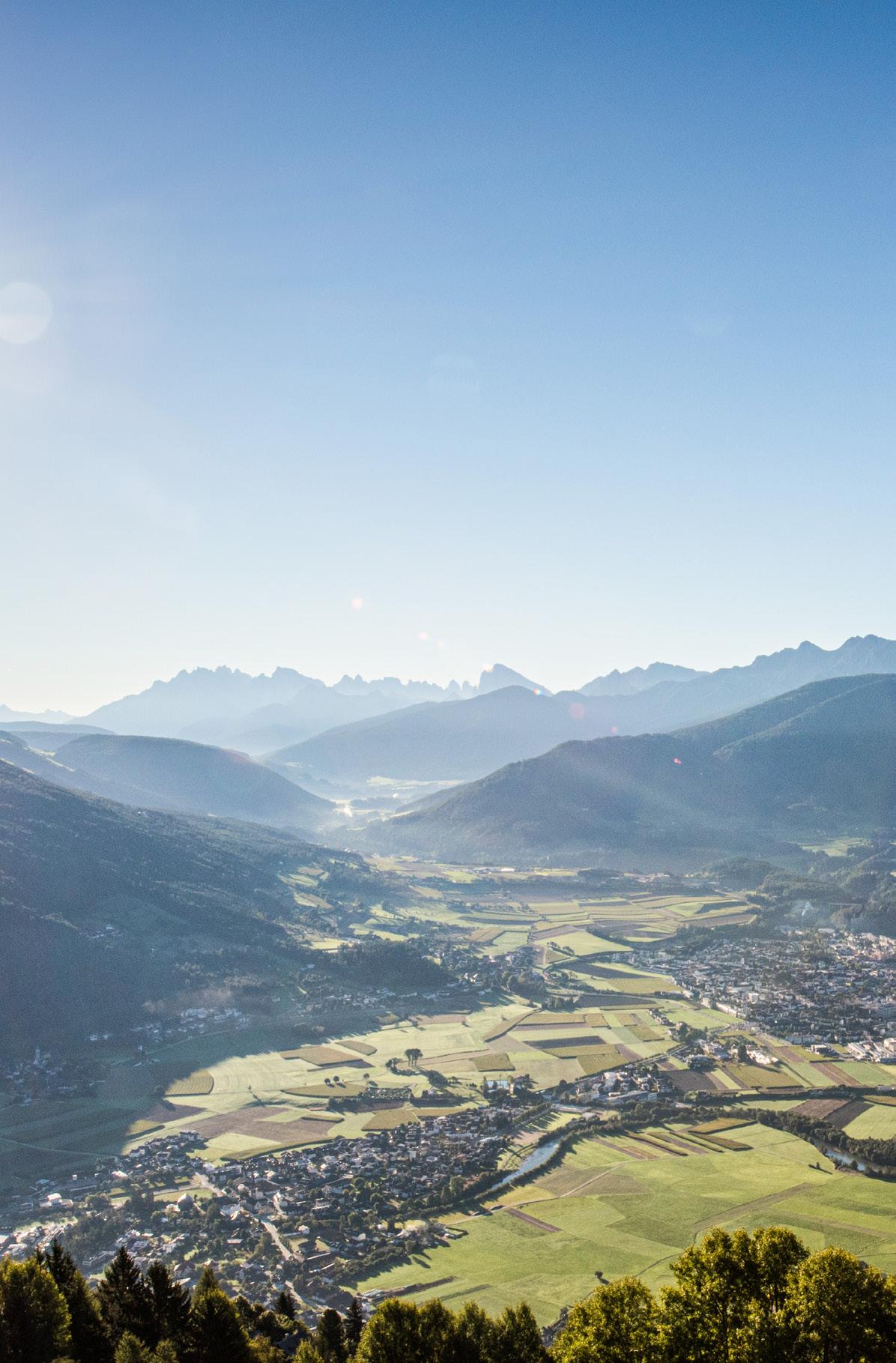
Von oben wirkt die weite Landschaft des Brunecker Beckens wie ein großes, von Künstlerhänden gemaltes Bild.
Dall’alto, i paesaggi dell’ampia conca di Brunico appaiono come un grande quadro dipinto da mani esperte.
From above, the landscapes of the expansive Brunico basin appear as a canvas painted by an old master.

Ob Sport oder Zeitvertreib: Fischen erfordert Geduld, Hingabe und auch etwas Geschick. Das Pustertal ist mit seinen zahlreichen Bächen und Seen reich an malerischen Orten, an denen man nach heimischen Fischarten,
La Val im Gadertal ist das erste Dorf Südtirols, das im Jahr 2015 die Auszeichnung „Europas Wanderdorf“ erhalten hat. Ausgerechnet diese ruhige Ortschaft mit ihren Dolomitenlandschaften und der traditionellen ladinischen Architektur ist Startpunkt für die Teilnehmer des La Sportiva Lavaredo Ultra Trail am 29. Juni. Nach 80 km, 4600 Hm und einer Route durch das Herz des UNESCO-Welterbes erreichen die Läufer schließlich das Zentrum von Cortina D’Ampezzo.
Il paese di La Valle, in Alta Badia, è stato il primo dell’Alto Adige ad aver ricevuto nel 2015 il riconoscimento europeo di “Terra di escursionisti”. Inoltre, proprio da questa tranquilla località, caratterizzata da paesaggi dolomitici e un’architettura tradizionale ladina, il 29 giugno partiranno i partecipanti alla gara La Sportiva Lavaredo Ultra Trail. Dopo 80 km, 4600 m di dislivello
darunter hauptsächlich Forellen, angeln kann. Zu den beliebtesten Gewässern gehören der Toblacher See, der Landrosee sowie die Flüsse Rienz und Ahr. Um in das Angelvergnügen einzutauchen, benötigt man allerdings eine
positivo e un viaggio nel cuore delle vette Patrimonio UNESCO, i corridori raggiungeranno il centro di Cortina d’Ampezzo.
The town of La Valle, in Alta Badia, was the first in South
Lizenz, die in den örtlichen Tourismusbüros erhältlich ist.
Che sia come sport o passatempo, praticato dai grandi o anche dai più piccoli, la pesca richiede pazienza e concentrazione.
Tyrol to receive the European recognition of “Hiking Village” in 2015. In addition, the participants in the La Sportiva Lavaredo Ultra Trail Race will set off on June 29th from this peaceful location, known for its Dolo-
Ricca di torrenti, ruscelli e specchi d’acqua, la Val Pusteria presenta diverse zone suggestive dove poter aspettare che una delle varietà ittiche locali, prevalentemente trote, abbocchi all’amo: tra queste, il Lago di Dobbiaco, quello di Landro, i fiumi Rienza e Aurina. Tuttavia, per poter lanciare la canna è necessario procurarsi la licenza, solitamente disponibile presso gli uffici turistici del posto.
Fishing, whether as a sport or pastime, practiced by adults or even children, requires patience and concentration. The Pusteria Valley has numerous rivers, streams and other bodies of water that offer a host of picturesque locations to fish local species, primarily trout. Notable spots include Lake Dobbiaco, Lake Landro and the Rienza and Aurina rivers. Don’t forget to secure a license, typically available at the local tourist offices. You need one to cast your fishing rod in these waters.
mite landscapes and traditional Ladin architecture. After 80 km, gaining 4,600 m in altitude and journeying into the heart of the UNESCO World Heritage peaks, runners will reach the centre of Cortina d'Ampezzo.

L’unicità di un castello con i suoi segreti
A unique castle filled with secrets
Nach einer Zugfahrt durch das Pustertal erreicht man den Bahnhof Welsberg-Taisten. Schloss Welsperg selbst ist vom Dorf aus kaum sichtbar und man folgt dem Weg am Gsieser Bach entlang oder dem Schlossweg bis zum historischen Bauwerk mit dem fast 40 m hohen Turm. Es ist die älteste Burganlage des Pustertals, die einen dreifachen Einblick in die Geschichte ermöglicht. Einerseits auf eine Adelsfamilie, die bis 1907 fast 800 Jahre das Schloss bewohnte, zum anderen auf eine mittelalterliche Wehranlage, die durch ihren schrittweise gewachsenen Grundriss heute eine architektonische Sonderform aufweist und zu guter Letzt auf die 100.000 Jahre alte Gesteinsablagerung, das „Welsberger Konglomerat“, die das Schloss trägt. Ein Besuch, der sich zusammen mit der Naturlandschaft also vierfach lohnt.
Dopo aver attraversato la Val Pusteria in treno, si giunge alla stazione di Monguelfo-Tesido. Castel Welsperg non è visibile dal paese, perciò dal centro si costeggia il Rio Casies o si segue via Castello per arrivare a intravedere, come primo elemento, la torre di vedetta di 40 m. Si tratta del più antico complesso castellano della valle, che racchiude in sé differenti aspetti storici: quello della famiglia nobile che vi ha vissuto per quasi ottocento anni fino al 1907; il fatto che la fortificazione medievale oggi ha una speciale forma architettonica, grazie alla disposizione gradualmente evoluta; la presenza di una roccia sedimentaria di centomila anni, detta “conglomerato di Monguelfo”, a sostegno della costruzione. Il castello è anche immerso nel verde: dunque, quattro peculiarità con una sola visita.
Following a train journey through the Pusteria Valley, you will reach the Monguelfo-Tesido station. The Monguelfo Castle is barely visible from the village, but simply follow the path along the Casies stream or take the castle path to reach the historic
building with its almost 40 m high tower. It’s the oldest castle complex in the Pusteria Valley and offers a threefold historical insight. A noble family lived there for almost 800 years (until 1907), it’s a mediaeval fortification (which today has a special architectural shape due to its gradually evolving layout); and, last but not least, it stands on a rock deposit: the “Monguelfo Conglomerate”, which is 100,000 years old. Together with the natural landscape, all this makes a visit worthwhile four times over.
18. – 20.05.: 10 a.m. – 2 p.m.
June: every THU, FRI, SAT
10 a.m. – 2 p.m. (except for the choir festival on 15.06.)
01.07. – 01.09.: MON – FRI 10 a.m. – 4 p.m., SUN 2 – 6 p.m., SAT closed
02. – 13.09.: MON – FRI 1.30 – 4 p.m.
19.09. – 31.10.: every THU 1.30 – 4 p.m.
www.schlosswelsperg.com
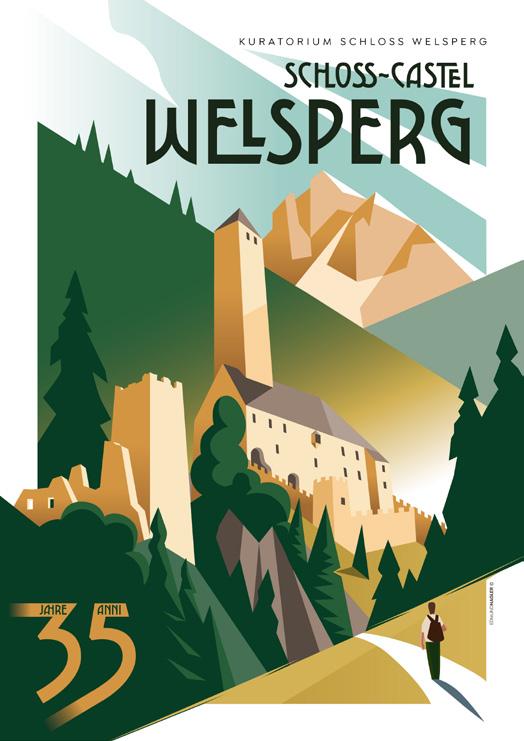
Seit 35 Jahren
kümmert sich das
„Kuratorium Schloss Welsperg“ um dieses wertvolle Baudenkmal.
Da trentacinque
anni l’associazione
“Kuratorium Schloss Welsperg” si occupa di questa dimora storica.
The "Kuratorium Schloss Welsperg" has been looking after this treasured architectural monument for 35 years.


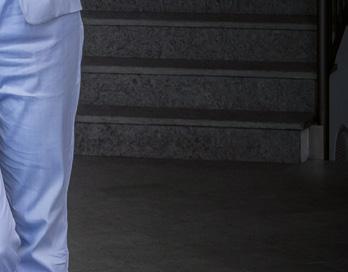



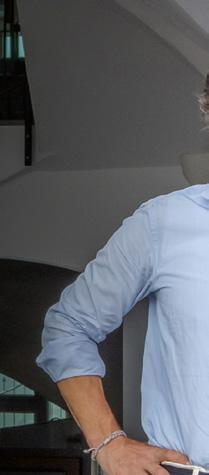



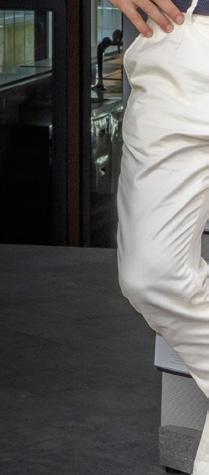



Ob Familienwanderung, Rundweg oder Gipfelbesteigung: Wandern auf der Plose, dem Hausberg von Brixen, ist besonders abwechslungsreich.
Escursioni per famiglie, tour circolari, salite in vetta: la Plose, la montagna di casa di Bressanone, offre itinerari diversi tra loro.
Whether you're looking for a family hike, a circular route or a summit ascent: Hiking on the Plose, Bressanone's home mountain, is particularly varied.

Schon mal auf einen Apfel hinaufgeklettert? Im kleinen Dorf Raas auf dem Hochplateau NatzSchabs, das für den Apfelanbau bekannt ist, steht ein 5 m hoher Holzapfel mit verschiedenen Aufstiegsvarianten und Rutschbah-
Auf zum Mittelpunkt … nein, nicht der Erde, sondern Südtirols! Am 2509 m hohen Villanderer Berg befindet sich das geographische Zentrum der Provinz, gekennzeichnet durch einen Globus aus Granit. Diesen erreichen Sie auf einer 17 km langen Rundwanderung, die Sie auch zur Sarner Scharte sowie zum Totenkirchl und Totensee führt. Trittsicherheit und gute Kondition werden vorausgesetzt, da es u. a. eine kurze, mit Drahtseil gesicherte Passage zu überwinden gilt. Die Belohnung? Ein fantastischer Panoramablick.
Al centro… non della terra, ma dell’Alto Adige! Da un punto di vista geografico, esso si trova a 2509 m di quota sul Monte Villandro ed è indicato da un globo in granito. Può essere raggiunto con un’escursione circolare di 17 km, che conduce alla Forcella Sarentina, al Lago dei Morti e all’omonima chiesetta. È importante avere un passo sicuro e una buona condizione fisica,
nen. Hier finden die Kinder auch Apfelkisten, die mit Balancierbalken zu einer Kletterlandschaft vereint wurden, sowie Schaukeln, Wippen, einen Wasser- und Matschbereich und einiges mehr. Die Holzdecks und die Wiese am
poiché vi è un breve tratto assicurato da una fune metallica da superare. Ma ogni fatica viene ricompensata da un fantastico panorama.
Off to the centre…! No, not of the earth, but of South Tyrol!
Apfelgarten-Spielplatz laden zum gemütlichen Picknicken ein.
Bimbi, avete mai giocato in una mela gigante? Nella frazione di Rasa sull’altopiano di Naz-Sciaves, noto per la coltivazione delle
The geographical centre of the region is located on the 2,509 m high Villandro mountain, and is marked by a granite globe. It can be reached on a 17 km circular hike, which also takes you to the Sarentino ridge, the Chiesetta del Morto and the
mele, ce n’è una speciale: è in legno, alta 5 m e ci si può salire sopra per poi scendere da scivoli di forme diverse. Tutt’intorno vi è un percorso avventura – realizzato con le cassette usate per conservare il frutto – con possibilità di arrampicata, travi di equilibrio, dondoli, altalene, una zona fangosa e tanto altro. La presenza di tavoli in legno e un prato rendono il parco perfetto per un picnic.
Have you ever climbed on top of an apple? In the small village of Rasa on the Naz-Sciaves high plateau, which is famous for its apple orchards, you can. There is a 5 m high wooden apple with various climbing options – as well as different slides. There are also apple boxes combined with balancing beams to create a climbing landscape, swings, seesaws, a water and mud area, and much more for the kids to discover. The wooden decks and the meadow (by the apple orchard playground) are perfect for a cosy picnic.
Lago dei Morti (“Church of the Dead” and “Lake of the Dead”). You will need to be sure-footed and in good physical condition, as there is a short passage secured with a wire rope to conquer. The reward? A spectacular panoramic view.



Duftende Almwiesen, urige Hütten mit Blick auf die Dolomiten und Aperitivo auf der Piazza: In der Ferienregion Klausen Barbian Feldthurns Villanders gibt’s traditionellen Bergsommer und italienisches Flair in einem.
Weinwelt Eisacktal: Lauschige Plätzchen und edle Tropfen.
Per aperitivo, qui, scegliete pregiati vini della Valle Isarco.
The Isarco Valley wine world: cosy corners and fine wines.
beeindruckende Latzfonser Kreuz auf 2311 m ist der höchste Wallfahrtsort Südtirols und nur zu Fuß erreichbar. Die Villanderer Alm lockt mit duftenden Almwiesen und gemütlichen Wanderwegen, gesäumt von traditionellen Almhütten mit Dolomitenblick. Eine Einkehr lohnt sich nicht nur wegen der schmackhaften Gerichte wie Speckknödel oder Kaiserschmarren, sondern auch wegen der Herzlichkeit der Gastwirte. Klausen, das Künstlerstädtchen, verbindet Südtiroler Tradition mit italienischem Lifestyle. Die mittelalterlichen Gassen strahlen ein besonderes Flair aus, das am besten bei einem Aperitivo mit Eisacktaler Weißwein genossen werden kann. Der Sommer in der Ferienregion Klausen Barbian Feldthurns Villanders ist anders: einzigartig und vielseitig!
In Barbian, dem Dorf mit dem schiefen Turm, laden der mystische Ort Dreikirchen und die Barbianer Wasserfälle zu Erkundungen ein. Für Bergliebhaber bieten die aussichtsreichen Almen ideale Wanderziele. Das
Un’escursione con vista Dolomiti, seguita da un immancabile aperitivo: nell’area vacanze tra Chiusa, Barbiano, Velturno e Villandro la tradizione altoatesina incontra alcuni aspetti tipicamente italiani, per un’estate ricca di sfumature uniche. Lo sapevate, ad esempio,

che anche a Barbiano c’è una torre pendente?
Questo paesino affascina inoltre con le sue scrocianti cascate e luoghi mistici come Bagni Tre Chiese. Per gli appassionati di montagna, gli itinerari sono innumerevoli. Una meta suggestiva, raggiungibile solo a piedi, è la chiesetta Croce di Latzfons, che con i suoi 2311 m di quota è considerata il luogo di pellegrinaggio più alto della regione. L’Alpe di Villandro, poi, attrae con pendenze dolci, prati in fiore, caratteristiche malghe e una vista sconfina-
Ein Löffel voll Glück: Genuss fürs Auge und den Gaumen.
Gustatevi sapori freschi e autentici della dolce vita tra le montagne.
A spoonful of happiness: a feast for both the eyes and the palate.

ta sulle vette dolomitiche. Sperimentate la genuina accoglienza sudtirolese fermandovi in uno dei rifugi e assaporate specialità come i canederli allo speck o il Kaiserschmarrn, una frittata dolce servita spezzettata e con marmellata di mirtilli rossi. Infine, potete godervi il fascino medievale di Chiusa, conosciuta come “la città degli artisti”, accomodandovi in piazza con un buon calice di vino bianco della Valle Isarco. Insomma, la vostra estate qui sarà tanto sfaccettata quanto unica!

Ein echter Foto-Spot: die Wallfahrtskirche am Latzfonser Kreuz.
La chiesetta Croce di Latzfons è un suggestivo spot fotografico.
A wonderful photo opt: The pilgrimage church at the Santa Croce di Latzfons.
Fragrant alpine meadows, rustic huts overlooking the Dolomites and aperitifs on the piazza: the holiday region of Chiusa Barbiano Velturno Villandro offers visitors a traditional summer in the mountains and Italian flair all in one. In Barbiano, the village with the leaning tower, you can explore the village of Tre Chiese as well as the Barbiano waterfalls and revel in their mystical atmosphere. For mountain lovers, the panoramic Alpine pastures offer the perfect hiking destinations. The impressive Santa Croce di Latzfons church at 2,311 m above sea level is the highest situated pilgrimage site in South Tyrol and can only be reached on foot. The Villandro Alpine pasture beckons with fragrant meadows and cosy hiking trails, lined with traditional Alpine huts with views of the Dolomites. It's worth stopping for a bite –not only because of the tasty dishes such as Speckknödel (bacon dumplings) or Kaiserschmarren (traditional sweet shredded pancake dish), but also for the hospitality of the hosts. The small artists’ town of Chiusa unites South Tyrolean traditions with the Italian lifestyle. The medieval alleyways exude a special flair that is best enjoyed whilst savouring an aperitivo with white wine from the Isarco Valley. Summer in the Chiusa Barbiano Velturno Villandro holiday region is something else: unique and varied!
www.klausen.it

Von der St.-Jakobs-Kirche, der ältesten Kirche Grödens mit ihren farbenfrohen Fresken, eröffnet sich ein besonders schöner Blick auf den Langkofel.
Dalla chiesetta di San Giacomo, la più antica della Val Gardena e con coloratissimi affreschi, si apre uno degli scorci più suggestivi sul Sassolungo.
One of the most evocative views of Sassolungo opens up from the chapel of San Giacomo, the oldest church in Gardena Valley, which is adorned with colourful frescoes.

Ein meditativer Spaziergang, bei dem man sich Schritt für Schritt auf den eigenen Atem konzentriert, fördert das körperliche und geistige Wohlbefinden – besonders in der friedlichen Natur auf dem „Weg
Möchten Sie die Dolomiten von April bis November mal auf eine etwas andere Art bestaunen? Dann auf zum Golfclub in St. Vigil bei Kastelruth. Der 18-Loch-Platz, der von Landschaftsarchitekten und dem berühmten Golfspieler Jersombeck entworfen wurde, ermöglicht ein technisch-anspruchsvolles Spiel in einer idyllischen Umgebung am Fuße des Schlerns. Mit Wasserhindernissen und Bunkern erstreckt er sich auf 55 ha und überzeugt mit einem exzellenten Routing sowie Loch 15, dem Par3-Loch mit der größten Höhendifferenz Europas.
Un altro modo per godere dello splendore delle Dolomiti da aprile a novembre? Giocando una partita al campo di golf di San Vigilio, presso Castelrotto, ai piedi dell’inconfondibile Sciliar. Progettato con cura da architetti del paesaggio e dal famoso golfista Jersombeck, il
des Dialogs“. Die einfache Wanderung beginnt im Zentrum von St. Ulrich und führt über leichte Serpentinen zum Col de Flam. Von hier gelangen Sie weiter zur malerischen Kirche von St. Jakob, dem Schutzpatron der Wanderer.
campo a 18 buche vanta un alto livello tecnico ed è perfettamente integrato nell’ambiente. Si estende su 55 ha e, tra ostacoli d’acqua e bunker, conquista gli appassionati con un eccellente routing, nonché la sfida della hole 15, uno dei par 3 con il maggior dislivello d’Europa.
Entlang des schattigen Weges laden Sprüche und Zitate zum Nachdenken ein.
La meditazione camminata, a passo lento e concentrati sul proprio respiro, aumenta
Looking for another way to enjoy the Dolomites from April to November? Try playing a round of golf in the village of San Vigilio, near Castelrotto, at the foot of the majestic Sciliar. Designed by landscape architects and the famous golfer Jersombeck, the 18-hole
il benessere psicofisico, ancor più se praticata nella pace della natura lungo la “Via del dialogo”. Si tratta di un facile itinerario che parte dal centro di Ortisei e sale con dolci serpentine al Col de Flam, da dove si può proseguire per la pittoresca chiesetta consacrata a San Giacomo, il patrono degli escursionisti. Lungo il sentiero, piacevolmente ombreggiato, alcune frasi e citazioni invitano alla riflessione.
Walking meditation, at a slow pace and focused on your breathing, increases psychophysical well-being. Even more so if practiced in the silence of nature along the “Dialogue Trail”. This easy itinerary departs from the centre of Ortisei and climbs to Col de Flam with gentle switchbacks. From there, you can continue to the picturesque church consecrated to San Giacomo, the patron saint of hikers. There are phrases and quotes inviting reflection along the pleasantly shaded path.
course is very challenging and seamlessly integrated into the environment. It extends over 55 hectares, has water hazards and bunkers, and is especially noteworthy for the challenging hole 15: it is the par 3 with the greatest elevation difference in Europe.

TRE CIME –ALTA VAL
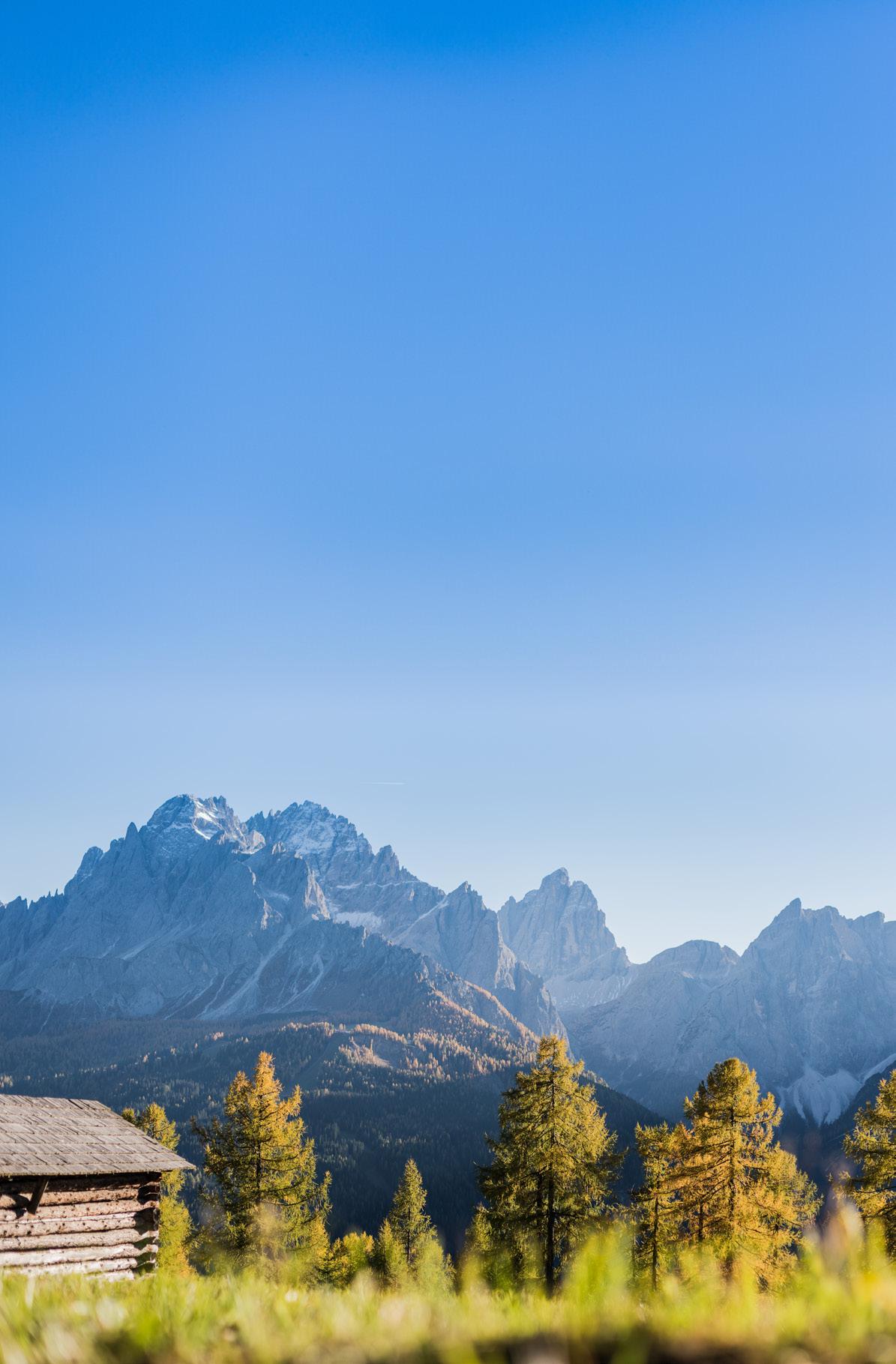
THREE PEAKS –UPPER PUSTERIA VALLEY
Zehner,
“Ten,

Am 28. und 29. September dreht sich in Niederdorf alles um die Kartoffel – oder den Erdapfel, wie man in Südtirol sagt. Neben hausgemachten traditionellen und modernen Gerichten aus dieser für das
115 km, 4000 Hm, drei Tage: Das ist der Stoneman-Dolomiti-Bike-Trail, eine wahre Herausforderung für Mountainbiker. Von Juni bis September können Sie die teils sehr steilen Etappen in Ihrer eigenen Zeit befahren. Zu Beginn erhalten Sie eine Karte mit Höhenprofil, Giveaways sowie ein Armband, mit dem Sie sich an den fünf Checkpoints Stempel holen. Wer die Strecke innerhalb von drei Tagen bewältigt, wird auf der Website der Veranstalter gelistet und je nach gebuchtem Paket mit einer Siegertrophäe belohnt.
115 km e 4000 m di dislivello in massimo tre giorni: ecco in cosa consiste lo Stoneman Dolomiti Bike Trail, una sfida dedicata agli appassionati di mountain bike da affrontare tra giugno e settembre. Alla partenza vengono consegnati una cartina con profilo altimetrico, dei gadget e un braccialetto con il quale ottenere i timbri ai cinque checkpoint lungo
Pustertal besonders wichtigen Knolle finden sich auf den Ständen des Bauernmarkts auch weitere Köstlichkeiten und Südtiroler Handwerksprodukte. Begleitet wird das 13. Niederdorfer Kartoffelfest zudem von
il percorso, a tratti molto ripido. Chiunque riesca nell’impresa, viene nominato sul sito ufficiale e, a seconda del pacchetto scelto, premiato con un trofeo.
115 km, 4,000 m in altitude, three days: this is the Stoneman
verschiedenen Musikgruppen sowie einem abwechslungsreichen Kinderprogramm.
Il 28 e 29 settembre, a Villabassa, si terrà la 13^ edizione dell’originale Sagra della patata,
Dolomiti Bike Trail. In short, a real challenge for mountain bikers. You can cycle the partly very steep stages in your own time from June to September. When you start, you will receive a map with an altitude profile, as well as goodies and a wristband
un ortaggio particolarmente importante in Val Pusteria. Sapevate che in dialetto altoatesino questo tubero viene chiamato Erdapfel, ovvero “mela della terra”? Oltre alle specialità tradizionali o più moderne a base di patate, alla festa si possono trovare anche altri prodotti artigianali, presso il mercato contadino. Fanno da contorno l’esibizione di vari gruppi musicali e un programma per bambini.
Everything in Villabassa will revolve around the potato – or the earth apple, as they say in South Tyrol – on the 28th and 29th of September. In addition to homemade traditional and modern dishes made from this tuber, which is particularly important for the Pusteria Valley, you will also find other delicacies and South Tyrolean artisan products at the stalls of the farmers' market. Various music groups and a diverse children's programme will also accompany the 13th Villabassa Potato Festival.
with which you can collect stamps at the five checkpoints. If you complete the route within three days, you will be listed on the organisers' website and, depending on the package you have booked, rewarded with a winner's trophy.
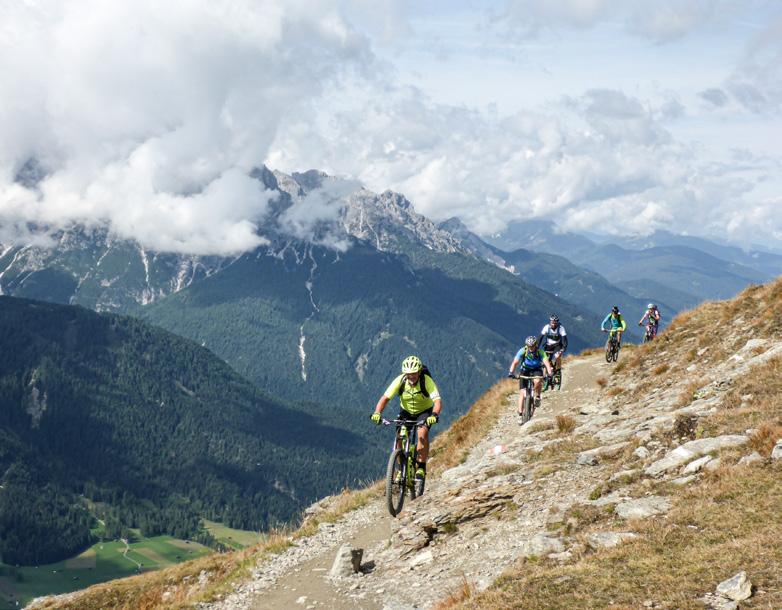

Hoch über den Ortschaften von Ratschings gibt es reine Luft, freie Sicht und Erlebnisse für die ganze Familie.
paesaggi sopra Racines sono un concentrato di aria pura e panorami, che invogliano tutta la famiglia a esplorarli.
High over the villages of Racines you can enjoy clean air, unobstructed views and adventures for the whole family.

Auf zwei Rädern das Wipptal erkunden: Die knapp 3 ½-stündige Tour verläuft vom Sterzinger Bahnhof übers Pfitschertal und die Weiler Flains und Schmuders. Vorbei am Braunhof und der Prantneralm geht es zur Ried-
Seit über 500 Jahren ist das Rathaus in Sterzing nun schon als solches in Gebrauch. Gut erhalten und eifrig gepflegt sieht es heute noch so aus, als wäre es erst kürzlich errichtet worden. Trotzdem versprüht es den mittelalterlichen Charme des Bürgertums und Adels. Mit den Zinnen und Erkern an der Fassade scheint es wie ein Schlösschen. Die Säle im Innenraum vereinen Prunk und volkstümlichen Stubencharakter zu einem stimmigen Gesamtbild. In jedem Fall ein Punkt für die Sightseeing-Liste.
Il municipio di Vipiteno è in uso da oltre cinquecento anni. Si tratta di un palazzo talmente ben conservato e mantenuto, che sembra sia stato costruito di recente, sebbene evochi quel suo fascino borghese e nobiliare tipico del Medioevo. All’esterno, infatti, la merlatura e i bovindi sulla facciata ricordano quasi un piccolo castello; all’interno, invece, le sale fondono armo-
berg- und Platzeralm, bis man schließlich auf etwa 1868 m die Hühnerspielhütte erreicht. Nach einer Stärkung fährt man talwärts nach Gossensaß mit einem kurzen Abstecher ins Pflerschtal. Nach oben Richtung Steckholz führt
niosamente uno stile elegante e tradizionale. Nel complesso, è un’attrazione turistica che merita indubbiamente una visita.
The town hall of Vipiteno has been in use for over
die restliche Strecke über Tschöfs zurück zum Ausgangspunkt.
Alla scoperta dell’Alta Valle Isarco con le due ruote! Partendo dalla stazione ferroviaria di Vipiteno, questo tour di quasi tre ore
500 years. Well preserved and eagerly maintained, it still looks as though it had been built only recently. Nevertheless, it exudes the medieval charm of the bourgeoisie and nobility. It looks like a small castle with its
e mezza passa per la Val di Vizze e le frazioni di Flaines e Smudres. Superate la locanda Braunhof e la Malga Prantner, si pedala verso le baite Riedberg e Platzer fino al Rifugio Cima Gallina, a 1868 m di quota. Dopo una pausa ristoratrice, si scende a Colle Isarco, deviando leggermente per la Val di Fleres. Si risale poi verso Ceppaia e oltre Ceves per tornare al punto di partenza.
Explore the Upper Isarco Valley on two wheels: The almost 3 ½-hour tour runs from the Vipiteno railway station via the Vizze Valley and the hamlets of Flaines and Smudres. Passing the Braunhof farm and the Prantneralm pasture, the route leads to the mountain pastures of Riedberg and Platzeralm before finally reaching the Cima Gallina hut at around 1,868 m above sea level. After a refreshment stop, head downhill to Colle Isarco with a short detour into the Fleres Valley. The rest of the route leads up towards Ceppaia via Ceves and back to the starting point.
battlements and oriel windows on the facade. The halls in the interior combine opulence and traditional parlour character to create a harmonious overall picture. Definitely an item for your sightseeing list.


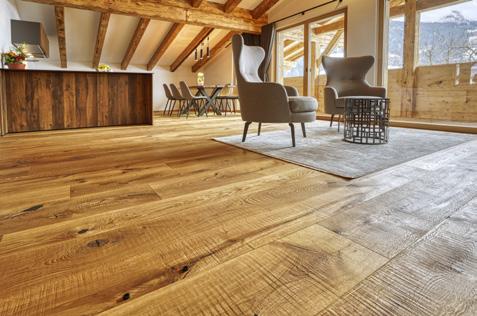
Alpiner Lebensstil, den man schmeckt und fühlt.
Il gusto e l’atmosfera delle montagne altoatesine.
Alpine lifestyle you can feel and taste.

Paul Lobis und Helmuth Gufler, Geschäftsführer von Lobis Böden und Edelschwarz Alpine Bio Spirits.
Paul Lobis e Helmuth Gufler, rispettivamente dirigenti di Lobis Böden e Edelschwarz Alpine Bio Spirits.
Paul Lobis and Helmuth Gufler, managing directors of Lobis Böden and Edelschwarz Alpine Bio Spirits.
Unsere Bergwelt als faszinierende Schatzkammer der Natur bietet sowohl Edelschwarz Alpine Bio Spirits als auch Lobis Böden die richtigen Nährstoffe, um ihre Produkte zu entwickeln. Bei Lobis Böden entstehen aus den imposanten Baumstämmen herausragende Naturholzböden für den Innen- und Außenbereich, die eine perfekte Balance zwischen Eleganz und natürlicher Schönheit bieten. Bei Edelschwarz Alpine Bio Spirits hingegen verleihen Beeren, Kräuter und Getreide den Premiumdestillaten unvergleichlich zarte Aromen. Mit Lobis und Edelschwarz entdecken Sie die Schätze der Natur und erleben ein Schauspiel der Sinne.
Come uno scrigno della natura, i paesaggi montani dell’Alto Adige custodiscono elementi e ingredienti, che consentono a Lobis
e Edelschwarz Alpine Bio Spirits di creare prodotti eccezionali. Nel primo caso, i robusti tronchi degli alberi vengono utilizzati per dare forma a pregiati pavimenti in legno naturale, belli ed eleganti sia negli ambienti interni che esterni. Nel secondo, invece, le bacche, le erbe e i cereali locali conferiscono ai distillati sapori unici e delicati, determinandone l’alta qualità. Con Lobis e Edelschwarz, dunque, è possibile provare i tesori del territorio con tutti i sensi.
Our mountain world is a fascinating treasure trove of nature. It provides both Edelschwarz Alpine Bio Spirits and Lobis Böden with the ideal nutrients to develop their products. Lobis Böden uses the imposing tree trunks to create outstanding natural wooden floors – for indoor and outdoor use – that perfectly balance elegance and genuine beauty. By contrast, Edelschwarz Alpine Bio Spirits uses berries, herbs and cereals to add incomparably delicate flavours to their premium distillates. Discover the treasures of nature with Lobis and Edelschwarz – and experience a spectacle for the senses.
www.edelschwarz.it
www.lobis.biz
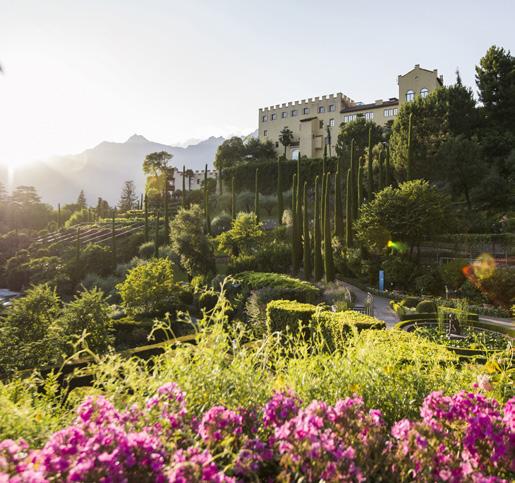




In unserer App steckt alles, was wir wissen und Sie für Ihren Urlaub brauchen: Neuigkeiten, spezielle Angebote, Veranstaltungshinweise und allgemeine Informationen. Zudem haben Sie jederzeit Zugriff auf alle aktuellen Menüs, Weinkarten und vieles mehr.
In der App finden Sie auch viele Empfehlungen von Familie Dobitsch und dem gesamten Castel-Team: schöne Ausflüge, Spaziergänge und Wanderungen sowie Genussrouten mit unserem Audi R8 Cabrio (mietbar ab € 200 am Tag), Restauranttipps und Shoppingmöglichkeiten. Der große Vorteil: Sie haben immer alles dabei und können auch von unterwegs auf alle Inhalte zugreifen und sich sogar ganz bequem via Google-Maps zum jeweiligen Ziel navigieren lassen.
Suchen Sie im App-Store für Apple oder Android einfach nach „Hotel Castel*****“ und laden Sie sich die App gratis herunter. Alternativ scannen Sie einfach den QR-Code mit Ihrer Kamera.

